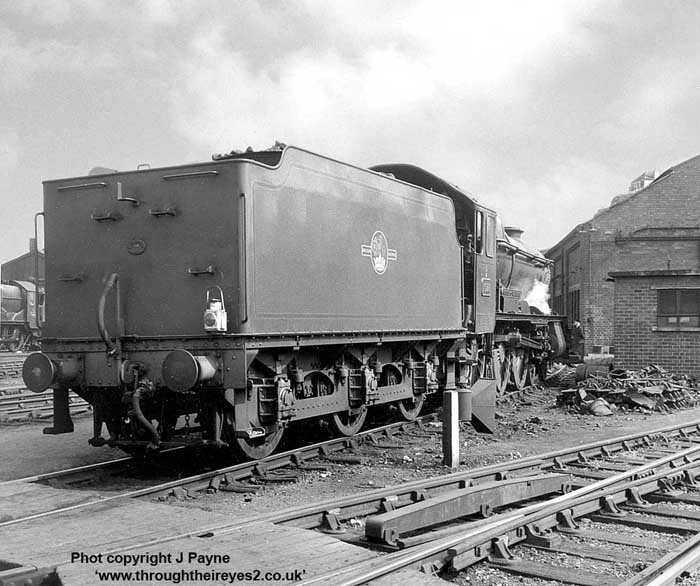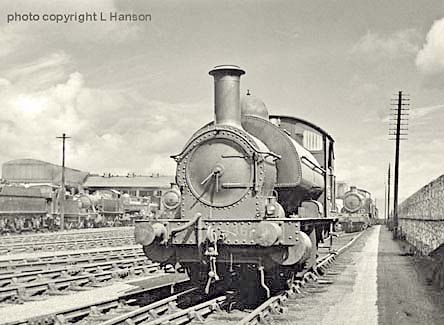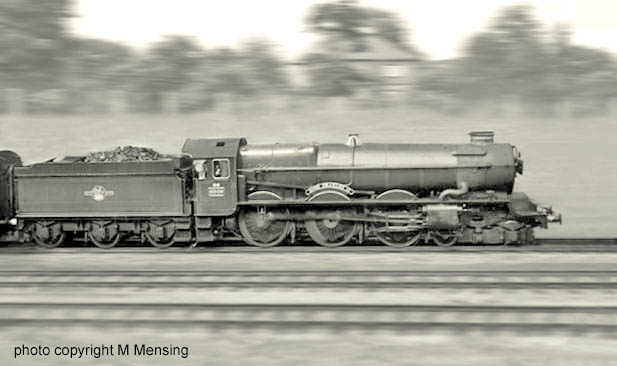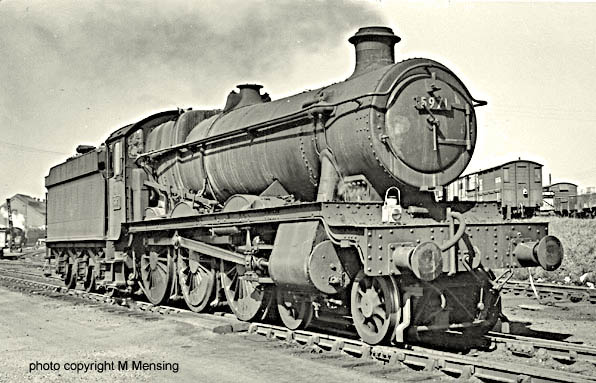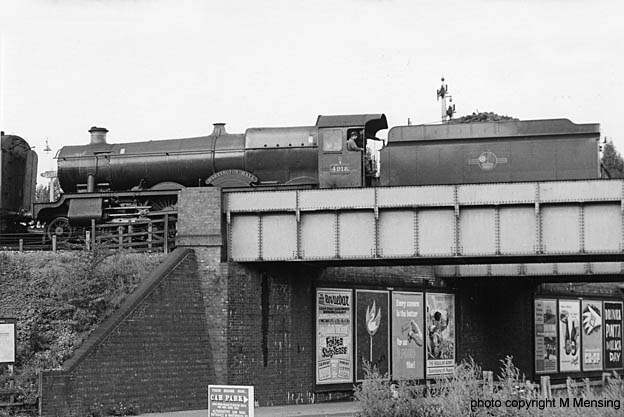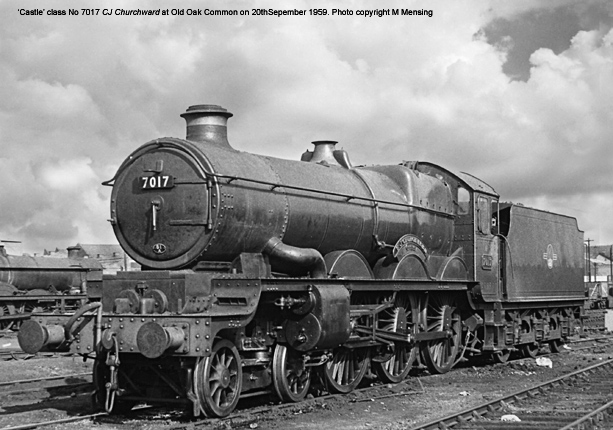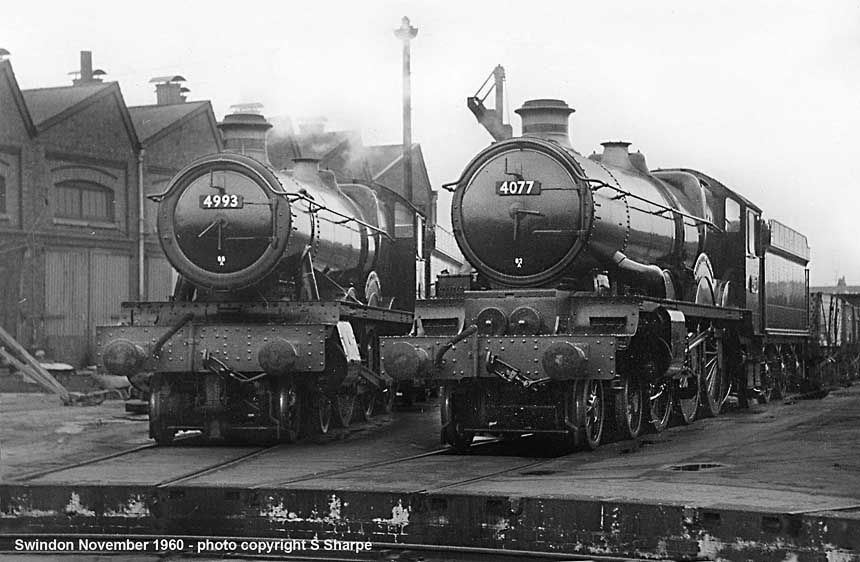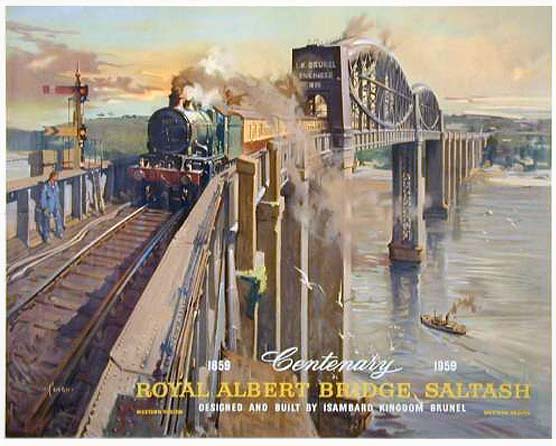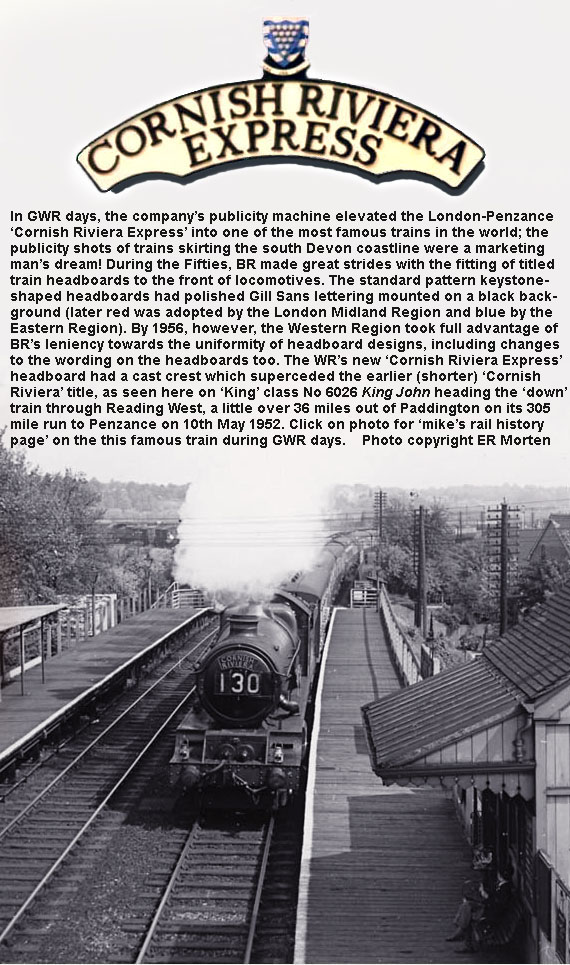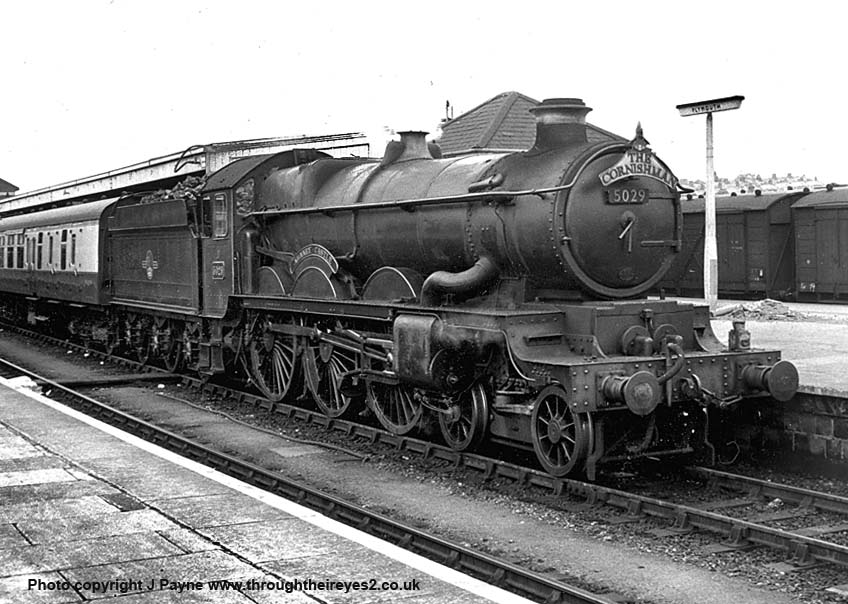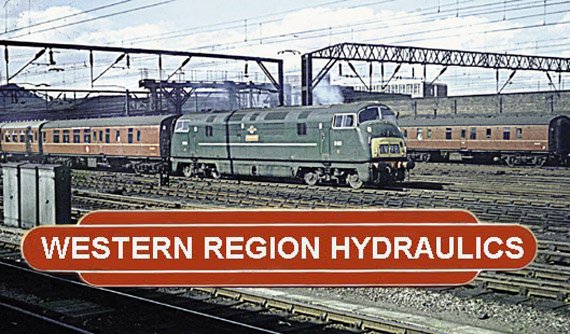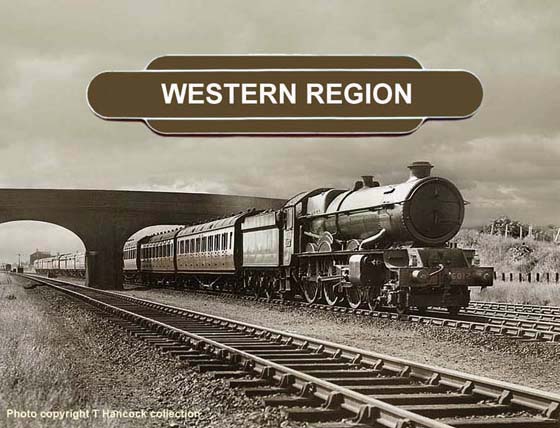
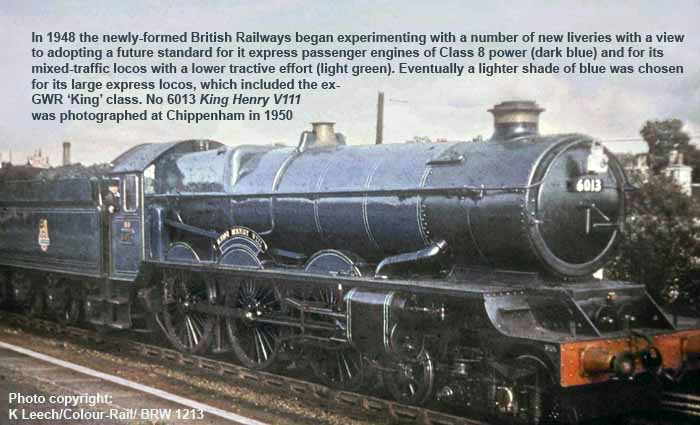
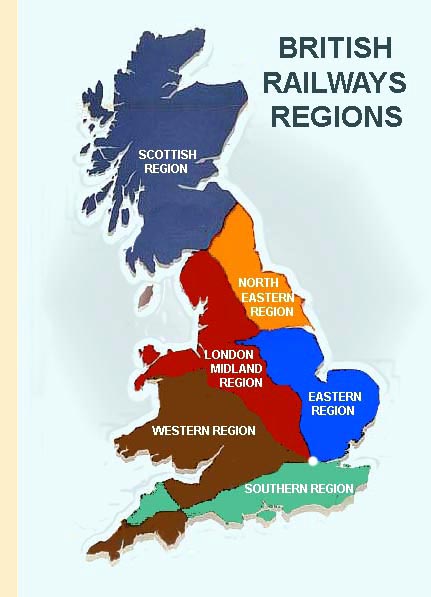 On January 1st 1948, the former 'Big Four' railway companies: London North Eastern Railway (LNER); London Midland & Scottish Railway (LMSR); Great Western Railway (GWR) and Southern Railway (SR) were amalgamated to form the new British Railways. A total of 20,211 steam locomotives were taken into State ownership consisting of: 1,838 from the SR, 3,856 from the GWR, 6,525 from the LNER, and 7,805 from the LMSR. The rest was made up of service engines and Departmental locomotives. At the same time six new BR Regions were formed, their new boundaries corresponding closely to the lines of the former 'Big Four' railway companies. Britain's railways was now made up of the Western Region, Southern Region, Scottish Region, Eastern Region, North Eastern Region and London Midland Region - the old LNER being divided amongst the two newly-formed Regions - Eastern and North Eastern, whilst the Scottish Region was composed partly of the former LMS and LNER.
On January 1st 1948, the former 'Big Four' railway companies: London North Eastern Railway (LNER); London Midland & Scottish Railway (LMSR); Great Western Railway (GWR) and Southern Railway (SR) were amalgamated to form the new British Railways. A total of 20,211 steam locomotives were taken into State ownership consisting of: 1,838 from the SR, 3,856 from the GWR, 6,525 from the LNER, and 7,805 from the LMSR. The rest was made up of service engines and Departmental locomotives. At the same time six new BR Regions were formed, their new boundaries corresponding closely to the lines of the former 'Big Four' railway companies. Britain's railways was now made up of the Western Region, Southern Region, Scottish Region, Eastern Region, North Eastern Region and London Midland Region - the old LNER being divided amongst the two newly-formed Regions - Eastern and North Eastern, whilst the Scottish Region was composed partly of the former LMS and LNER.
(Below) A poignant view by former railwayman, Dave Salmon, of ex-GWR and ex-LMR locos plus a BR Standard Class 4MT in residence at Oxford shed (81F). 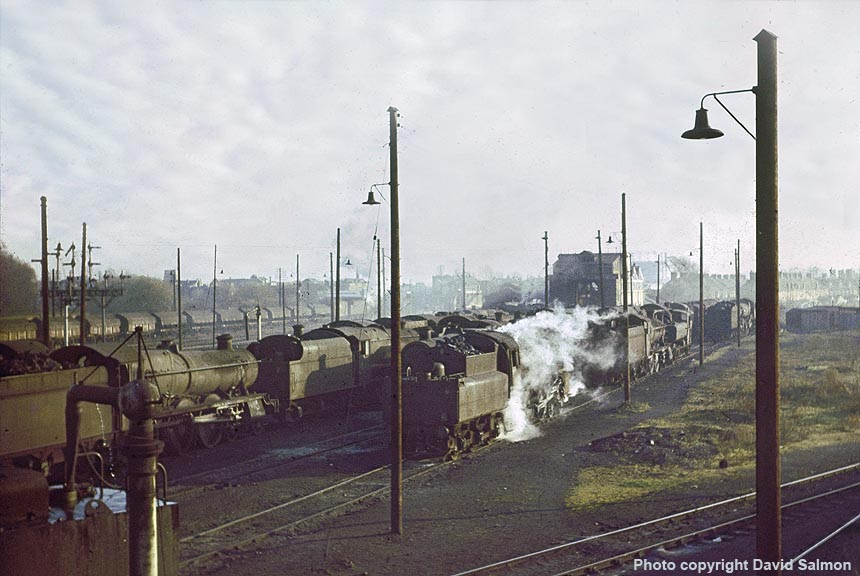
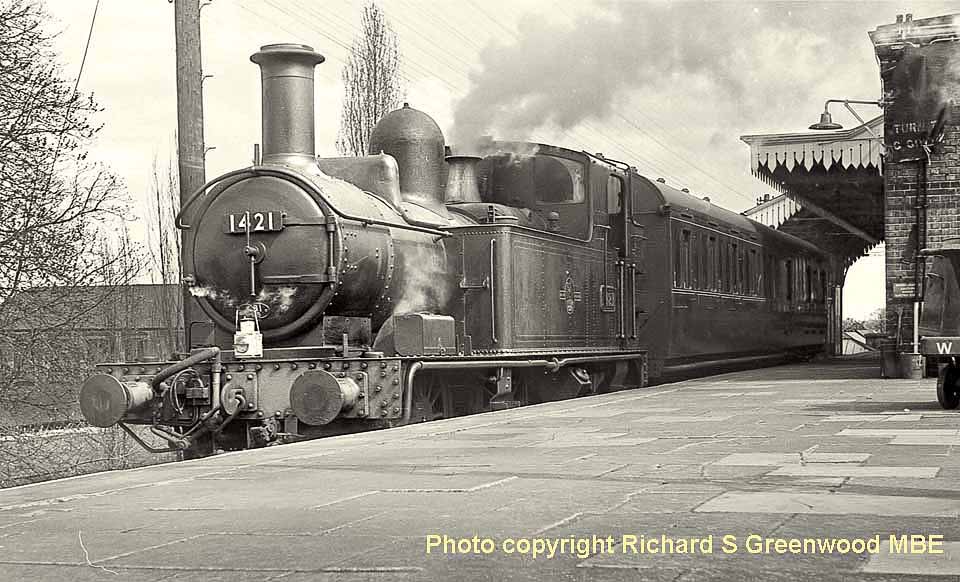
(Above-Below) During his photographic reconnaissances in the south of England in 1962, Richard Greenwood caught a train from Paddington to Reading on 14th April and when it stopped at Maidenhead he was most surprised to see one of Collett's 0-4-2Ts No 1421 standing in the bay platform awaiting departure with a one-coach auto train for Marlow. He just had to investigate! After photographing the train (above) he clambered aboard and following arrival at the terminus, took several shots of the locomotive, including this one (below) in what he describes as a 'picture postcard' branch line setting now long since gone. Indeed Richard arrived in the nick of time...within a few short months (July 1962) steam was replaced by diesel multiple units, the service was gradually cut back and by 1969 Marlow station had been demolished and replaced by a smaller station on the site of the former goods yard. Finally, in May 1970 the stretch of line from Bourne End to High Wycombe was closed after the Ministry of Transport refused to include it on the list of routes to receive Grant Aid funding (precursor of the 1974 Public Service Obligation grant system) which provided subsidies for loss-making but 'socially necessary' lines. Richard's superb colour shots of the 0-4-2T at Marlow can be found on his 'Down South in Colour' Page 87 HERE…highly recommended.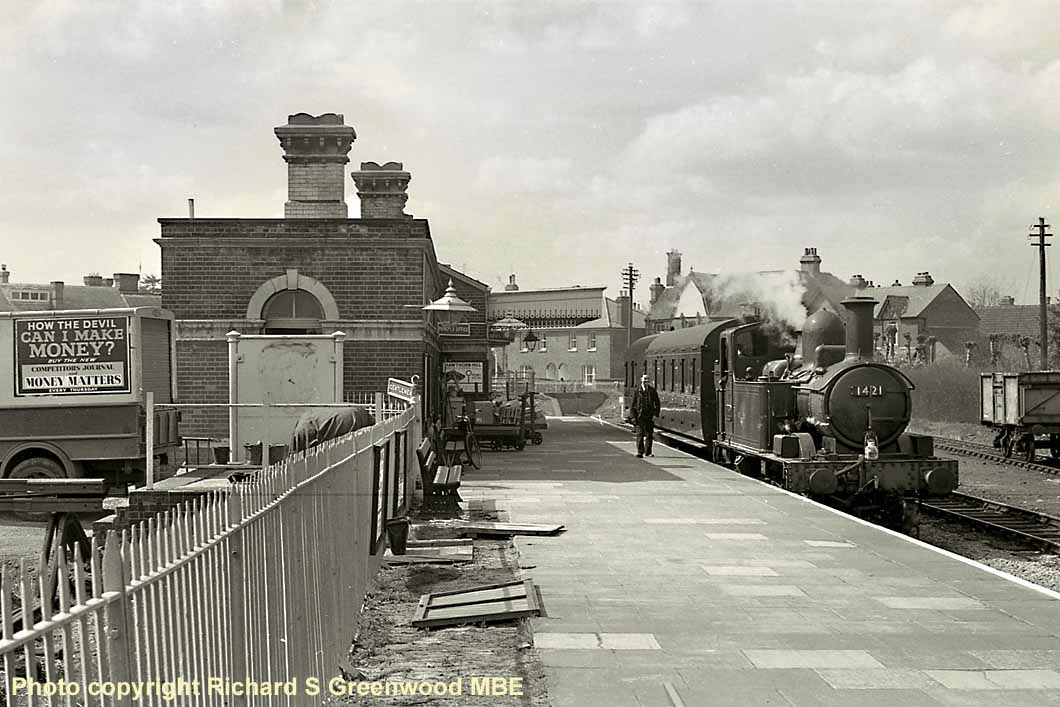
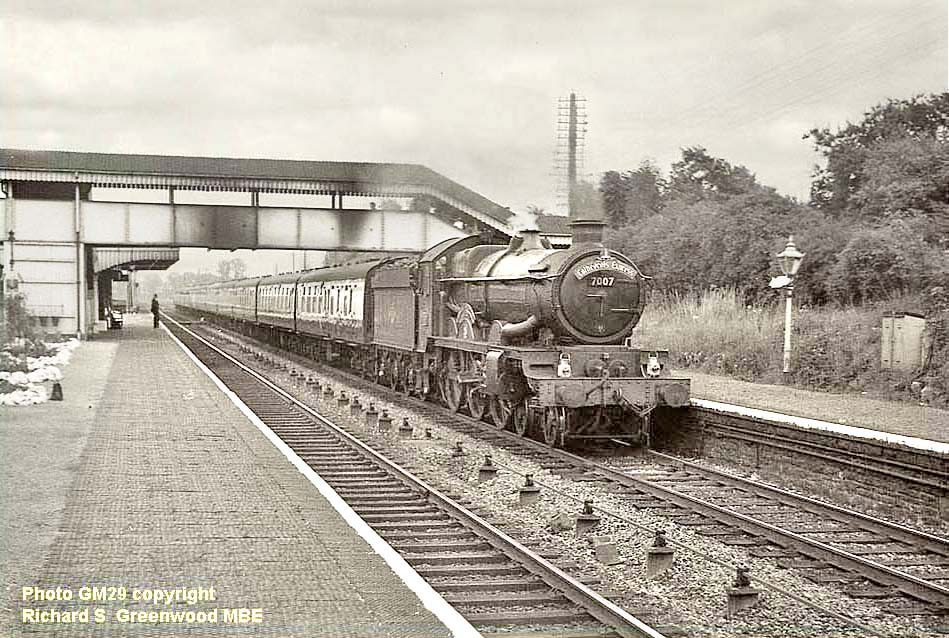
(Above-Insert-Below) During steam days, the 'Cathedrals Express' was hauled by both Worcester and Old Oak 'Castles' between Paddington and Oxford, Worcester and Hereford. The titled train first appeared in the Western Region timetable on 16th September 1957, departing Hereford at 06.43 and returning at 18.22 from Paddington. Here 'Castle' class No 7007 Great Western heads the down 'Cathedrals Express' through Tilehurst on 29th July 1961. (Inset) A nameplate from 7007 went under the hammer at a recent Great Central 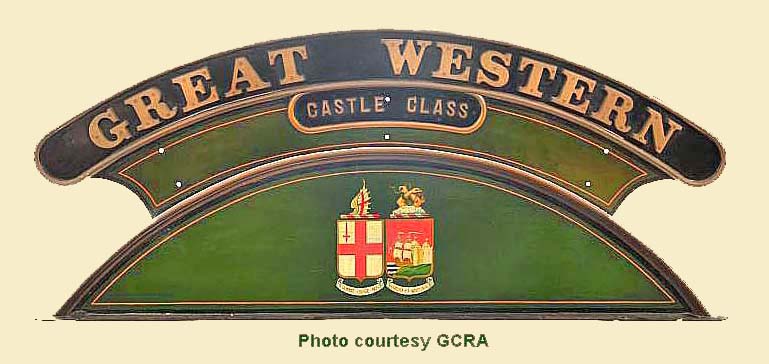 Railwayana Auction. Originally named Ogmore Castle, No 7007 was the last of the Castles built by the GWR at Swindon in July 1946, therefore it was an appropriate choice of loco for renaming (to commemorate the passing of the old GWR) when BR's Western Region was formed in January 1948. Allocated initially to Stafford Road, then Old Oak Common, 7007 moved to Worcester in February 1950 where it remained until withdrawal during the week ending 16th February 1963. It was sold for scrap to Cashmores at Great Bridge in December 1963. Added to the splasher beneath the nameplate of 7007, was the coats of arms of the cities of London and Bristol (linked in the arms of Great Western Railway) as a reminder of the committees in both cities responsible for founding the company. The GCRA image shows the nameplate displayed on an original Castle Class splasher, with the GWR coat of arms added. This Lot was accompanied by a considerable volume of correspondence between the late owner and Swindon Works regarding the purchase of the nameplate and the splasher. (Below) This Barry Hilton photograph shows 7007 heading the 'Cathedrals Express' through Reading on 24th April 1962.
Railwayana Auction. Originally named Ogmore Castle, No 7007 was the last of the Castles built by the GWR at Swindon in July 1946, therefore it was an appropriate choice of loco for renaming (to commemorate the passing of the old GWR) when BR's Western Region was formed in January 1948. Allocated initially to Stafford Road, then Old Oak Common, 7007 moved to Worcester in February 1950 where it remained until withdrawal during the week ending 16th February 1963. It was sold for scrap to Cashmores at Great Bridge in December 1963. Added to the splasher beneath the nameplate of 7007, was the coats of arms of the cities of London and Bristol (linked in the arms of Great Western Railway) as a reminder of the committees in both cities responsible for founding the company. The GCRA image shows the nameplate displayed on an original Castle Class splasher, with the GWR coat of arms added. This Lot was accompanied by a considerable volume of correspondence between the late owner and Swindon Works regarding the purchase of the nameplate and the splasher. (Below) This Barry Hilton photograph shows 7007 heading the 'Cathedrals Express' through Reading on 24th April 1962.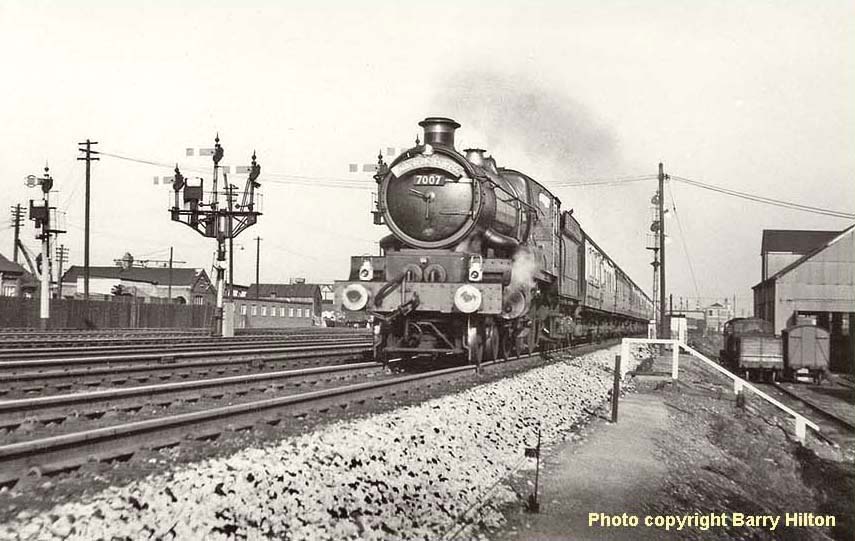
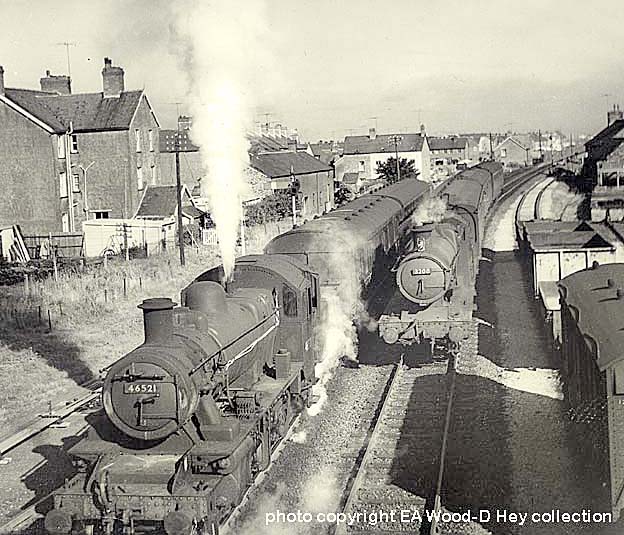
(Above-Below) Over the years, the Regional boundaries diminished significantly as many locomotives (from an operational standpoint) worked beyond their arbitrary Regions, so in many ways it is meaningless to classify any particular class of locomotive as belonging to any one of the six Regions during the transition from steam. For example, it was not unusual to find LMS Ivatt Moguls working alongside more traditional ex-GWR engines at places like Barmouth (above) situated well outside the Region they were initially allocated. (Below) Ex-LMS Class 8F trundles a mixed freight through the WR's station at Birmingham Snow Hill.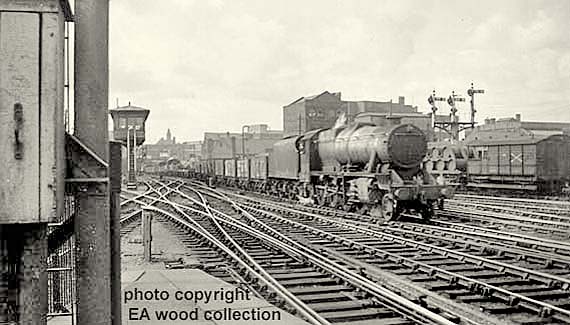
 From 1948, steam locomotives were carrying their new BR numbers with the exception of the Great Western engines which retained their brass and cast iron cabside number plates below 10,000. The Southern engines were numbered in the 30,000s, the LMSR in the 40,000s and 50,000s, and the LNER engines appeared in the 60,000s. The new renumbering scheme also embraced a small number of diesel locomotives (mostly 0-6-0 shunters belonging to the former LMSR and LNER) which were allocated the numbered series in the 10,000s, while a small quantity of electric and gas turbine locomotives appeared in the 20,000s. Finally, the batch of WD 'Austerity' freight locomotives, built to Ministry of Supply design, and working on loan at the time of nationalisation, were purchased by BR in early 1949 and renumbered in the 90,000s..
From 1948, steam locomotives were carrying their new BR numbers with the exception of the Great Western engines which retained their brass and cast iron cabside number plates below 10,000. The Southern engines were numbered in the 30,000s, the LMSR in the 40,000s and 50,000s, and the LNER engines appeared in the 60,000s. The new renumbering scheme also embraced a small number of diesel locomotives (mostly 0-6-0 shunters belonging to the former LMSR and LNER) which were allocated the numbered series in the 10,000s, while a small quantity of electric and gas turbine locomotives appeared in the 20,000s. Finally, the batch of WD 'Austerity' freight locomotives, built to Ministry of Supply design, and working on loan at the time of nationalisation, were purchased by BR in early 1949 and renumbered in the 90,000s..
(Right) GWR locomotive nameplate 'Earl Bathurst' together with a matching cabside numberplate, went under the hammer at a Sheffield Railwayana Auction for £11,000. Built at Swindon in May 1930, the GWR 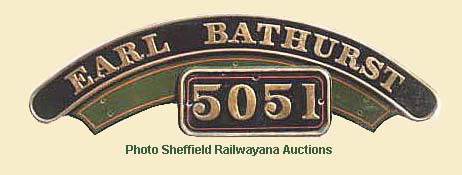 4-6-0 'Castle Class' No 5051 was initially named 'Drysllwyn Castle but later renamed 'Earl Bathurst' in 1937. The loco spent a good many years based at Landore 87E in South Wales, followed by a brief spell at Neath and finally Llanelly from where it was withdrawn in May 1963 and despatched to meet its fate at Woodham Bros, Barry in October 1963. However, scrapping did not take place and the loco was bought by Great Western Society members at Didcot for preservation. It left Barry in February 1970 (the fourth loco to be saved there) and was restored at Didcot. Following preservation, the loco can now be found at the Tyseley Railway Museum, Birmingham.
4-6-0 'Castle Class' No 5051 was initially named 'Drysllwyn Castle but later renamed 'Earl Bathurst' in 1937. The loco spent a good many years based at Landore 87E in South Wales, followed by a brief spell at Neath and finally Llanelly from where it was withdrawn in May 1963 and despatched to meet its fate at Woodham Bros, Barry in October 1963. However, scrapping did not take place and the loco was bought by Great Western Society members at Didcot for preservation. It left Barry in February 1970 (the fourth loco to be saved there) and was restored at Didcot. Following preservation, the loco can now be found at the Tyseley Railway Museum, Birmingham. 
Above) This locomotive nameplate 'Littleton Hall' (stamped 'L' on the back indicating the left hand plate) together with a matching cabside number plate, as carried by ex-GWR 4-6-0 4900 'Hall' Class loco 4939, was sold for £6,000 at Sheffield Railwayana Auctions in December 2009. Built at Swindon in July 1929 the loco was withdrawn from Didcot in February 1963.
(Above) The GWR used a bold serif typeface for their many named express engines from 1900, a version of 'Clarendon Bold' font developed at Swindon Works in their Brass Shop. The cabside numerals were formed 5¾ inches high, were hollow brass figures and tapered towards the observer. This extended numberplate has been cobbled together from several individual plates in Adobe Photoshop, and highlights the extensions of many of the figures, some in the form of appendages, a typography developed and expertly crafted by our Victorian counterparts.
4-4-2 No 102 LA FRANCE.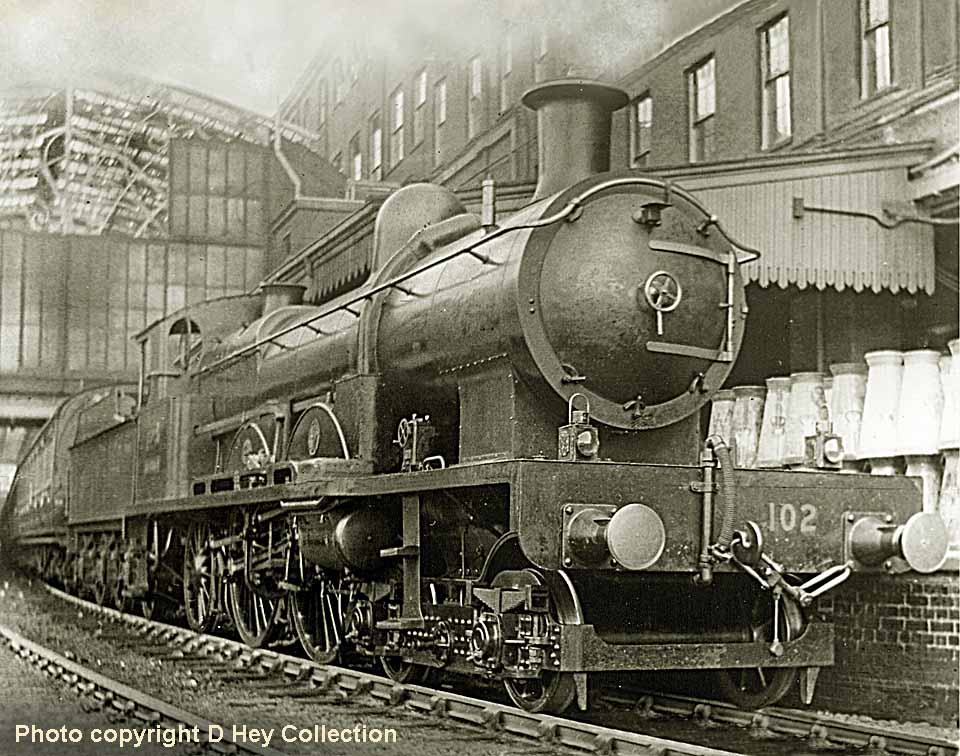
(Above) When George Jackson Churchward succeeded William Dean as CME of the GWR in 1902, he set about the task of building a locomotive capable of tackling the severe gradients of the South Devon banks. Churchward was impressed by the performance of the de Glehn Compounds running on the Nord Railway in France, and this led to the GWR's acquisition of a single 4-4-2 locomotive built by Société Alsacienne de Constructions Mécaniques in 1903. Numbered 102 and named 'La France' the locomotive had two high pressure cylinders fitted between the frames and two low pressure cylinders outside; the high pressure cylinders drove the front driving wheels while the low pressure cylinders drove the rear driving wheels. Whilst evaluating the engine in normal service conditions, La France was put to work on important expresses turn and turn about with William Dean's earlier GWR 4-4-0 'City' and 'Atbara' classes; No 102 hauled the inaugural down Cornish Riviera Express from Paddington on 1 July 1904, and this non-stop run from Paddington to Plymouth became a regular turn for the engine. In 1913 a top feed and new steam pipes were fitted, and then in 1916 the boiler was replaced by a GWR standard No 1 boiler. By 1926, along with two other French locomotives - Nos 103 President and 104 Alliance - No 102 was based at Oxford shed, and whilst the locomotive did not provide any significant improvement in either performance or economy, it did leave a lasting legacy on British steam locomotive design; as Churchward adopted the De Glehn leading bogie design and the divided drive, whereby the inside cylinders powered the first axle and the outside ones did likewise for the middle axle as on the famous 'Star' class. La France was withdrawn in October 1926 having achieved 728,031 miles. My thanks to Derek Dean for the additional information...
GWR COALING STAGES
byDerk Dean  Following the interest shown in my earlier in-depth study of the BR Standard Class 7MT 'Britannia' pages 90-92 (see left-hand menu) we now turn our attention to GWR Coaling Stages. I imagine this will be of particular interest to railway modellers, therefore this tongue-in-cheek cartoon (right) features the GWR Coaling Stage Kit 31635 produced by Osborns Models, similar to the working coaling stage at Didcot Railway Centre. Established in 1992, Osborns Models is a family-run business based in Bideford, North Devon; today it has grown into one of the best stockists of N gauge items in the UK. Click HERE to visit the website.
Following the interest shown in my earlier in-depth study of the BR Standard Class 7MT 'Britannia' pages 90-92 (see left-hand menu) we now turn our attention to GWR Coaling Stages. I imagine this will be of particular interest to railway modellers, therefore this tongue-in-cheek cartoon (right) features the GWR Coaling Stage Kit 31635 produced by Osborns Models, similar to the working coaling stage at Didcot Railway Centre. Established in 1992, Osborns Models is a family-run business based in Bideford, North Devon; today it has grown into one of the best stockists of N gauge items in the UK. Click HERE to visit the website.
OLD OAK COMMON COALING STAGE 81A
The main instigator of all things good about the Great Western Railway was George Jackson Churchward, a man recognised as the greatest railway engineer of all time. His main focus was the construction of locomotives, but he also had important ideas for carriages and helped develop the complex Motive Power Depot at Old Oak Common. After much work was done in 1906 to level large expanses of land, a start was made on construction of the depot with completion by March 1908. 
The largest depot on the GWR system also had the biggest coaling stage measuring 104ft long by 59½ ft wide, surmounted by four large water tanks capable of holding 29,000 gallons of water. The coaling stage was equipped with four double tips plus two single tips which were equally divided between the two sides. Two elevated roads approached on an incline of 1 in 50 and the exit roads were supported on twelve brick arches set at a lesser 1 in 80 angle. It was noted that electricity was used across the entire site from the outset.
This was a truly magnificent structure that was always kept busy by the depot's large allocation of locomotives, many passenger types using the south side, while freight and tank engines were generally obliged to feed off the north side serving a lesser grade of coal.
1926 - The original official photograph (1908) did not reflect any lamps over the tipping outlets, but I am confident in saying that they would have been fitted soon afterwards; suspended on a six foot long conduit with industrial 'coolie-type' shades, supported by wires from the upper brickwork.
1930 - In a vain attempt to redress the problem of spent ash in the area of the coaling stage, a 'contraption' was fitted to remove the ash directly into an open wagon. The mechanism resembled a see-saw, was easily manoeuvred about its fixed axis and maybe this was its downfall, as it did not survive for very long. 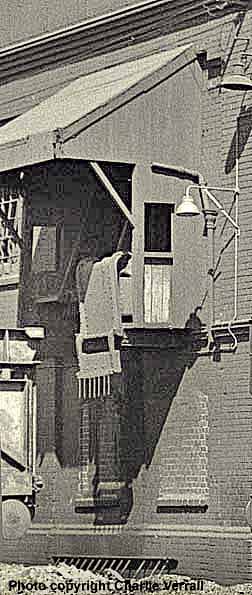 1935 - Looking at two images from the period it was noticed that the single tip on the south side of the stage was out of commission and many of the upper floor window panes were broken, also the original wooden steps were still prominent, made entirely of wood and assembled in an inverted 'L' shape. Also of note was GJ Churchward 'County Tank' No 2243, which was withdrawn in December 1934, but used as stationary boiler at Old Oak depot for nearly five years.
1935 - Looking at two images from the period it was noticed that the single tip on the south side of the stage was out of commission and many of the upper floor window panes were broken, also the original wooden steps were still prominent, made entirely of wood and assembled in an inverted 'L' shape. Also of note was GJ Churchward 'County Tank' No 2243, which was withdrawn in December 1934, but used as stationary boiler at Old Oak depot for nearly five years.
1942 - Improvements to the facility included two ash shelters, constructed with metal stanchions and trusses that were supported by 4ft brick walls, integrated with the soil banks of the elevated coal delivery road and completed with asbestos panels. The covers measured 100ft long by 31ft wide and safeguarded the crews from the Luftwaffe when removing hot ashes from their locomotives. Also the tip shelters were renewed and improved, having larger slanting roofs, better lighting, guttering and drain piping, although the latter was seen to be short-lived and simply abandoned, with sections missing completely.
1946 - The wooden steps to the rear of the coaling stage were seen to be upgraded to concrete posts with substantial metal handrails.1948 - Ash shelters still intact, but beginning to look in dire need of repairs or dismantling.
1950 - Number of panels missing from ash shelters, but roof still in good order.
1952 - Mobile cranes were utilised around this time to clear the backlog of spent ash adjacent to the coaling-line and this led to the roofs being removed from the ash shelters.
1954 - Repairs to the internal floor of the most westerly water tank were seen to be ongoing, while new high-density spotlights were fitted to both sides of the stage.
1958 - Now seen at both ends of the structure were twin spotlights positioned over the delivery and exit roads, meaning that the 'DO NOT PASS SIGN' was moved to the right-hand side. Small 'chequered' warning signs were added on each side, to indicate power switches were close by.
1962 - A major feature of the images from this year was the recent introduction of new lighting, possibly from late 1961, bettering any previous equipment of which there were many types, sizes and positions, although for the majority it was only to be seen to the south side of the stage, thus aiding the servicing of the express passenger types which were accorded far more importance than the ubiquitous tank engines, though they numbered about one third of the total allocation. Despite the wholly run-down and generally forsaken state of the dilapidated coaling stage, the additional lighting made something of a mockery of the (health and safety?) decision to fit added illumination at such a late stage. It was also noted that no glass remained in the upper windows; no drain-piping was to be seen, although the lofty spotlights were still in position, ready to augment the new lamps.
1963 - The tipping platform at the right of the south side was seen to be broken in as much as the section of floor that retained the metal platform had collapsed and allowed it to come adrift. It is doubtful that it was repaired and put back to working order. 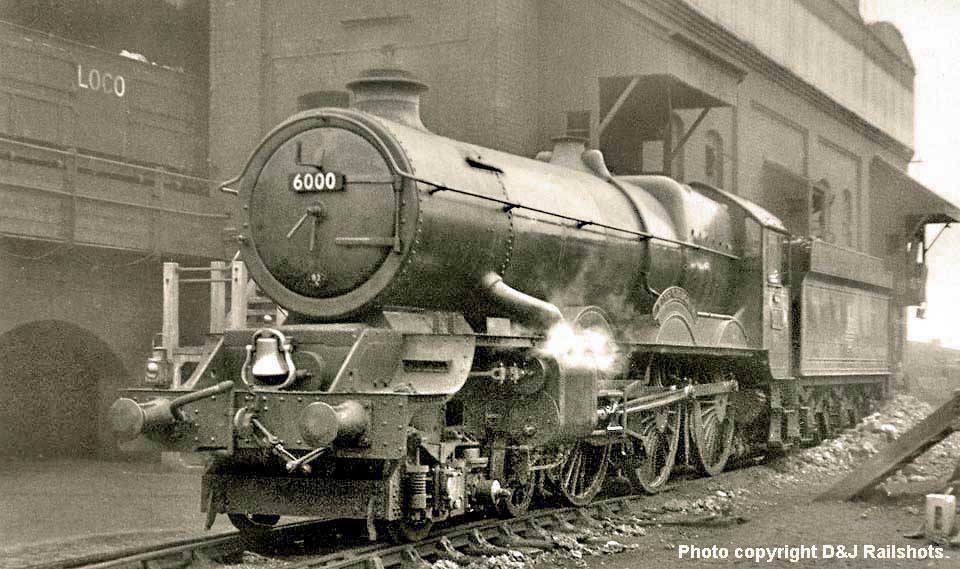
(Above) The doyen of the 'King' class, No 6000 King George V, was photographed at Old Oak Common (81A) on an unknown date, however the locomotive's livery is 'Caledonian Blue' so it was taken after June 1949. The blue livery was the second choice after 'Ultramarine' which was applied to only four 'Kings' but as it weathered very poorly, it lasted only seventeen months on 6026 'King John' before the second blue livery was used. The blue livery was finished off with white lining as seen on the now-preserved 6023.
Completed at the end of June 1927, No 6000 was soon shipped to the USA to feature in the Baltimore & 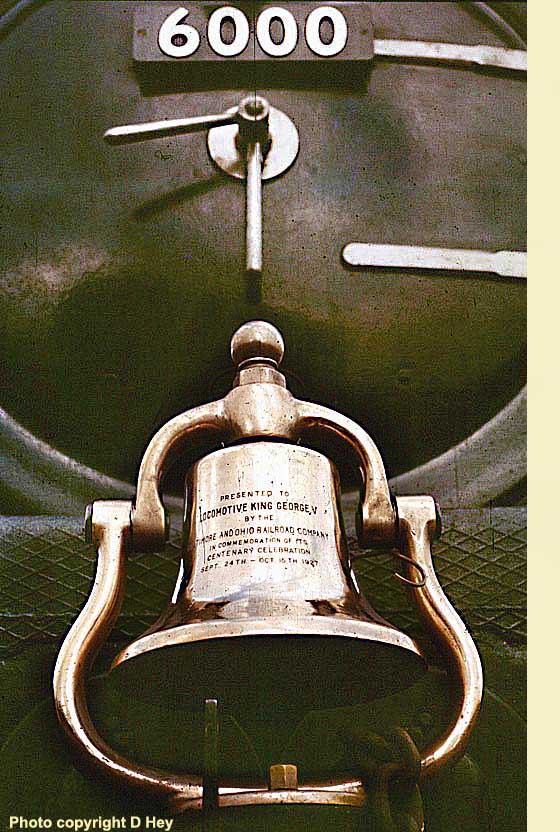 Ohio Railroad's centenary celebrations event, an agreement being made by Sir Felix Pole (GWR General Manager) as early as 1925. The brass bell was thus presented to the GWR to mark the occasion, and was affixed on the frontplate over in America on the first run in Halethorpe, Maryland.
Ohio Railroad's centenary celebrations event, an agreement being made by Sir Felix Pole (GWR General Manager) as early as 1925. The brass bell was thus presented to the GWR to mark the occasion, and was affixed on the frontplate over in America on the first run in Halethorpe, Maryland.
No 6000's shed allocations began at Old Oak, as many 'Kings' did, followed by spells at Exeter (three times), Plymouth Laira (twice), then Bristol Bath Road (82A) and, in October of 1952, a return to Old Oak, to complete 'his' days in service, before withdrawal in December, 1962 and subsequent selection for the National Railway Collection, but it was bought by Bulmer's instead.
The locomotive had completed 1 million miles in service by August, 1944, and was recorded as having a final mileage of 1,910,424. Little had changed mechanically for any of the 'Kings' by this date, but the prevalence of poorer quality coal during the post-war years resulted in poorer steaming capabilities, and from 1948 WB Boilers were being developed, which gave 4-row superheating and an ability to steam well with inferior quality coal. 6000 received a new WB Boiler in April of 1952, along with a return to a Brunswick Green livery, as did the whole of the class in and around this time. The front middle lamp iron sited in front of the bell was angled forwards to give clearance so that the bell was not being constantly rubbed in daily usage. On the cab above the number plate can be seen 2 round 'discs' these being replicas of the original medallions as presented to Sir William Stanier, who was Assistant to Charles Collett and who represented the GWR, whilst the engine was over in America. The original medallions were said to be sited in the cab, to avoid risk of being stolen.
As for Old Oak Common's coal stage shelters? These are seen yo be in good order, primarily because they had been renewed and enlarged during the early 1940s in order to give better protection to those tipping the coal. The shed buildings are behind the photographer, and the locomotive is stationed at the southwest corner of the coaling stage in position to reverse down to Paddington for its next duty, being allocated to Bristol Bath Road shed at this time. The coaling stage was much the same on the north side, but the tips were discharging lesser quality coal for use on freight turns and shunting locomotives, of which there were many in use for Paddington trains.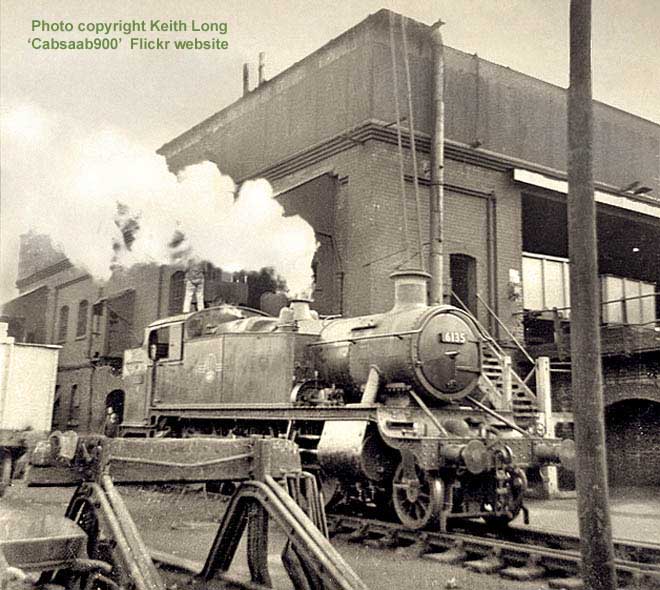
(Above) A remarkably clean area of ground at the north end of Old Oak Common coaling stage allows us to concentrate our gaze on the ex-GWR 'Large Prairie' 2-6-2 side tank No 6135 as witnessed by Keith Long during 1960. This long-time resident of 81A is waiting to refill its coal bunker, capable of holding 4 tons, before rejoining the other 15 '6100' class members allocated to 81A at that time for working local suburban services. These engines were very much the same as the earlier '5101' class, but with the boiler pressure set at 225 lbs psi, giving more tractive effort, and while some of the class were repainted in lined Brunswick Green from 1957, this example remains in normal black livery. The front end support stays were not an original feature; these were added after it was found that banking duties had weakened the front of the frame, but the support stays became an integral feature of the type, even though many a crew member had tripped over them and cursed their positioning!
The history of the class is not straightforward, its design being derived from the Churchward prototype engine No 99 built in 1903. This engine paved the way for the 3100 class, from which CB Collett constructed the well proven '5101' class between 1929 and 1949. No 6135 made its bow in 1932 and became one of the last survivors when withdrawn in December 1965. By 1963, 90% of the '5101' class had been withdrawn, but 80% of the '6100' type remained in service until being ousted from their normal duties on local passenger services by the unparalleled success of BR's new diesel multiple unit fleet.
As for the coaling stage, this image shows the north side, which had no lights set over the tip shelters, or any wall-mounted lamps to aid night-time working; the only aid being the spotlight above the far end and the yard lights of which there were half a dozen, set high above the scene. Also in good view is that substantial pipe that was noted for at least a few seasons, while repairs were ongoing within the one section of the 4 water tanks and, I suspect, explains the sight of that wheelbarrow to the left of picture.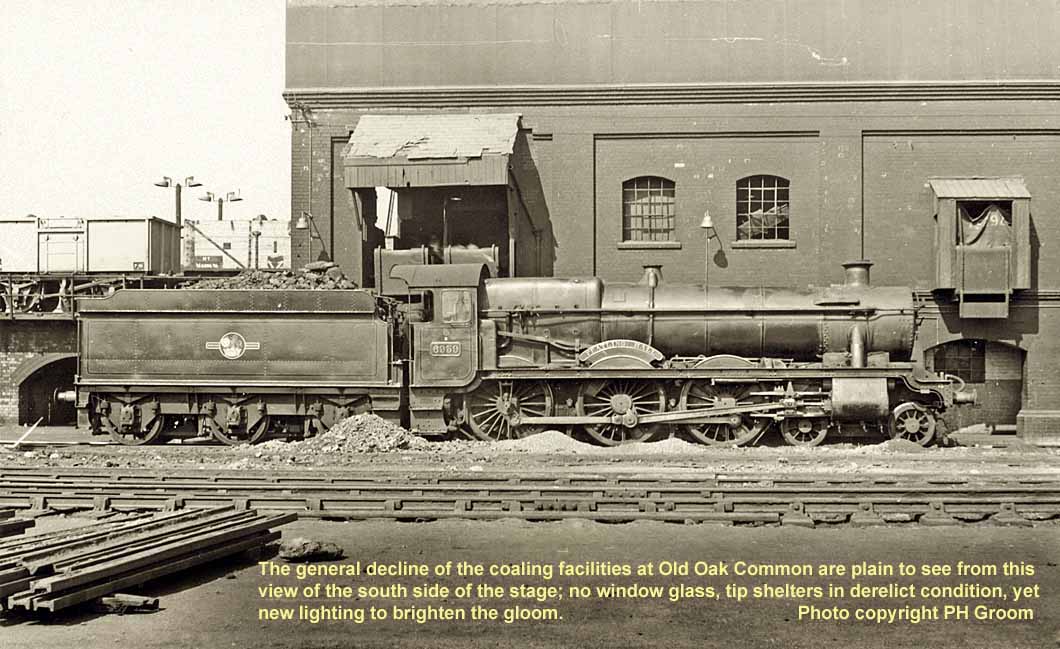
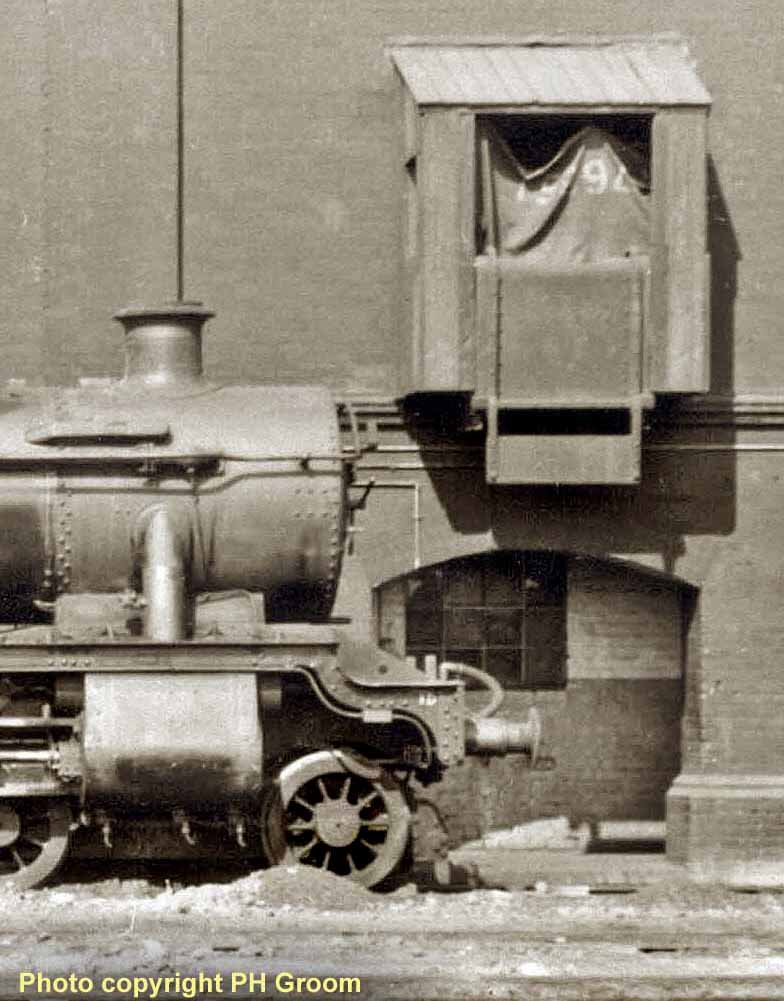 (Above) GWR 'Modified Hall' No 6959 was completed in March 1944, initially without a decisive name, and it wasn't until December 1946 that it was eventually named 'Peatling Hall'. The engine's first allocatation was Swindon depot, though on or before January 1948 the engine moved to Old Oak Common shed where it enjoyed a long, lasting association with this most prodigious Great Western Region depot. It later moved to Southall MPD during June 1964, but once 1965 had been reached the end was definitely in sight for all steam engines on the Western Region and No 6959 saw out its last few months at Oxford shed, however 7 'Modified Halls' were rescued from the scrapmen and still survive today.
(Above) GWR 'Modified Hall' No 6959 was completed in March 1944, initially without a decisive name, and it wasn't until December 1946 that it was eventually named 'Peatling Hall'. The engine's first allocatation was Swindon depot, though on or before January 1948 the engine moved to Old Oak Common shed where it enjoyed a long, lasting association with this most prodigious Great Western Region depot. It later moved to Southall MPD during June 1964, but once 1965 had been reached the end was definitely in sight for all steam engines on the Western Region and No 6959 saw out its last few months at Oxford shed, however 7 'Modified Halls' were rescued from the scrapmen and still survive today.
The class was developed by FW Hawksworth from CB Collett's original 'Halls', by changing to the use of plate frames and extending them right up to the very front of the engine, giving that easily-recognised distinction from the earlier 'Halls'. Also the leading bogie was constructed using plate frames and extended by 2 inches along its wheelbase compared to the earlier engines.
A small modification was the 'filling-in' of the drive wheel spokes immediately adjacent to the drive wheel 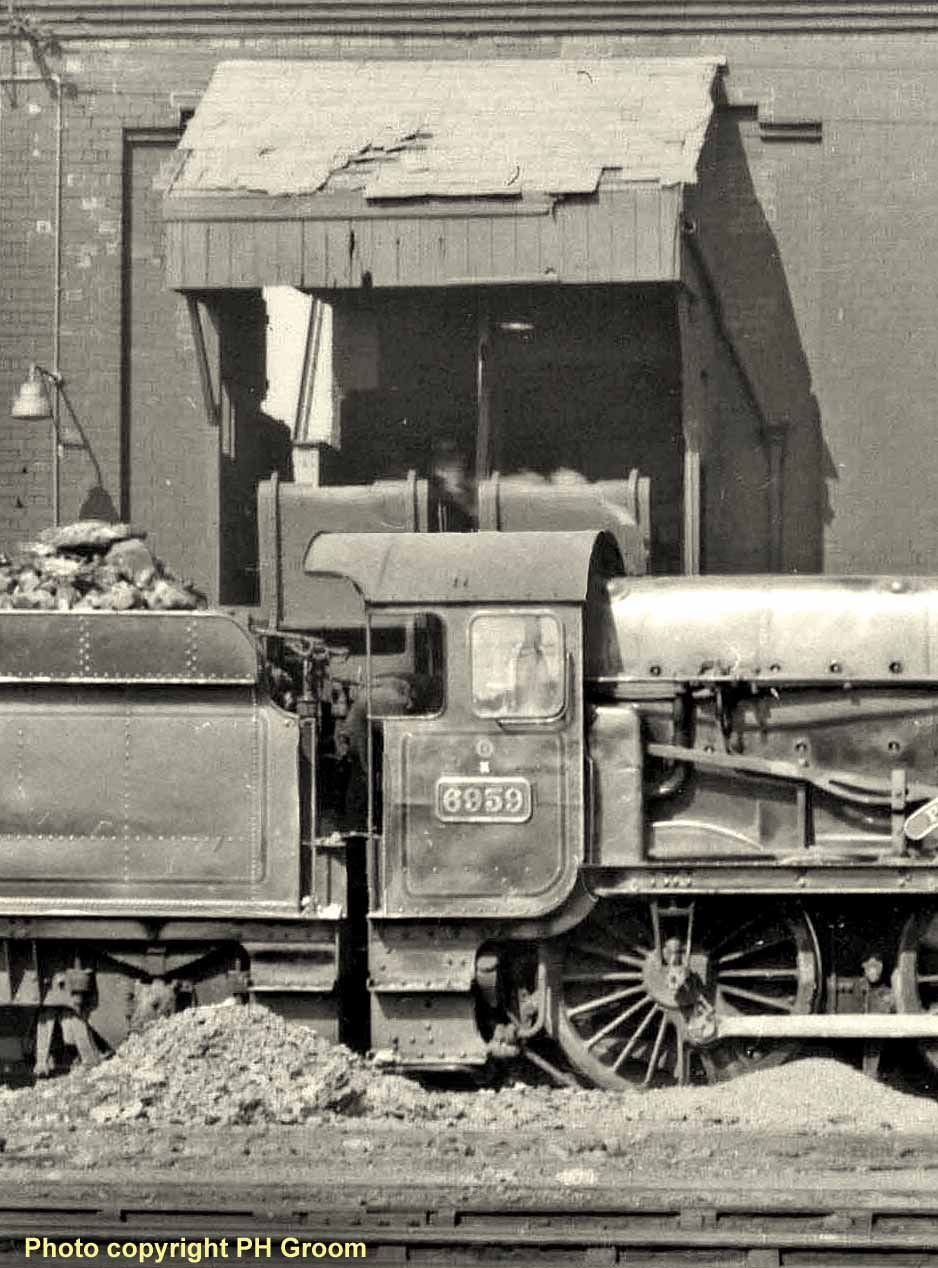 crank fixing, presumably adding some strength to the wheels. Noticeable on the immediate front of the engine are the two letters 'ID' standing for Improved Draughting; this came about as a result of tests carried out at Swindon in February 1953 to improve the performance of the locomotive when faced with using poorer quality coal. Also featured on the cab is the route classification code 'D' accompanied by an 'X' below, indicating that the engine was allowed to haul over and above its allowed weight restriction.
crank fixing, presumably adding some strength to the wheels. Noticeable on the immediate front of the engine are the two letters 'ID' standing for Improved Draughting; this came about as a result of tests carried out at Swindon in February 1953 to improve the performance of the locomotive when faced with using poorer quality coal. Also featured on the cab is the route classification code 'D' accompanied by an 'X' below, indicating that the engine was allowed to haul over and above its allowed weight restriction.
This image was captured by the redoubtable PH Groom, who never seemed to take a poor picture, although modesty will prevent him from agreeing with that statement; the 'class' leader is little changed from new, showing the speedometer on the third drive axle and the ATC pipework going along the underside of the boiler walkway to reach the front of the engine.
Withdrawn in December 1965 and scrapped at Cashmore's, Newport, No 6959 was one of 32 ex-GWR 4-6-0s to remain in service until the last embers were extinguished. In total, 9 Hall class, 16 Modified Halls, 4 Granges, 2 Manor class engines and a solitary Castle, the famous Clun Castle, survived to the bitter end... 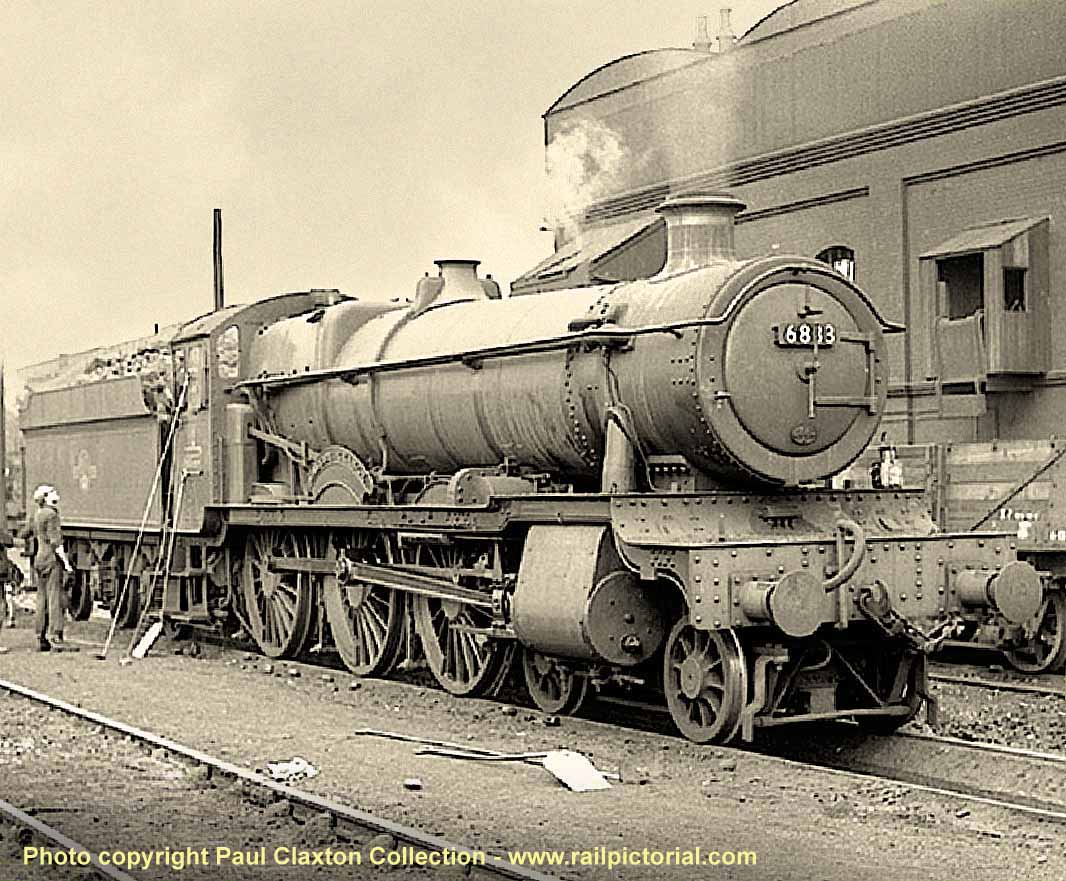
(Above) GWR 4-6-0 No 6833 'Calcot Grange' was built during 1937 and entered service at Tyseley depot then coded TYS (later 84E) before moving to nearby Leamington Spa (84D) and Banbury (84C), followed by a long spell working from Bristol Saint Philips Marsh MPD (82B) well into 1960; the engine subsequently found favour at Cardiff Canton (86C), Penzance (83G) before spending the last 3 years working from Wolverhampton Oxley (84B). The truncated class of 80 locomotives was the result of an idea by George Jackson Churchward, assistant to William Dean, then Locomotive Superintendent from as far back as 1901, when he declared that 6 'standard' designs were required to satisfy the Traffic Department's needs. Churchward's loco No 99, built in 1903, was the prototype that paved the way for the '3150' class of 2-6-2 side tanks, giving the starting point for the 4300 Mogul class built from 1911. Charles Collett, successor to Churchward, designed the Grange 4-6-0 engines using the wheels and motion parts from withdrawn 43XX locomotives, providing the GWR with a 'maid-of-all-work' type and the mainstay of the second line of express locos. Even though the class evolved in part from locomotives built between 1911 and 1915, the 'Granges' stayed together for a good length of time, with 26 engines still in service at the start of 1965, the last year of steam working on the Western Region. With its smaller wheel diameter of 5ft 8in, the class was ideal for mixed traffic duties and as such many engines received the BR unlined black livery in the post-war years, only switching to the more usual lined Brunswick Green from 1956. So this image from the Paul Claxton Collection reflecting 'Calcot Grange' at Old Oak Common having its fire cleaned, in August 1961, should be showing a green livery under that coating of dust and general grime. There appears to be a tremendous amount of coal loaded in the tender, ready for its next duty, which could easily be freight or passenger work, as the popular 'ten-wheelers' were equally capable for either task. The large coaling stage dominates the background and obviously still operates fairly well, but it is now clearly showing its age (53 years) with no glass in the upper windows and no corrugated sheets on the tip shelters.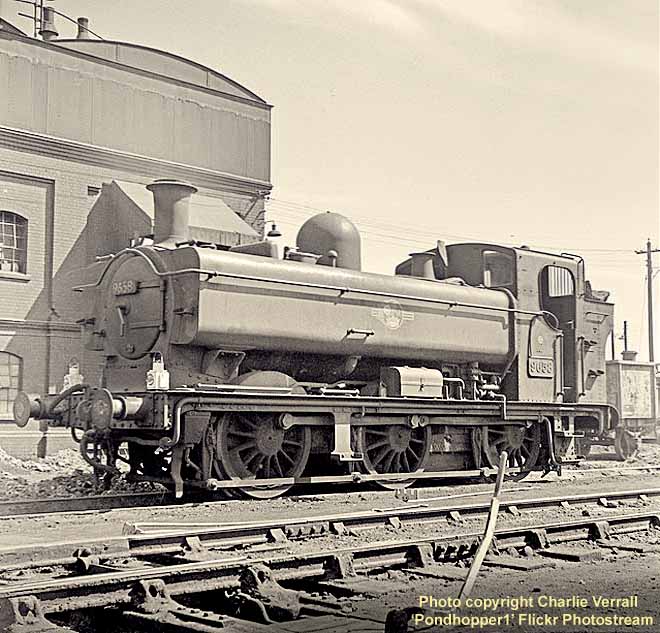
(Above) Ex-GWR 0-6-0 pannier tank No 9658 was one of the very numerous '5700' class of engines designed by Charles Benjamin Collett, for shunting and station pilot duties throughout the GWR system (and others). The class was highly concentrated at Old Oak Common depot and in South Wales. Construction of engines fitted with vacuum brakes began in 1929 until May 1949, whereas construction of the 67XX engines with steam brakes for use at Cardiff East Dock, continued until to the end of 1950. In total, no fewer than 863 examples were built, with No 5720 surviving in service for nearly 33 years, while No 6771 only managed 7 years and 3 months. In 1948, 81 0-6-0PTs worked from Old Oak Common MPD (about 10% of the total) but the figure declined to 52 in 1951 and then hovered around that number until the last vestiges of steam were in dire mortal straits from 1963.
This lovely-lit image from the camera of Charlie Verrall, affords a clear sight of all the relevant parts that contribute to an efficient working machine, surely delighting all modellers and any self-respecting railway historian. Note the detail differences in the cab, including the forward windows compared to that of '5702' at Llanelly, elsewhere on this page; also of interest is the toolbox and the relative positions of the grab handles; the cranked operating rod to the forward sanding equipment; the vacuum brake pipework along the full length of the engine; the brake lever pull bars situated on the outside of the drive wheels; also the offset wheel centres, shorter to the front than to the rear by about a foot and the express headlamps, posed by someone quite possibly. These engines had a water capacity of 1200 gallons and made room for 3.3 tons of coal in the bunker, which was extended by comparison to the '2021' class, which were replaced by these newer tanks. After a long stint of service at Old Oak, the locomotive moved to the Midlands and served for over 3 years at Oxley depot (84B), re-coded 2B from September 1963, while other class members found useful work at Clapham Junction and Folkestone Junction (for the Golden Arrow train to the harbour), not to mention the eight engines bought by various Coal Boards and a further 13 bought by London Transport, which averaged a good 6 years of service.
The immense coaling stage at Old Oak Common MPD was so huge that it almost always appeared somewhere in the picture and here we can see the south-east corner of the building, on what was the busier of the two sides, catering for the express engines in the main, although by this date, August 1962, the division of the grades of coal may well have been resigned to the proverbial dustbin, and the deteriorating condition of the stage will be noted, including the brickwork just forward of the engine and, of course, no glass at all in the upper window.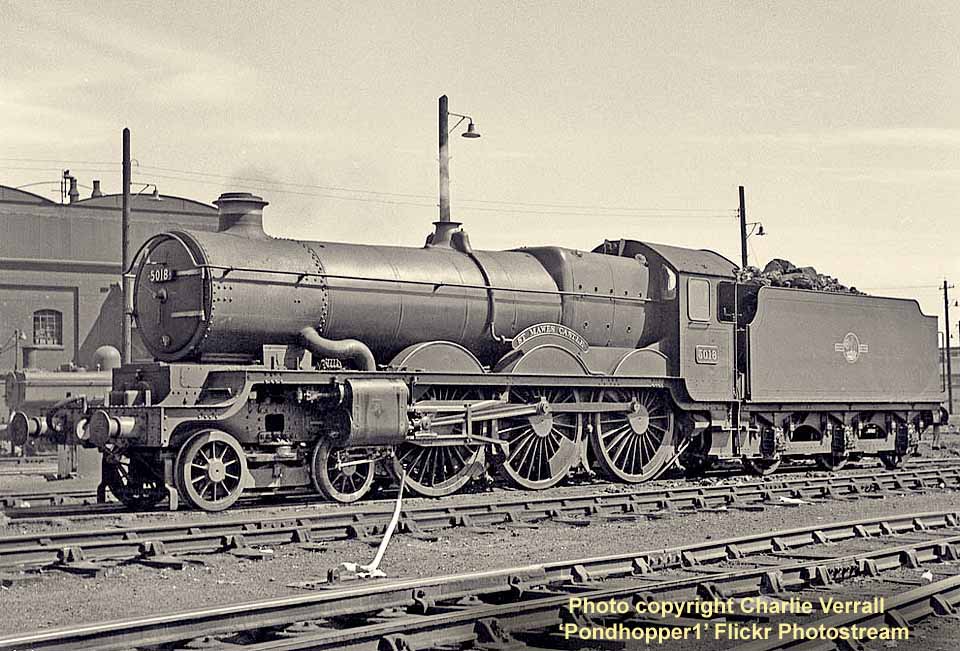
(Above) Second only to the regal 'King' class in terms of importance on the Great Western Railway, the 155 new 'Castle' class engines were the perfect answer to the running department's requirements, namely a strong 4-6-0 having good adhesion and a 'robust nose' (see below) to cope with the load increases that were beginning to tell on the 'Star' class and the Mogul '4300' locomotives then in vogue during the 1920s. The expression 'robust nose' was a reference to the somewhat precarious ride with the two-wheeled front bogie of the Mogul 2-6-0, but a 4-6-0 would well benefit from its leading bogie and give more stability especially at speed. Descending lines can most certainly be taken from the 'Castle' class through the 'Star' class and the Nord Railway 4-4-2 compound engines studied by Churchward from 1903. From the initial ideas of compound cylinders, Churchward progressed steadily to 4 cylinders with divided drive (one for the inside cylinders and a separate drive for the outside) and produced locomotive No 40 (later rebuilt to No 4000) which paved the way for CB Collett to design the first of class No 4073 Caerphilly Castle, numerically following 'Star' class 4072 'Tresco Abbey'. The new engines were constructed from August 1923, but the class was not completed until 27 years later in August 1950, when No 7037 'Swindon' rolled out of the Swindon workshops. The grand total of 171 'Castles' was made up with rebuilds; firstly the 'Great Bear', the only GWR Pacific engine; five 'enlarged Stars' plus the last ten 'Abbeys' (Nos 4063 to 4072). No 5018 St Mawes Castle was built new and completed in July 1932, being posted to Old Oak (PDN) for a short time, then Newton Abbot depot briefly before making its mark at (PDN) for 9 years. The engine also had good stints at Wolverhampton Stafford Road (SRD), Cardiff Canton (86C), Gloucester Horton Road (85B) and Reading (81D), but it was not found to be prolifically well photographed, in my experience, so I am grateful to Charlie Verrall for this capture opposite Old Oak Common depot's coaling stage in August 1962. By the end of 1962, 55 locomotives had been withdrawn reducing the number of 'Castles' in service to 97 but a further 48 members succumbed the following year, leaving a worried 49 specimens to soldier on. Noticeable on the front of the Reading engine is a touch of white paint on the smokebox hinge straps and front numberplate, showing that someone still cared for its welfare. Statistics for the locomotive show that a recorded 1,503,642 miles were covered which equates to 50,000 per year when allowing for a total of two and a half years spent under repair with 19 visits to Swindon.
(Below) King Class 4-6-0 No 6028 'King George VI' was completed in July 1930, bearing the name 'King Henry II' but only until January 1937. Allocations began at PDN (Old Oak Common) until 1944; this was followed by a move to Newton Abbot for over 4 years before making its return to Old Oak (soon to be 81A) spending almost 12 years based there. In September 1960 six 'Kings' were utilised from Cardiff for the first time, citing the presence of weak bridges in the area for the long delay, although these were said to have been strengthened in 1952. The 'Kings' spell at Canton was followed by a last gasp return to (81A) until the whole of the class was retired by the close of 1962.
Although No 6028 was never a resident at Wolverhampton (Stafford Road) shed (84A), it would have visited the shed many times whilst hauling the London Paddington-Birkenhead trains via the Birmingham route, coming off the train at Wolverhampton (Low Level). In total 19 'Kings' were allocated to 84A at one time or another, with Nos 6005-6 and 6008 spending an exceptionally long time there; indeed the depot mostly had four 'Kings' to call upon for the Birmingham-London express turns, while the prestigious 'Inter-City' service was an Old Oak turn. This gave spotters at Birmingham Snow Hill the chance to see all the 'Kings', with the exception of the Laira-allocated members. No 6028 recorded a very impressive 1,663,370 miles throughout its 32 years of service; this equates to an annual average of 52,000 miles. However if one takes into account the engine's inordinate number of workshop visits (81) we must factor in a conservative estimate of fully 6 years when the locomotive was out of service, therefore a revised figure of 63,000 miles per year is probably more accurate. Some of the engine's extraordinary downtime resulted from an unfortunate accident at Norton Fitzwarren in November 1940, when a derailment resulted in 27 fatalities.
For the record, the hard water within the Wolverhampton area was a constant problem for steam engines, as it created limescale deposits in the boiler requiring the necessary washouts, but ICI came up with a water treatment to greatly reduce the limescale, tested in 1956 and then added to a total of 17 King locos, ie all the engines using the Birmingham Line at that time, including No 6028. The twin exit roads of the coaling stage are pictured in the left background, with one of the 4 chimney stacks also visible.
(Footnote above) A locomotive nameplate and cabside numberplate from the GWR 'King' Class 4-6-0 No 6028 King George VI went under the hammer for £35,000 and £10,000 respectively at a Great Central Railwayana Auction (GCRA) on 13th October 2012. Constructed at Swindon in July 1930, the loco was originally named King Henry II, but was renamed in January 1937 after the then reigning monarch. The loco had spells at Newton Abbot, Old Oak Common, Cardiff Canton and back to Old Oak Common from where it was withdrawn by 17th November 1962 and sold for scrap to Birds Commercial Motors on 3rd June 1964. Click HERE to visit the fascinating GCRA website.
WOLVERHAMPTON STAFFORD ROAD 84A
The unique coaling stage at Wolverhampton Stafford Road (84A) was quite remote to the shed complex, as access was only attainable by two lines which had to cross the Birmingham Navigation Canal then thread underneath a viaduct of the Stour Valley Line, greatly restricting locomotive movements on and off the lower yard. The coloured brick structure was perfectly symmetrical; it had 2 roads in; 2 exit roads; 2 double tips; 12 windows; a pitched roof and 4 chimneys. The water supply tank stood on a strong cast-iron framework adjacent to the coaling stage, but away from the running lines and was quite possibly 'ancient' as the initial shed was opened in 1860. The coaling stage measured 52ft across the front elevation by 60ft and was completed between 1929-30, using the comfort of the 'Railway Loans Act' to finance the work.
The double counter-balanced coal delivery platforms were set centrally on the front and rear elevations and were protected by rather shallow wooden shelters. Around 1942 these were superseded by corrugated iron covers that were larger and more durable, though much less appealing visually and were odd-shaped, being an acute scalene triangle, ie not having a right angle and possessing unequal sides. Twelve windows were set in familiar fashion; double brick arches with a 4 by 4 grid for the panes, which were non-existent from the early 1950s; 4 windows each for the front, side and rear elevation, but none to the east side, where the two exit roads, though just 75 ft. long, were set on neat brick arches. Wooden stairs were set parallel to the exit roads; a flight of 6 treads led to a platform, based on a brick plinth, giving way to nine steps to the rear entrance door and these were repeated exactly on the other side of the building, giving easy access to the loading bays.
The south side of the stage seemed to have been used much more than the other, mainly because it led directly onto the turntable, a straight forward run through for the engines. Another unique facet of this coaling stage, was the roof vent which measured 25ft by 8ft on both sides of the single pitch roof, which was in tandem with the 4ft diameter 'port-holes' situated at each end, over the rails, but not normally seen or even required on such a building. The entrance roads were set on a slope of 1 in 40 and marked with a cautionary sign over the steel lintel declaring that 'No engine must pass this arch', even though it was a square opening. The outer edges of the soil bank were retained with a small reinforcing wall which was integral with an 8ft brick wall linked to the west side of the stage. During 1942 the gas lamps were removed and replaced with electric types sporting 'coolie style shades'; the new lighting was sited in very similar areas, such as opposite to the tipping platforms and adjacent to the wooden steps to the rear, but also  noticed were additional illumination immediately over the platforms and others adjacent to the running lines just to the north of the stage.
noticed were additional illumination immediately over the platforms and others adjacent to the running lines just to the north of the stage.
No ash shelters were erected in the vicinity of the coaling stage, in fact the whole of the loading area was relatively clean and clear, but the two engine sheds, nominated as Nos 4 and 5 on the plan, certainly resembled ash shelters in design and actual construction and latterly in a condition indicating their temporary nature. The larger effort measured 67ft by 250ft long, double the size of the second, which did look as though it had been 'shoe-horned' into the only space available at the top of the shed yard, actually 230 yards away from the coaling stage.
(Below) King Class 4-6-0 No 6021 'King Richard II' was completed in July 1930, beginning service from Old Oak Common (PDN) after stringent testing by Swindon and fitment of the required ATC equipment which provided fail-safe braking of the train. In September 1956, the engine made its first move from Old Oak and relocated to Plymouth Laira (83D) swapping places with No 6022 'King Edward III' to maintain the balance of numbers. Three years later the locomotive returned to the London depot and remained there to the bitter end in September 1962, achieving a recorded mileage of 1,793,439 which was a good average for the class. One of its very last revenue earning runs was a Newbury Race day special (train Z11) which was captured on film by Geoff Rixon as the engine was about to leave Paddington displaying fabulous Brunswick Green livery, with well polished brass works to the fore, amazingly one month before being scrapped. The 'King' class locomotives were not subjected to much change or modification, except for the addition of a double chimney and blastpipe after tests were carried out on '6015' and much improvement of performance resulted. Ten engines were so modified in 1957, including No 6021 seen in March of that month, while the engine was allocated to Laira (83D), mainly for 'Cornish Riviera' duties. Also of note is the unique leading bogie that was fitted to 6021 at this time; it was the only fitment to have a slotted front cross-member allowing more air through to help to cool the wheel bearings. The backdrop to the photo reflects a splendid view of the single-pitch roof of the coaling stage at Wolverhampton Stafford Road, with its large centrally positioned vent prominent and two of the four chimneys also in good view. It is doubtful if there was ever any glass actually fitted to the tip shelter, but certainly there was none in view here or in latter days. 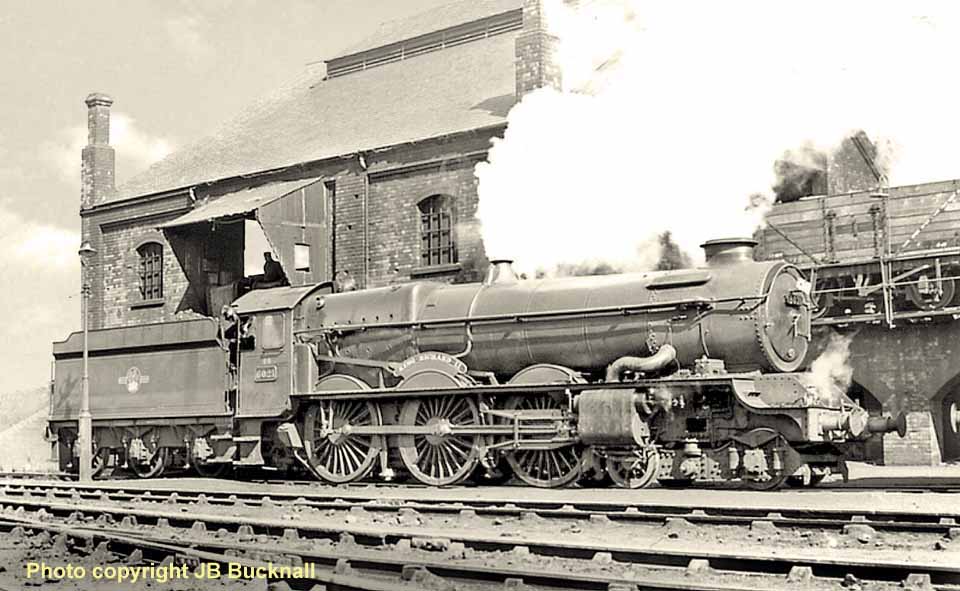
(Below) This shot of King Class 4-6-0 No 6021 'King Richard II' was taken at Wolverhampton Stafford Road on a different occasion, but going through the same procedure to prepare the engine for its return to London later in the day. The locomotive has been turned before being coaled which helps the crew slightly because the old turntable was completely manually operated and the engine is noted as still in reverse gear (operating lever between first and second drive axle splashers), but very precisely in mid-gear showing the connecting rod horizontal and fully forward. Also of note on the locomotive cab are the two sliding roof vents which were not fitted as built, but seem to have been inserted around the same time as the outside steam pipes were modified from 1952 onwards. Some splendid detail can be gleaned from such an image as this; the old lamp standard has many intricacies and designs to admire; the scant illumination within the coaling stage can be realised; the stark windows which should be giving some daylight to bear are boarded-up and still show jagged, broken glass in some places and the original red brickwork was heavily marked with coal dust, more so than most because there was no facility to damp down the loaded wagons as they entered the stage, a standard feature at many depots. 

(Above) 'Castle' Class No 4096 'Highclere Castle' was never allocated to Wolverhampton Stafford Road during its BR days, but it was on the books for a year from early in 1933 and would surely have made the journey from London Paddington to Wolverhampton many times during its spell at Old Oak Common depot in Harlesden. No 4096 was allocated three times to Weston-Super-Mare, a sub-shed to Bristol Bath Road, firstly in wartime (1941) but also for two short periods in 1948. These placements would seem to have been arranged in order to provide for a stand-by engine, as supplied by the Bristol depot as cover for the many engines terminating at Weston-Super-Mare with holiday trains. The temporary residencies involved fifteen other 'Castle' class locomotives sent separately by Bristol Bath Road at one time or another. Also No 4096 was seen to work from the depots at Laira, Newton Abbot, Landore, Bristol Bath Road and Reading, before 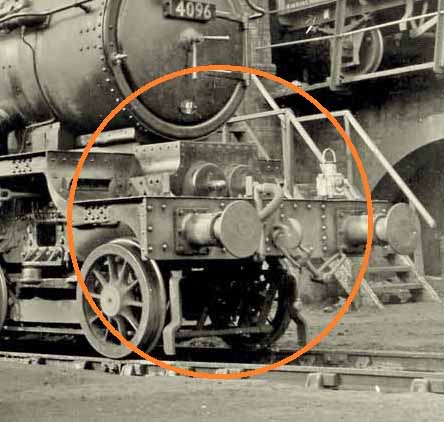 finally returning to Old Oak Common at the end of 1962.
finally returning to Old Oak Common at the end of 1962.
This photo shows well the full height of the 'ten-wheeler' which has reached Wolverhampton from its home shed of Reading (81D) having taken over a returning Margate holiday train, from a Southern Region loco. The engine was allocated to 81D from July to December 1962, with barely 6 months useful service left. Built in June 1926, the locomotive completed a recorded mileage of 1,958,370 miles, which, allowing for Works visits (29 times) totalling 2½ years, averages out at 55,000 per year, a very excellent return for an engine that saw little modification from new.
Of particular note on the engine is the fluted casing for the inside cylinders (inset left) which Swindon workers dubbed a 'Vauxhall Front End'; this related to the shape of the front of the engine frame being very similar to that of a pre-war Vauxhall car (inset right below) with respect to the front wheels of the leading bogie. It is possible to pick out that shape (called a joggle) seen immediately 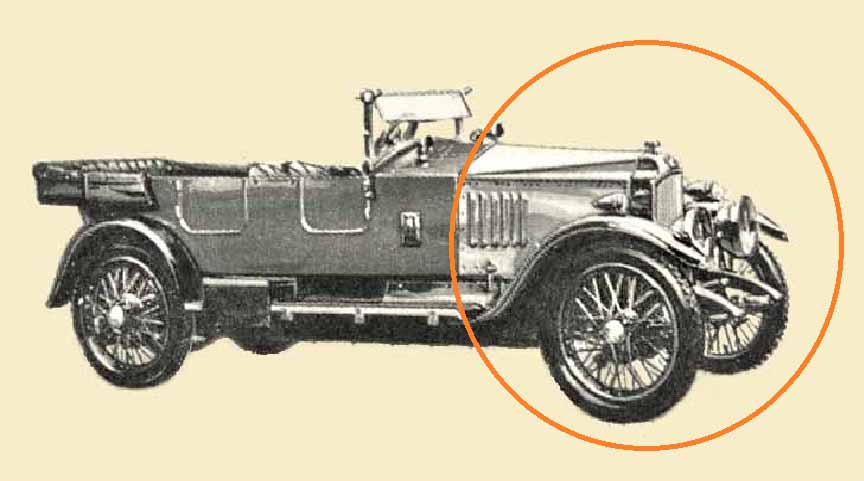 above the bogie wheel and this was retained throughout, as was the single chimney (66 'Castles' had a double chimney fitted) and from this angle the copper-capped single version looks very large.
above the bogie wheel and this was retained throughout, as was the single chimney (66 'Castles' had a double chimney fitted) and from this angle the copper-capped single version looks very large.
Also noticeable on the engine is the lack of ATC equipment; though a speedometer was a long term fixture; a Hawksworth tender was coupled-up for the last few months of service and the engine is seen to be in reverse gear still, having just come off the turntable to the right. It is noticeable that the front numberplate is made up of machined numerals, as on all GWR engine types and surely why so many of them went missing or were removed and poor replacements were fitted. But this was another Swindon Factory refinement, a sure sign of quality and attention to detail that was always evident in the out-shopped condition of GWR engines.
The 'Castle' class locomotives were considered by many as the epitome of express engines, but the design was a compromise made by the GWR's new CME, CB Collett, who was obliged to rethink the Churchward proposal of using the 47XX class boiler (No 7) on a 'Star' frame, which would have resulted in an engine with a too-high axle-loading. Instead Collett utilised the firebox from the 47XX boiler and reduced the diameter of the barrel by 3 inches, thus saving sufficient weight to satisfy the Civil Engineer that he would not be causing any bridges to tumble.
Mentioning weights, the standard GWR engine was made up a number of metals and other components; mainly steel, but also 5½ tons of cast iron; 2½ tons of copper; 5 cwt of bronze and 84 lbs of brass. The unique coaling stage shows up quite well in this image, with one of the exit road arches prominent, the wooden steps seen to good effect and the size of that tip shelter conspicuous. It was also noted that the condition of the guttering was very poor and no longer fit for purpose, but at this late stage it was never going to change.
LEAMINGTON SPA COALING STAGE 84D.
Opened in 1906, Leamington loco shed (84D) was a standard straight Churchward-designed facility consisting of a 4-track shed building and, to the right-hand side of the yard, a coaling stage with one single tipping point surmounted by an 8ft-high water tank of 45,000 gallon capacity. The comment 'right-hand side of the yard' is relative to the front of the shed building, with the viewer looking out into the yard itself. 
Measuring 30ft x 32ft, this style of brick-built stage was repeated all over the GWR system, with 14 other similar stages built to the same regulation design. The front elevation showed four symmetrically positioned windows, having double brick arches and panes set to a 5x4 pattern, thus affording ample light during daylight hours. An essential part of maintenance was the 30 ft. long metal ladder which allowed some brave person to climb up to a very small platform to check all was well with the water tank feed and covers. The ladder was rigidly held with a sturdy bracket affixed to the left-hand corner of the stage and was probably added during the first couple of years, along with a set of wooden steps at the eastern end of the structure, giving easy access to rail level. 
 (Above-Inset Right) It is noticeable from this early image that there was a considerable 'hump' just within the building; this allowed an empty wagon to roll away to the buffer stop at the eastern side of the coaling stage prior to collection of the backlog of trucks. The usual regulation warning sign (inset right) was affixed to the right-hand side of the entrance arch, declaring that no engine should pass into the coaling stage.
(Above-Inset Right) It is noticeable from this early image that there was a considerable 'hump' just within the building; this allowed an empty wagon to roll away to the buffer stop at the eastern side of the coaling stage prior to collection of the backlog of trucks. The usual regulation warning sign (inset right) was affixed to the right-hand side of the entrance arch, declaring that no engine should pass into the coaling stage.
Initially the tipping point was a single affair with a medium shelter constructed simply from wood and topped with a corrugated iron roof set at a shallow angle and deemed adequate for the servicing of the shed's allocation of around 30 engines. However, to cope with the larger engines that were beginning to frequent the shed, the coaling stage was improved circa 1940 with the help of the Railway Loans Act, to provide a double tipping point and a much larger shelter, enabling approximately two tons of coal to be dispensed at the same time. The construction of the enlarged cover utilised the original left-hand upper window, with reworking of the brickwork to provide the extra width required and the resulting shelter had a marked resemblance to that at Wolverhampton Stafford Road, which I described as a 'scalene triangle', being a shape that does not have any equal internal angles, or possess a right angle. Other changes made at this time included the introduction of electric lighting at various points of importance, replacing the original gas lamps; also a roller blind was added to the entrance road archway in an attempt to allay the worst of the weather. In later times, no changes were to be noted, but the advent of time was obvious with no glass to be seen in the windows, debris strewn across the track and overgrown soil banks to the fore. Click HERE to visit the excellent Warwickshire Railways website which features many interesting photos of 84D…the site is an invaluable aid for discerning modellers.
(Below) Seen in December 1938, a nearly-new, outside-framed, 'Dukedog' class No 3218 awaits its next duty at Leamington depot. This hybrid design by CB Collett was conceived from the frame of a 'Bulldog' class 4-4-0 engine and the boiler of a 'Duke' locomotive which formulated a lightweight (49 tons) unit for secondary lines. The number '3218' had very recently been attributed to a 2-4-0 'Barnum' which was scrapped in 1937; and the number was then used for a Class '2251' 0-6-0 in 1948, resulting in the 'Dukedogs' being renumbered into the 90XX series. This class was one of the many cost-cutting schemes thought up by the GWR's CME (1921-1941), CB Collett, whose twenty-year tenure at Swindon produced many famous 4-6-0 types. No 3218 was mainly allocated to Swindon (82C) and Machynlleth (89C) under BR regime and finished its service at Croes Newydd (84J) in June 1960. 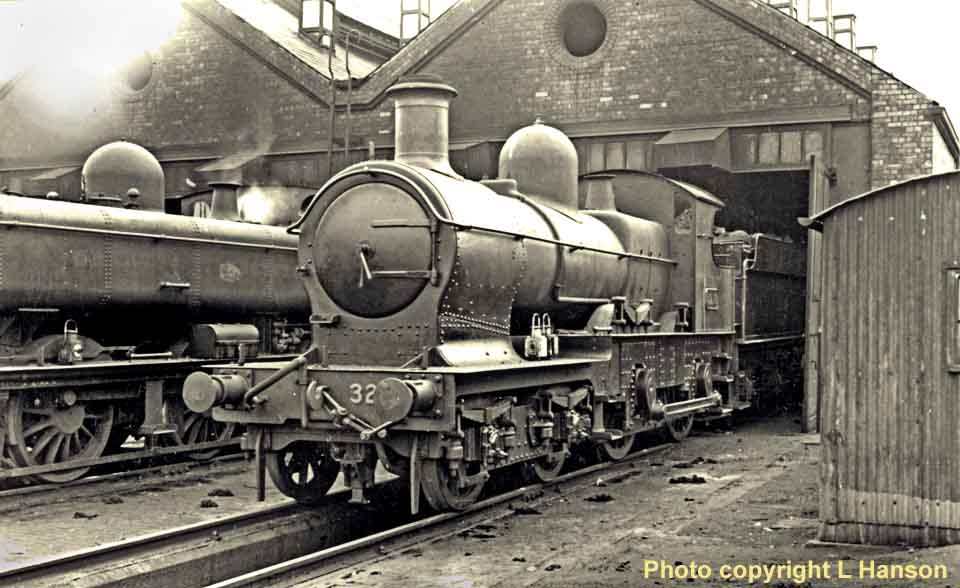
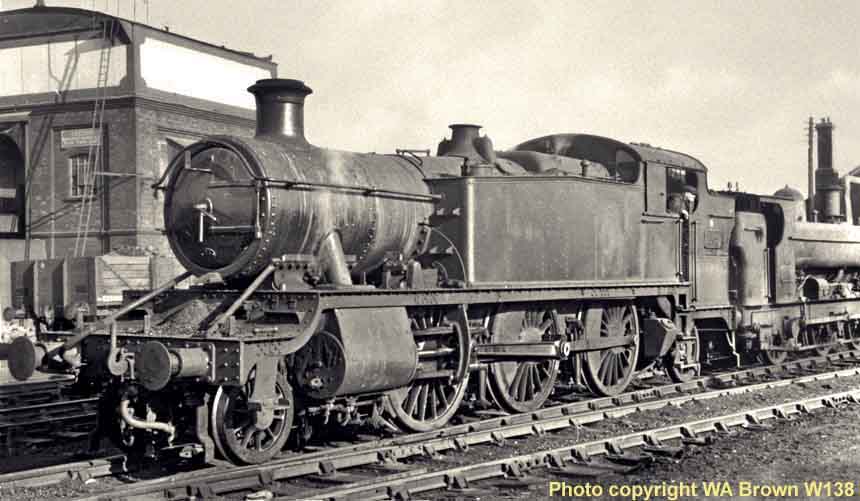
(Above-Below) Photographed in March 1951, the Large Prairie 2-6-2T No 8109 was a long-term resident at Leamington. The Collett rebuild of Churchward-designed '3100' into the '5100' Class engines, evolved into the '8100' Class in 1938-39, modified with smaller wheels and higher boiler pressure to produce a fast-running locomotive for local services in the heavily populated Midlands conurbations, sharing the duties with sister engine No 8100, also a Leamington stalwart. Worthy of note on the engine is the fact that no brackets are yet fitted to the smokebox for the purpose of retaining the BR numberplate, also of note are the two footsteps attached to the front of the nearside tank. (Below) Seen in 1950, Caledonian Blue-liveried 'King' class No 6020 King Henry IV was photographed at Leamington Spa depot poised to head back to Wolverhampton Stafford Road (84A), its home depot at that time. 
AROUND THE REGION - 1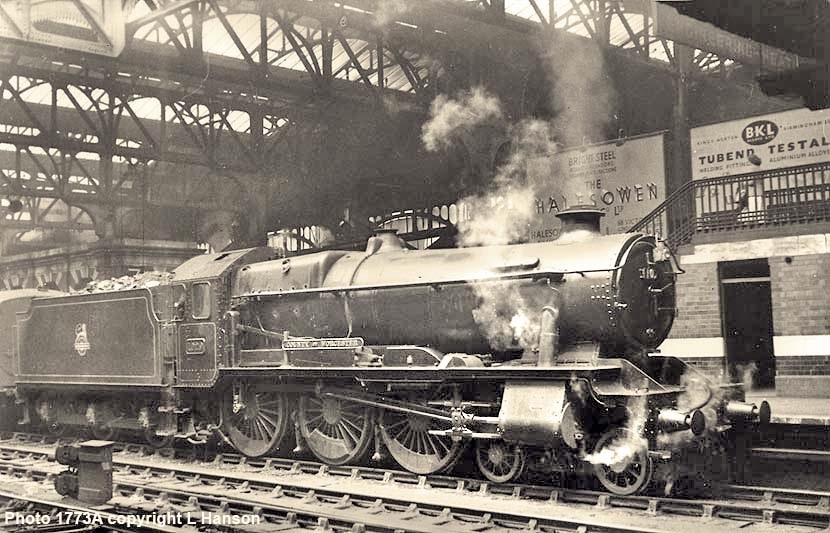
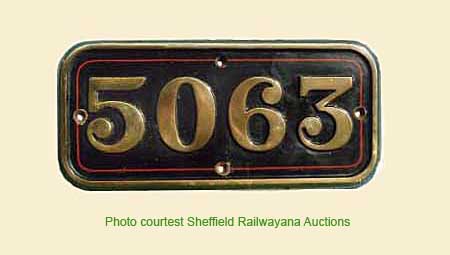 (Above-Below) Another view of Birmingham Snow Hill with FW Hawksworth's 'County' class 4-6-0 No 1029 County of Worcester, the last of 30 members of the class, awaiting departure on 30th June 1953. By the end of 1948, many locomotives were carrying their new BR numbers with the exception of the Western Region engines which retained their attractive GWR brass and cast iron cabside number plates below 10,000. See 'Castle' class 5063 Earl Baldwin (left) and a humble 0-6-0PT No 5746 (right). British Railways eventually chose a dark Brunswick Green (lined
(Above-Below) Another view of Birmingham Snow Hill with FW Hawksworth's 'County' class 4-6-0 No 1029 County of Worcester, the last of 30 members of the class, awaiting departure on 30th June 1953. By the end of 1948, many locomotives were carrying their new BR numbers with the exception of the Western Region engines which retained their attractive GWR brass and cast iron cabside number plates below 10,000. See 'Castle' class 5063 Earl Baldwin (left) and a humble 0-6-0PT No 5746 (right). British Railways eventually chose a dark Brunswick Green (lined 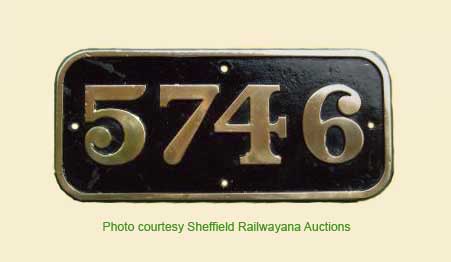 out in black and orange) for BR's fleet of express-passenger engines. Consequently, little had changed on the Western Region since GWR days. The photo below shows a clean-looking 'King' class No 6022 sporting a double chimney and carrying the second BR emblem consisting of the British lion rising from a crown holding a driving wheel in its front paws. Beneath it 'Castle' class 4-6-0 No 5028 Llantilio Castle with the BR's first 'Lion and Wheel' totem (1948-1956) on the tender side.
out in black and orange) for BR's fleet of express-passenger engines. Consequently, little had changed on the Western Region since GWR days. The photo below shows a clean-looking 'King' class No 6022 sporting a double chimney and carrying the second BR emblem consisting of the British lion rising from a crown holding a driving wheel in its front paws. Beneath it 'Castle' class 4-6-0 No 5028 Llantilio Castle with the BR's first 'Lion and Wheel' totem (1948-1956) on the tender side.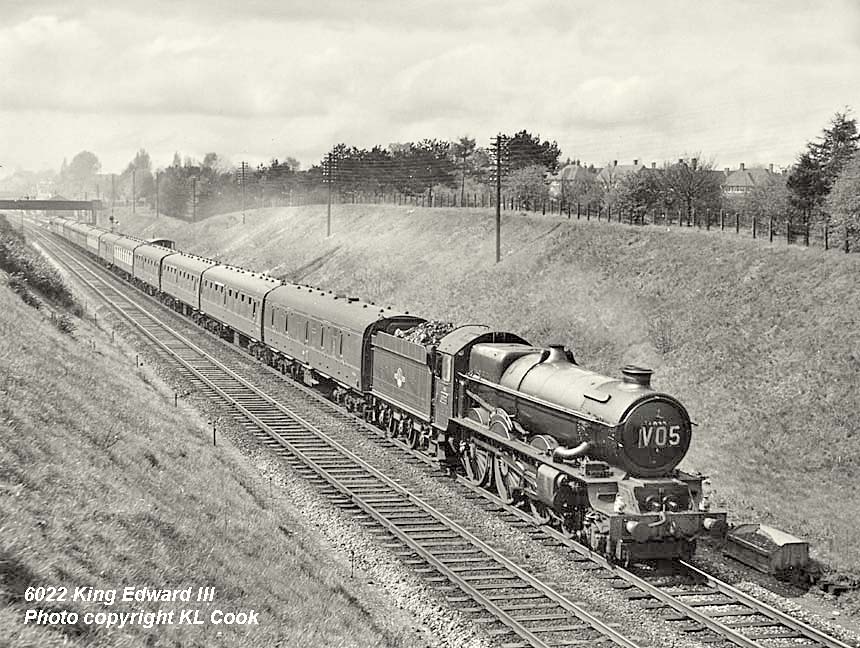
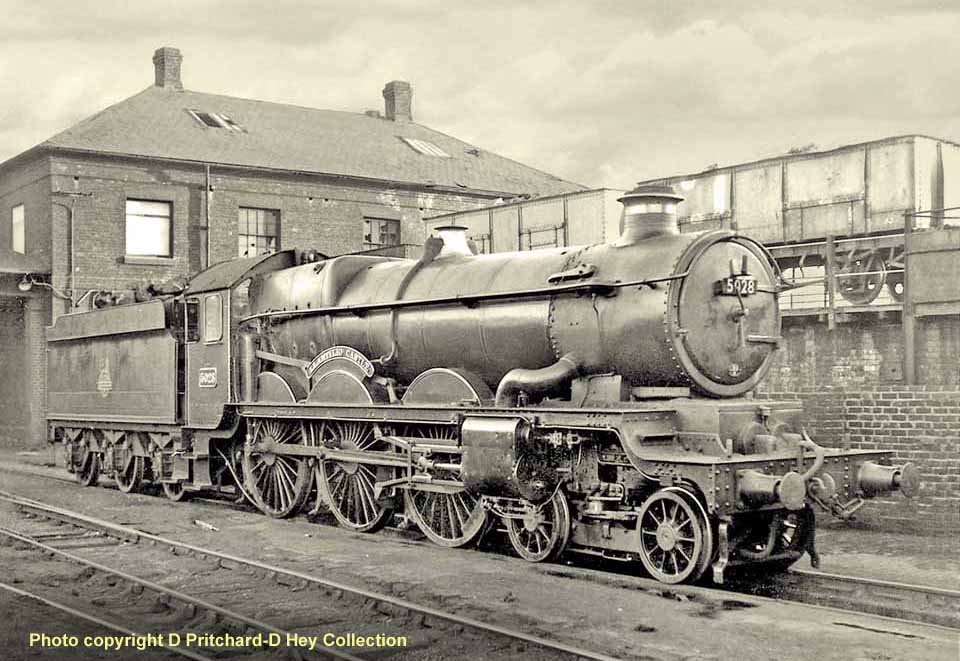
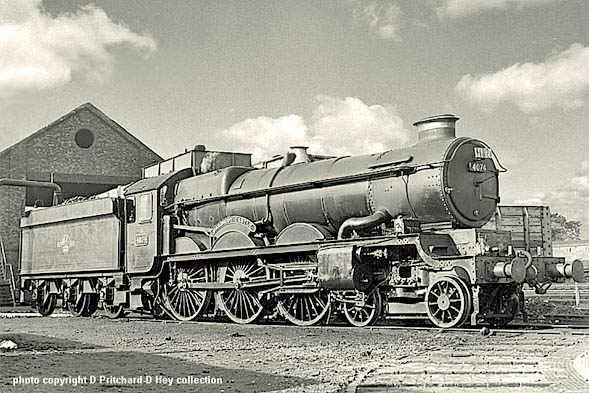
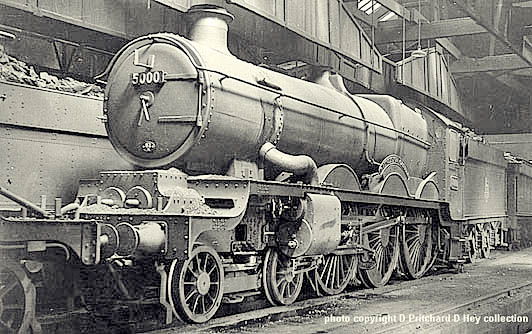
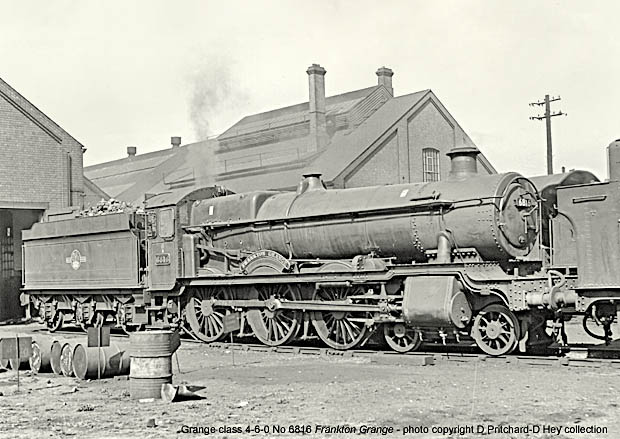

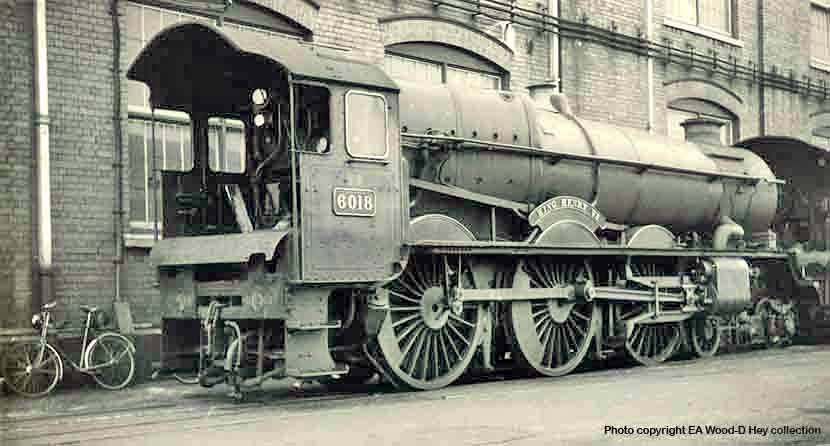
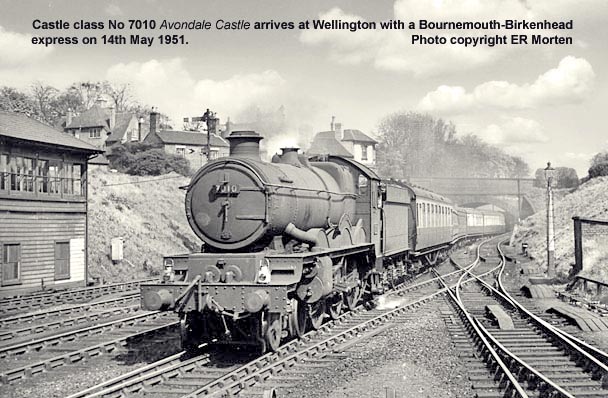

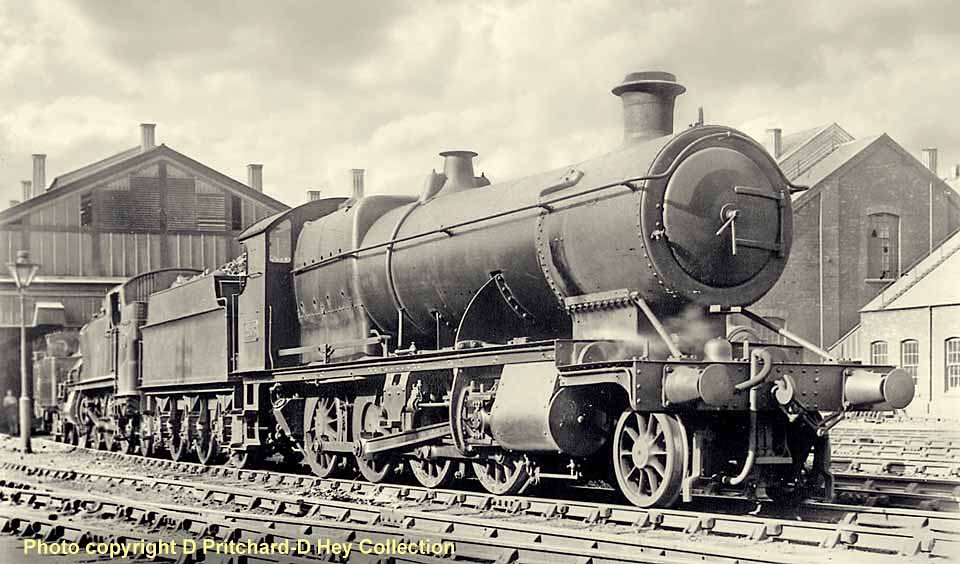
(Above) Whilst the GWR's dark Brunswick Green survived for use on BR's express passenger engines, the choice of black livery with a red, cream and grey lining for locomotives designated mixed traffic, and an even duller unlined black livery for its freight and shunting classes can hardly be described as adventurous. When George Jackson Churchward was CME at Swindon (1902-1921) he equipped the Great Western Railway with nine locomotive classes ranging from 2-6-2Ts, through 2-6-0 and 4-6-0 mixed traffic and express passenger locomotives, to 2-8-0 heavy freight engines of both tank and tender varieties. This Class 28xx No 2803 was photographed at Swindon in June 1950.
RECONNAISANCE WITH A CAMERA
Richard S Greenwood MBE 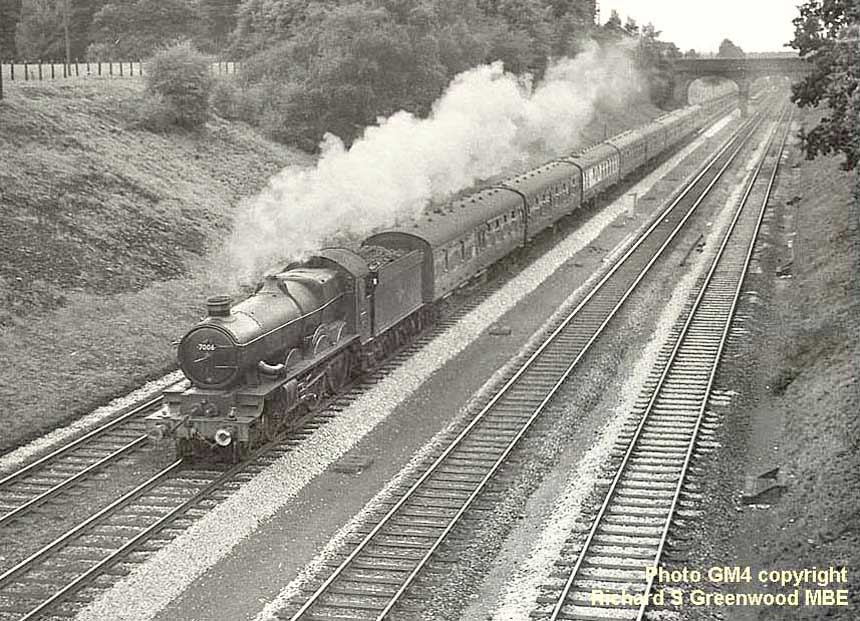
Memories of steam days on the former Great Western main line from Paddington to Bristol and the West of England…on Saturday 29th July 1961 Richard Greenwood availed himself of his trusty Leica 3A camera and paid a visit to Tilehurst and Twyford to photograph the fast diminishing rank and file of steam; the WR was one of the first Regions to completely dispense with the services of steam.
Opened on 1 July 1839, the 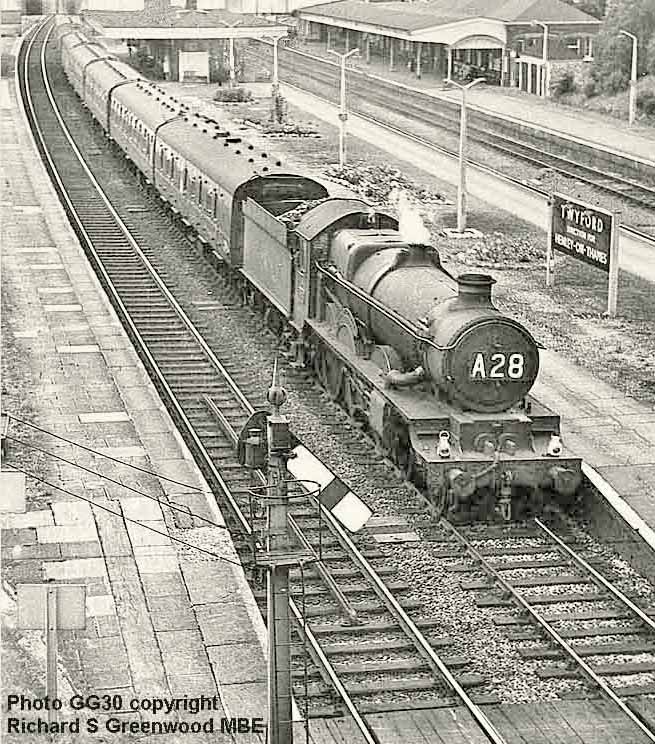 original station at Twyford was once the terminus of Brunel's Great Western (Broad Gauge) main line from Paddington, served by nine trains per day. The layout of the station included an engine shed which had been moved from Maidenhead, the first terminus out of London. Following completion of Sonning Cutting on 30th March 1840, the broad gauge line was extended to Reading and the timber station buildings at Twyford were replaced by more substantial brick and stone buildings with an all-round canopy. At the same time the platforms were altered to serve the new through running lines.
original station at Twyford was once the terminus of Brunel's Great Western (Broad Gauge) main line from Paddington, served by nine trains per day. The layout of the station included an engine shed which had been moved from Maidenhead, the first terminus out of London. Following completion of Sonning Cutting on 30th March 1840, the broad gauge line was extended to Reading and the timber station buildings at Twyford were replaced by more substantial brick and stone buildings with an all-round canopy. At the same time the platforms were altered to serve the new through running lines.
(Above) 'Castle' class No 7006 Lydford Castle heads away from Twyford with a Hereford to Paddington express.
(Inset) An unidentified 'Castle' class heads the SO 8.05am Blaina - Paddington, due to pass here at 11.49. Of interest to modellers is the paraphernalia on the platform: the layout of the flower beds edged in stone, the cast concrete lamp posts, fluted home signal and the enamel chocolate and cream station sign - 'Twyford. Junction for Henley-on-Thames' (the Henley Branch was opened in 1857).
(Below) Adding to the loco variety, 2-6-2T No 6136 heads bunker first on the 'up' relief line with a train of mineral wagons.
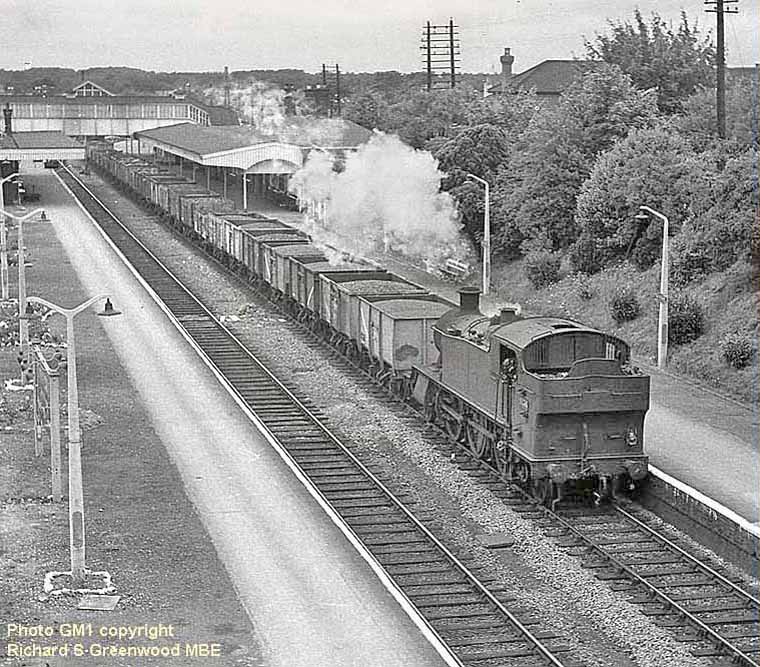

(Above-Below) The demise of Brunel's broad gauge in 1892 gave the Great Western Railway the opportunity to quadruple the main line as far as Didcot, and as a result Twyford station was completely reconstructed. Some of these improvements are still visible today; the current station has 5 platforms, consisting of 1 and 2 on the 'fast' Reading-London lines and Platforms 3 and 4 on the 'relief line'. Platform 5 is a bay platform serving the Henley Branch. Here 'Castle' class No 5044 Earl of Dunraven heads non-stop through platform 2 with an 'up' express on 29th July 1961. Fast-forward twenty-odd years to 1975 and the platforms 1 and 2 were altered to reduce the curve through the station to accommodate the new 125mph High Speed Trains. (Below) The complex new track layout in 1840 required the construction of two signal boxes East and West, to replace the old one on the up platform. In 1961 the trackwork was simplified and the two signal boxes were decommissioned and replaced by a single box between the up relief and branch lines. This box lasted until 1972, when all signalling control was transferred to Reading. Here 5987 Brocket Hall and 5945 Leckhampton Hall approaches Twyford on the down main line on 29th July 1961. The goods yard and cattle dock closed in 1965 and the site cleared to provide car parking for commuters. 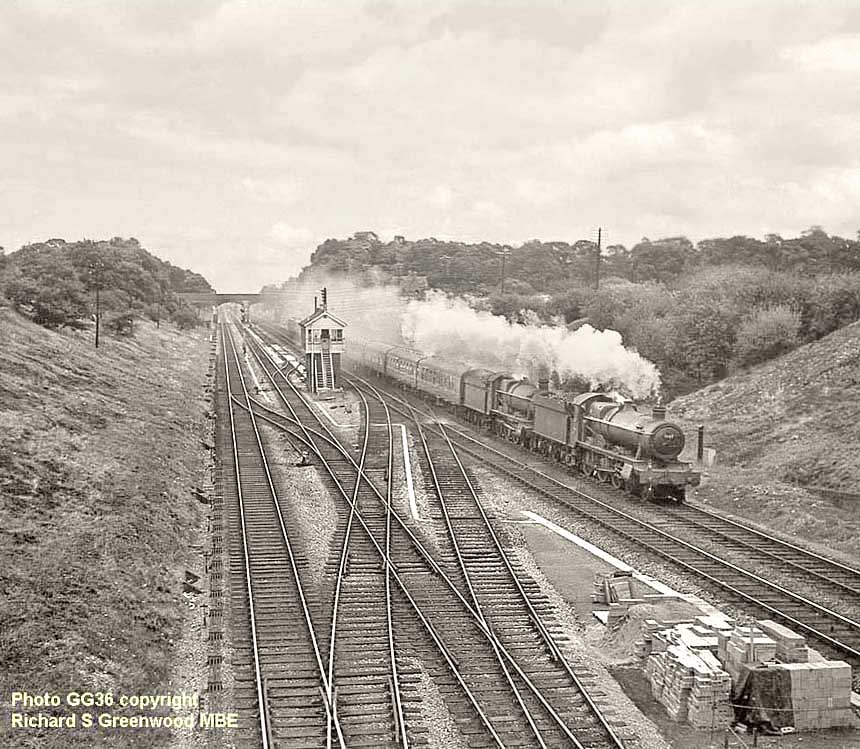
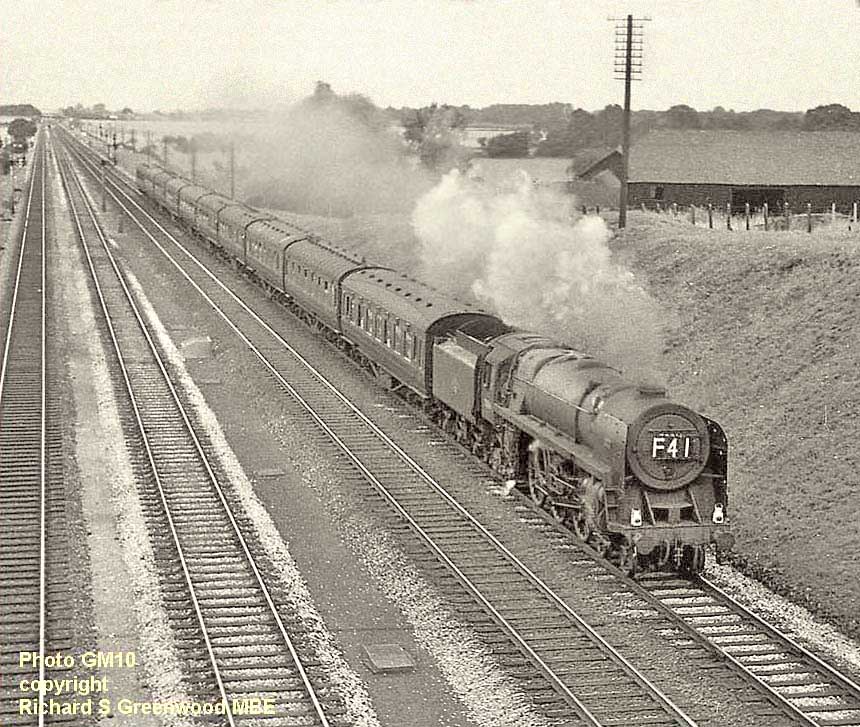
(Above) The 12.55 SO Paddington - Swansea was photographed halfway between Ruscombe Sidings and Twyford signalboxes on the down main line behind BR Britannia Class 7 Pacific No 70016 Ariel, one of the new BR 'Britannias' allocated to the WR. When British Railways was formed in 1948, the Railway Executive of the British Transport Commission (BTC) set about the design and construction of twelve new 'standard' steam classes, the first being the 'Britannia' Class 7MT Pacific locomotives (Nos 70000-70054) built at Crewe from 1951. The first batch of 15 locos were allocated to the Eastern Region (eight to Stratford and seven to Norwich) for use on the GE line's expresses, whereas No 70016 Ariel was among the batch of ten locos Nos 70015-70024 destined for the Western Region. Click HERE to visit Page 91. However, the WR crews at Old Oak Common, Plymouth Laira and Newton Abbot Depots didn't take to them and the locos were finally concentrated on Cardiff Canton. The WR 'Britannias' were easily distinguished by their smoke 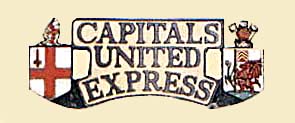 deflector modification. This followed a serious accident involving WR 'Britannia' class No 70026 Polar Star whilst working a Treherbert-Paddington excursion on November 20th 1955. The driver failed to slow for a crossover at Milton near Didcot (after misreading the signals) and cancelled the AWS warning. As a consequence the loco and several carriages were derailed causing 11 fatalities and 157 injuries. During the inquiry, a contributory factor was that the driver's forward vision had been obscured by the smoke deflector handrails. This resulted in the handrails on the WR batch being replaced by 6 cut-outs (handholds) in each deflector sheet, the majority being brass-lined, which added to the overall look of the WR engines. They were also kept in beautiful condition by staff at Cardiff Canton MPD (see 'Western Region 2' Page 69). (Below) The following photos were taken by Richard during a visit to Tilehurst station just west of Reading, the first showing 'Castle' class No 5099 Compton Castle heading down 'Capitals United Express'. The titled train name was originally used between 1956 and 1963 by the Western Region for the service between Paddington and Cardiff-Swansea to highlight the importance of the rail link between the capitals of England and Wales.
deflector modification. This followed a serious accident involving WR 'Britannia' class No 70026 Polar Star whilst working a Treherbert-Paddington excursion on November 20th 1955. The driver failed to slow for a crossover at Milton near Didcot (after misreading the signals) and cancelled the AWS warning. As a consequence the loco and several carriages were derailed causing 11 fatalities and 157 injuries. During the inquiry, a contributory factor was that the driver's forward vision had been obscured by the smoke deflector handrails. This resulted in the handrails on the WR batch being replaced by 6 cut-outs (handholds) in each deflector sheet, the majority being brass-lined, which added to the overall look of the WR engines. They were also kept in beautiful condition by staff at Cardiff Canton MPD (see 'Western Region 2' Page 69). (Below) The following photos were taken by Richard during a visit to Tilehurst station just west of Reading, the first showing 'Castle' class No 5099 Compton Castle heading down 'Capitals United Express'. The titled train name was originally used between 1956 and 1963 by the Western Region for the service between Paddington and Cardiff-Swansea to highlight the importance of the rail link between the capitals of England and Wales. 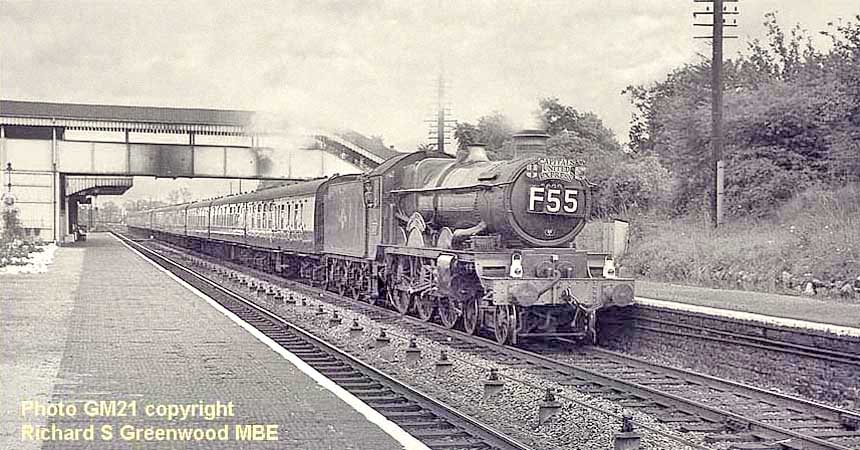

(Above-Below) Sporting a Worcester (85A) shedplate on its polished smokebox door, 'Grange class No 6807 Birchwood Grange approaches Tilehurst with a Nottingham train. Built in September 1936, No 6807 was withdrawn from Worcester in December 1963 and scrapped at King & Son of Norwich. (Below) One of Collett's thirty 'Modified Halls' in the (79XX) 7900-7929 numbered series passes Tilehurst with a Newcastle-Bournemouth train. Built in February 1950, No 7911 was named Lady Margaret Hall after one of the constituent colleges of the University of Oxford. The loco was fitted with BR type piston valves and liners in May 1957 but by the time this photo was taken in July 1961 the loco had reverted back to the WR standard. Sported an Oxford (81F) shedcode on the smokebox door, she was withdrawn from Oxford in December 1963 and scrapped at Bird's of Newport. Footnote: Founded in 1878, Lady Margaret Hall was the first women's college in Oxford; it remained a women's-only college for a hundred years until men were admitted in 1979. 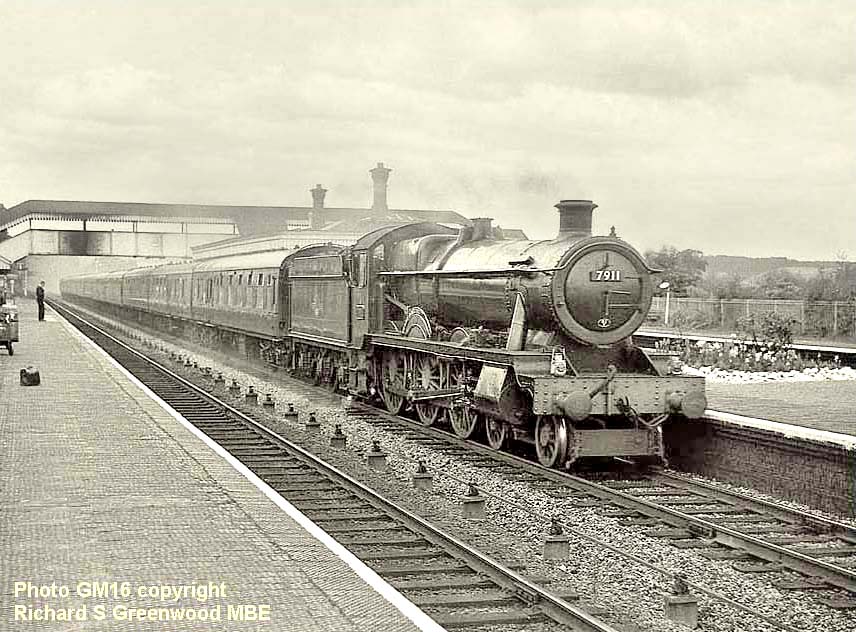
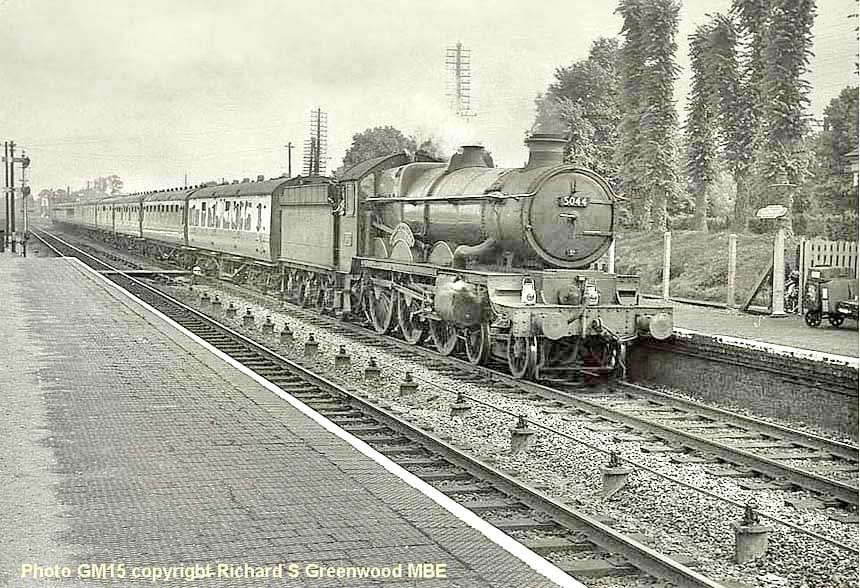
(Above-Below) 'Castle' class No 5044 Earl of Dunraven heads a down train of empty coaching stock. Originally built as Beverston Castle in March 1936, No 5044 was renamed in September 1937. Her first shed was Old Oak Common and the last shed Cardiff Canton from where she was withdrawn in April 1962. (Below) 'Castle' Class No 5093 Upton Castle heads an up parcels at Tilehurst. Built June 1939, the loco's first (and last) shed allocation was 81A Old Oak Common, from where she was withdrawn September 1963.

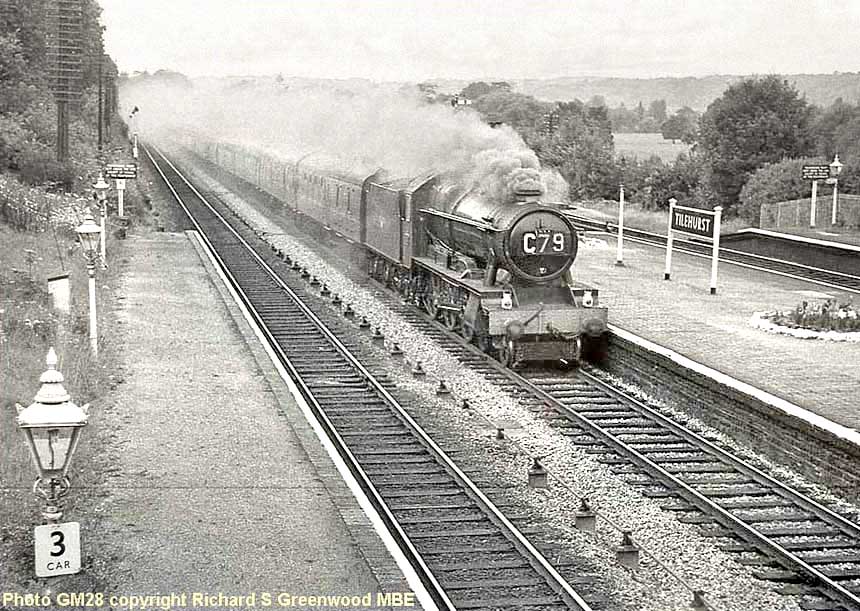
(Above) Designed by FW Hawksworth (CME at Swindon 1941-948) the last of his 'County' class - Nos 1000-1029 (the first one introduced in August 1945) became extinct in September 1964. Perhaps Western Region purists will decry this shot of a smoky 1016 County of Hants heading an up train through Tilehurst on Saturday 29th July 1961, but then it makes for a great picture! Built in March 1946, No 1016 was fitted with a modified double chimney in March 1957. The last shed allocation was Shrewsbury, from where she was withdrawn in September 1963 and scrapped at T Ward of Sheffield. 
(Below) As mentioned above, the GWR 'County' class is now extinct, but all is not lost…established in 2004, the praiseworthy aim of the 1014 County Project is to create, on behalf of the Great Western Society, a County Class locomotive. To achieve this goal the Great Western Society has been granted ownership of major component parts from two donor locomotives: the underframes from 'Modified' Hall class locomotive No 7927 Willington Hall and the boiler from Stanier 8F locomotive No. 48518, which toether will form the basis for the reconstruction. To read the full story (so far) of this commendable project click here to visit the excellent website…maybe you can help? Built in December 1945, 'County class No 1010 County of Caernarvon approaches Tilehurst on the up relief line. No 1010 was not named until February 1948 - why did it take so long? Allocated initially to Plymouth Laira, the loco was fitted with a modified double chimney in September 1956. The last shed allocation was Bristol St. Philip's Marsh (82B) from where she was withdrawn February 1963 and scrapped at Swindon Works..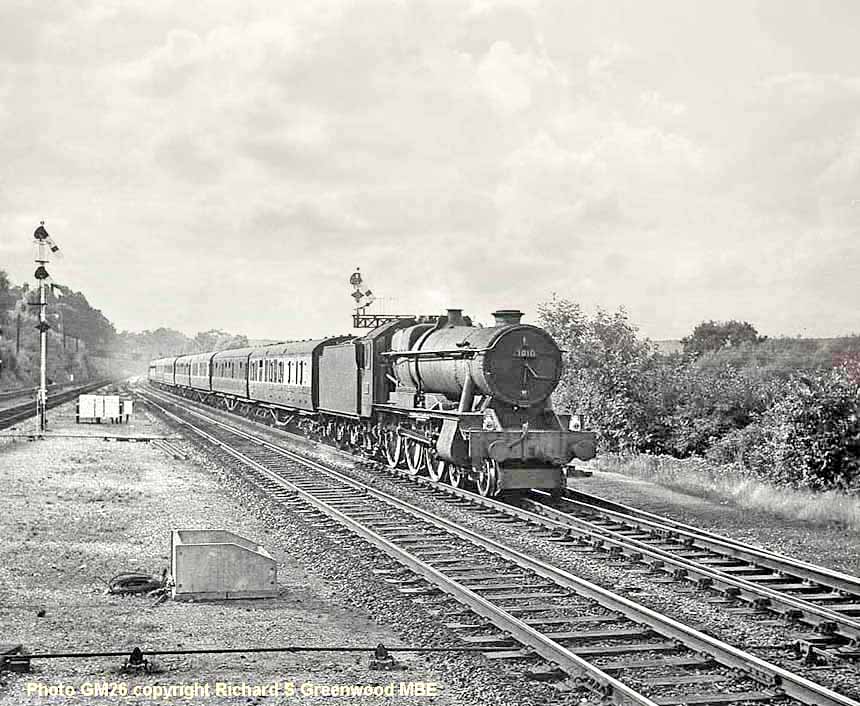
AROUND THE REGION - 2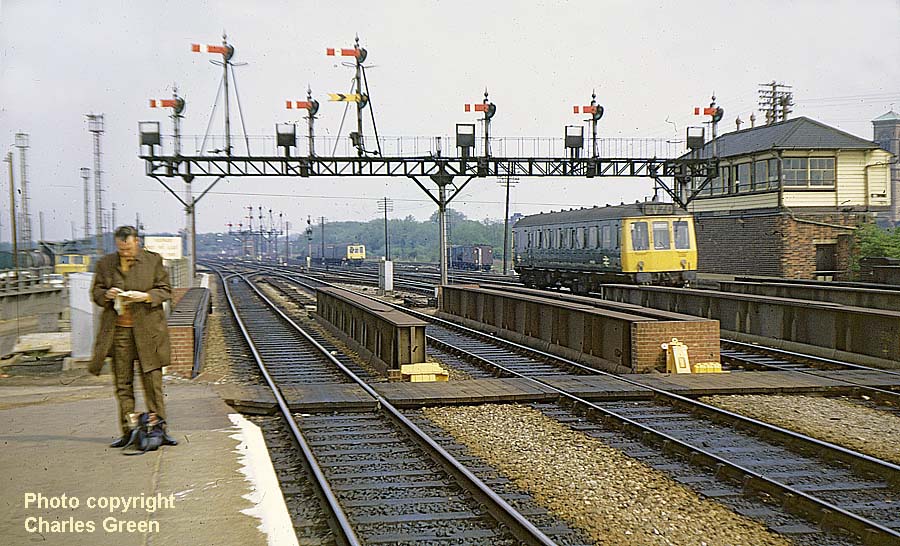


(Above-Below) One for modellers...rear view of Hawksworth's 'County' Class 6MT No 1028 County of Warwick at Bristol in 1960. (Below) Sporting a Danygraig (87C) shedplate on the smokebox door, Class 3F 0-4-0T No 1105 was one of six engines (Nos 1101-6) built by Avonside Engine Co based on a design to GW requirements for dock shunting. Introduced in 1926 No 1105 is still going strong thirty-odd years later on 14th March 1957. Weighing just 38 tons 4 cwt, the engines had a tractive effort of 19,510lbs.
(Above-Below) Another Danygraig loco, 0-4-0ST No 1151 - one of 2 members in the class - was photographed on 14th March 1957 some fifty years after its introduction in 1907. Weighing just 33 tons 10cwt with a tractive effort of 14,010 lbs, this Class 0F Peckett design was built for the P & M.
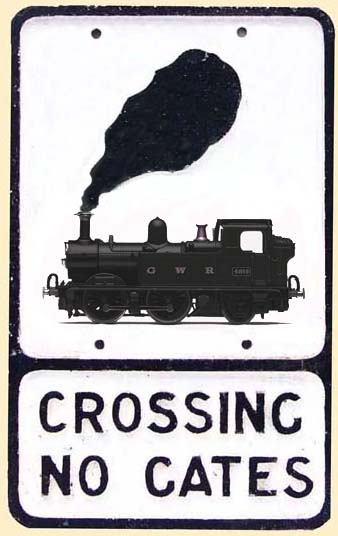 (Above-Below) Take a butchers at this shot! Is it any wonder that Western Region fans dubbed their beloved Great Western Railway - 'God's Wonderful Railway'? Taken before nationalisation, Churchward's Class 0F 0-6-0ST No 1362 - built in 1910 specifically for negotiating severe curves during dock shunting duties rests at Newton Abbot shed. Photo copyright L Hanson. (Below) But even older is this diminutive 0-4-0 locomotive 'Tiny' built in 1868 by Sara & Co. The 2-cylinder loco began life as a shunter on the Sutton Harbour Branch at Plymouth and then moved to Newton Abbot until 1883 where she ended her days as a stationary water pumping engine at Newton Abbot locomotive works until the 1920s. After retirement this grand old lady was displayed on the platform at Newton Abbot Station for many years and is the only broad gauge locomotive to survive to the present day. 'Tiny' now forms part of the National Collection at the South Devon Railway Museum in the former goods shed at Buckfastleigh Station.
(Above-Below) Take a butchers at this shot! Is it any wonder that Western Region fans dubbed their beloved Great Western Railway - 'God's Wonderful Railway'? Taken before nationalisation, Churchward's Class 0F 0-6-0ST No 1362 - built in 1910 specifically for negotiating severe curves during dock shunting duties rests at Newton Abbot shed. Photo copyright L Hanson. (Below) But even older is this diminutive 0-4-0 locomotive 'Tiny' built in 1868 by Sara & Co. The 2-cylinder loco began life as a shunter on the Sutton Harbour Branch at Plymouth and then moved to Newton Abbot until 1883 where she ended her days as a stationary water pumping engine at Newton Abbot locomotive works until the 1920s. After retirement this grand old lady was displayed on the platform at Newton Abbot Station for many years and is the only broad gauge locomotive to survive to the present day. 'Tiny' now forms part of the National Collection at the South Devon Railway Museum in the former goods shed at Buckfastleigh Station.
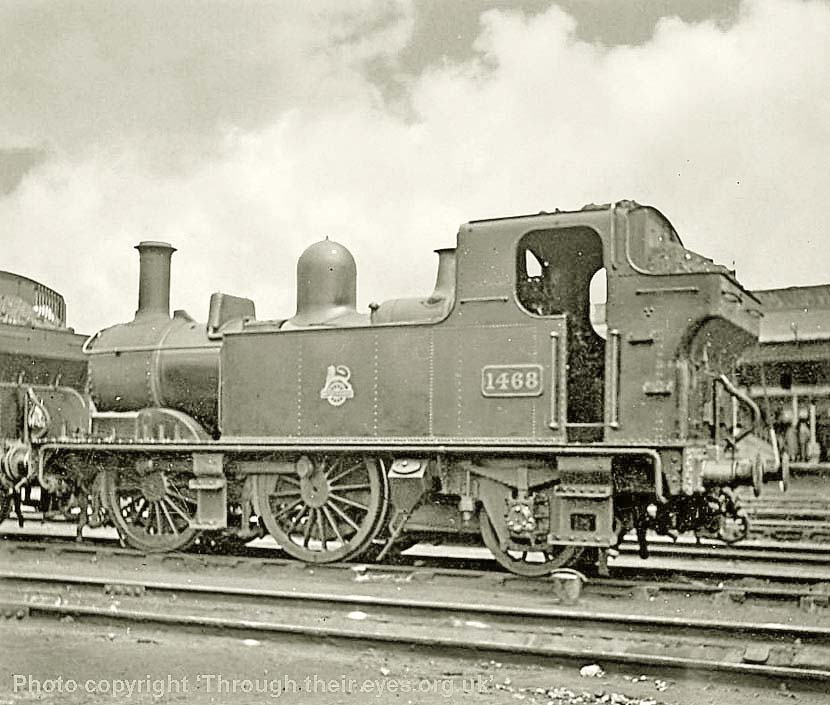
(Above-Below) CB Collett's 1400 Class 0-4-2T No 1468 on shed at Exeter (83C). (Below) Churchward's successor, CB Collett (1921-1941) was responsible for 17 new locomotive classes, including the Castles, Kings, Granges, Manors and Hall classes. Although his predecessor was a hard act to follow, Collett took the sensible step of improving on Churchward's successful formula, therefore many of his locomotives were of a modified designs as distinct from rebuilds. These included the modified Class 28xx 2-8-0 variants Nos 3800-66 introduced in 1938. Sporting a smokebox numberplate and a Newton Abbot (83A) shed plate, No 3834 is seen with Prairie tank No 5104 and Pannier tank No 8405 at Leamington shed in July 1955.Photo © P R Batty.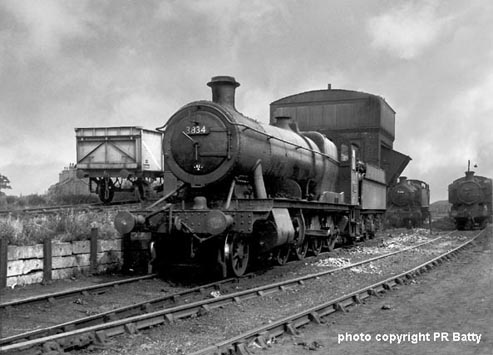
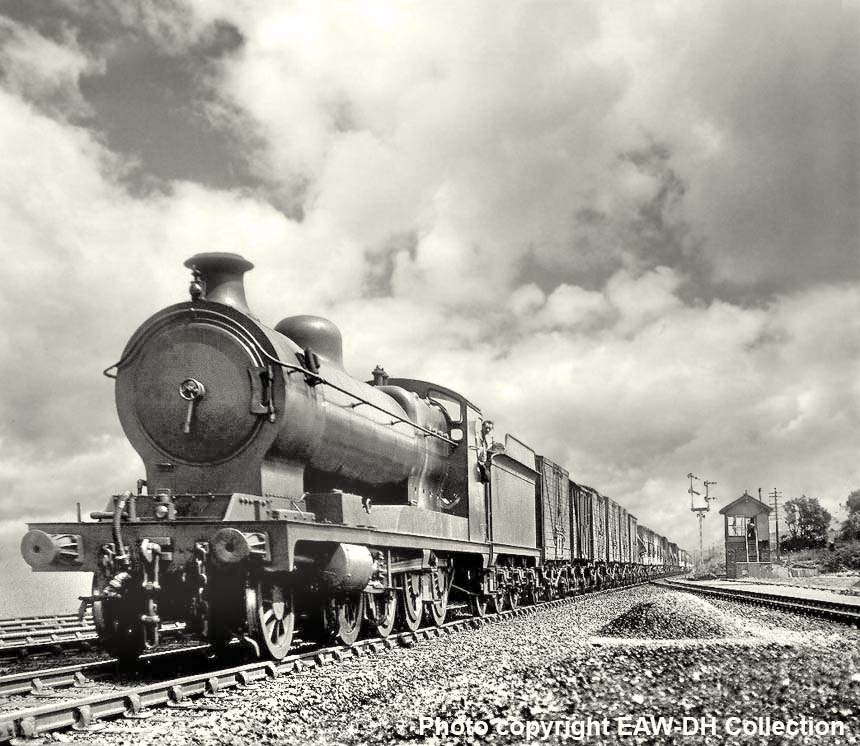
(Above-Below) The heavy gang! In 1911, J. G. Robinson, then Chief Mechanical Engineer of the Great Central Railway between 1900-22, designed a 2-8-0 heavy freight engine in anticipation of the additional traffic being generated by the company's new docks at Immingham and a large marshalling yard at Wath-on-Dearne in the South Yorkshire coalfield. At the outbreak of the First World War, the Robinson 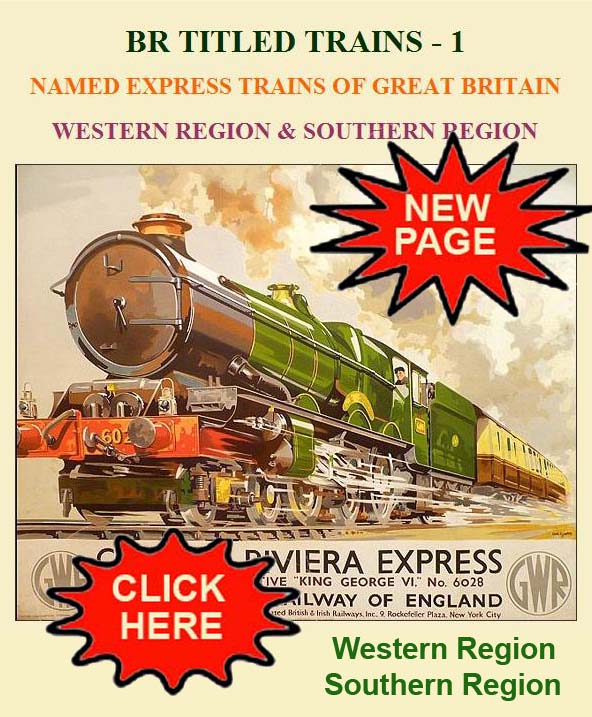 design was chosen by the British Army for war service overseas, and a total of 344 was ordered for the Railway Operating Division (ROD) of the Royal Engineers, which commenced operations in Continental Europe in February 1916. It was originally intended to use French and Belgian locomotives but both of these countries intentionally kept their locos away from the Front, hence a variety of British locomotives were quickly conscripted. Then it was decided that standardisation was needed and the Robinson GCR 2-8-0 was adopted. After grouping, no fewer than 421 locos were acquired by the LNER and some were taken into GWR stock immediately after the First World War. Numbered in the 30XXs, they were subsequently fitted with standard GW chimneys, safety valve casings and other boiler mountings - and, as it turned out, they were so well liked by GW railwaymen that they quickly became a standard GW type...indeed it could be argued that the Robinson 2-8-0 was the most successful heavy freight engines of all time. Doubtless I'll be pilloried for saying it on the Western Region page! Click here to visit the excellent LNER Encyclopedia site.
design was chosen by the British Army for war service overseas, and a total of 344 was ordered for the Railway Operating Division (ROD) of the Royal Engineers, which commenced operations in Continental Europe in February 1916. It was originally intended to use French and Belgian locomotives but both of these countries intentionally kept their locos away from the Front, hence a variety of British locomotives were quickly conscripted. Then it was decided that standardisation was needed and the Robinson GCR 2-8-0 was adopted. After grouping, no fewer than 421 locos were acquired by the LNER and some were taken into GWR stock immediately after the First World War. Numbered in the 30XXs, they were subsequently fitted with standard GW chimneys, safety valve casings and other boiler mountings - and, as it turned out, they were so well liked by GW railwaymen that they quickly became a standard GW type...indeed it could be argued that the Robinson 2-8-0 was the most successful heavy freight engines of all time. Doubtless I'll be pilloried for saying it on the Western Region page! Click here to visit the excellent LNER Encyclopedia site.
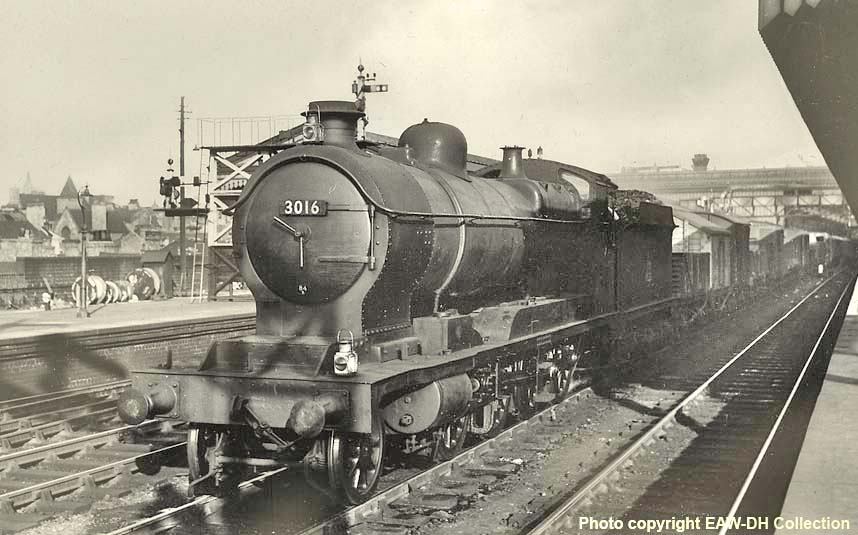

BRISTOL TEMPLE MEADS STATION
Memories of George Heiron's photos in 'Trains Illustrated'
by David Hey
One of the most rewarding parts of building a website is the enjoyment of its creation, but there's also another reason…confessional time now! It gives me the chance to resolve a lifelong dream from 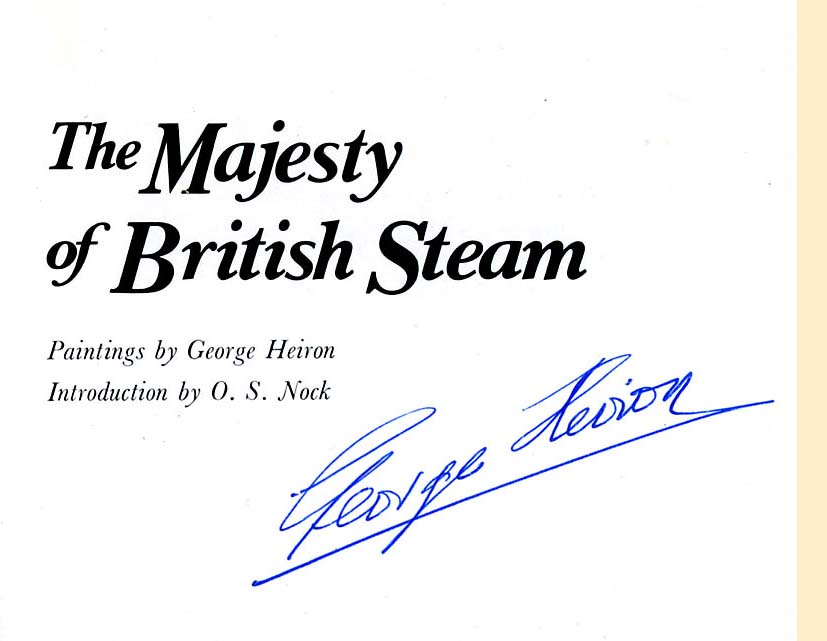 childhoodof morphing into an editor for 'Trains Illustrated' magazine! Many 1950's spotters will have fond memories of the photo features that appeared in the monthly 'Trains Illustrated'; they were headed by such titles as 'Assault of Shap', 'Sojourn at York' or 'Interlude at Crewe'.
childhoodof morphing into an editor for 'Trains Illustrated' magazine! Many 1950's spotters will have fond memories of the photo features that appeared in the monthly 'Trains Illustrated'; they were headed by such titles as 'Assault of Shap', 'Sojourn at York' or 'Interlude at Crewe'.
Some will recall the December 1957 issue which featured seven pages of George Heiron's superb Western Region photos taken in the Bristol area; it came under the heading 'Bristol Album'.
Getting to the point...there are no George Heiron photos on this page, but there are quite a few shots of Bristol Bath Road Steam Shed which will doubtless strike a chord with ex-spotters who remember visiting Temple Meads in the twilight days of steam.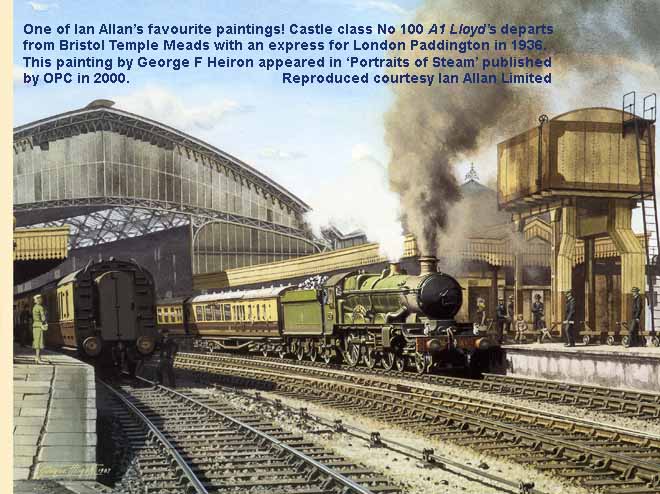 (Inset Above) A treasured book I still have today is 'The Majesty of British Steam' featuring the railway paintings of George F Heiron published by Ian Allan Ltd in 1973. The great man kindly signed it for me during a Railart Exhibition at Leamington Spa. (Inset Right) Another all-time favourite book is 'Portraits of Steam' featuring the paintings and photographs of George F Heiron published by Ian Allan in 2000. The book includes this George Heiron painting of a 'Castle' class departing Bristol Temple Meads in 1936. Comparisons to be made with ER Morten's shot (below) of 'Castle' class No 5076 Gladiator awaiting departure with a train for Paddington on 2nd April 1951.
(Inset Above) A treasured book I still have today is 'The Majesty of British Steam' featuring the railway paintings of George F Heiron published by Ian Allan Ltd in 1973. The great man kindly signed it for me during a Railart Exhibition at Leamington Spa. (Inset Right) Another all-time favourite book is 'Portraits of Steam' featuring the paintings and photographs of George F Heiron published by Ian Allan in 2000. The book includes this George Heiron painting of a 'Castle' class departing Bristol Temple Meads in 1936. Comparisons to be made with ER Morten's shot (below) of 'Castle' class No 5076 Gladiator awaiting departure with a train for Paddington on 2nd April 1951.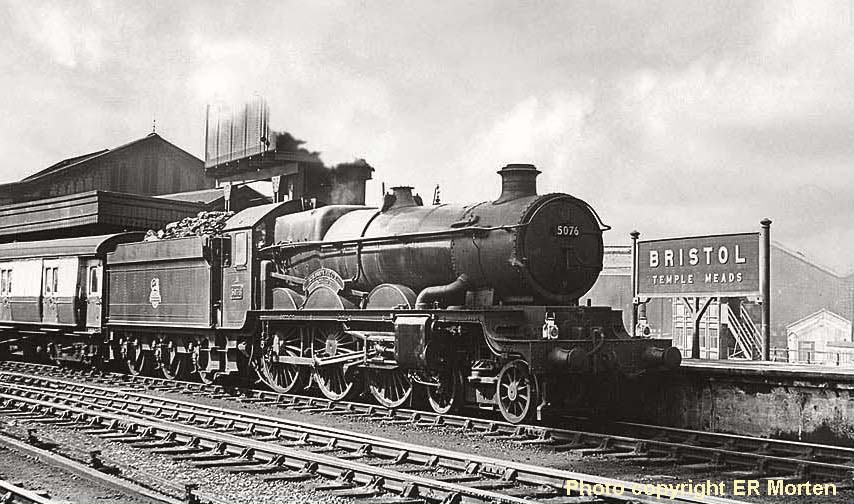
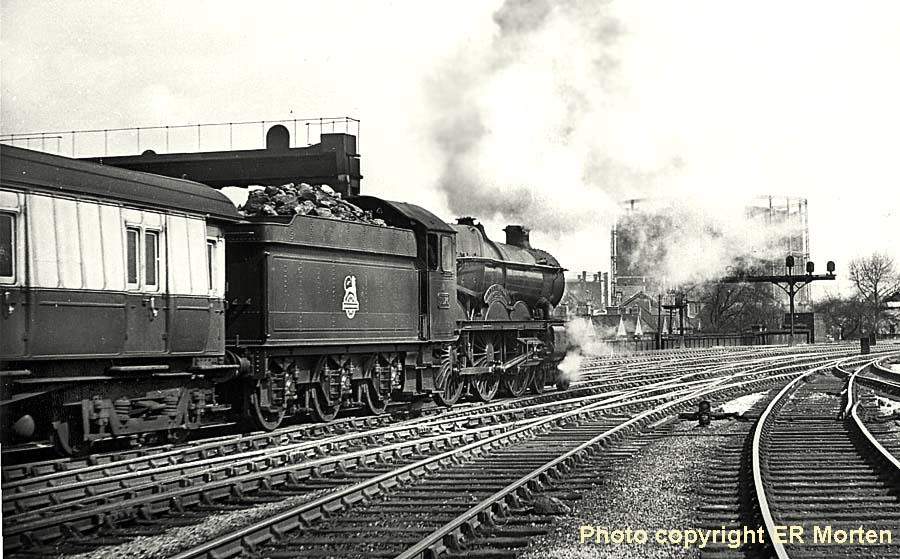
(Above) ER Morten's 'going away' shot shows 5076 making a spirited exit from Bristol Temple Meads in April 1951. Opened on 31st August 1840, Temple Meads station was designed by Isambard Kingdom Brunel as the western terminus of the Great Western Railway from London Paddington. The station was subsequently used by the Bristol and Exeter Railway, the Bristol and Gloucester Railway, the Bristol Harbour Railway and the Bristol and South Wales Union Railway. To accommodate the increased traffic the station was expanded in the 1870s by Francis Fox, and again in the 1930s by P E Culverhouse. Brunel's original terminus is no longer part of the operational station the site and has since become Grade 1 listed.
(Above) During the early 1950s Bristol Bath Road had an allocation of 93 locomotives, practically all devoted to passenger traffic whereas goods traffic was handled by St Philip's Marsh (82B) which had an allocation of over 140 locomotives. A trio of 'Castle' class locos Nos 5032 Usk Castle, 5092 Tresco Abbey and 5090 Neath Abbey are prepared for duty at 82A. 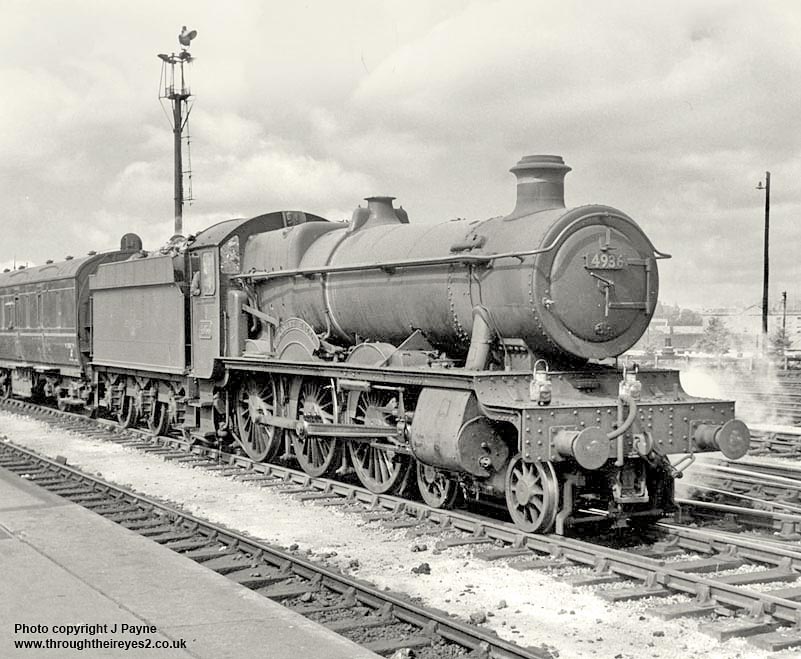
(Above-Below) Hall class No 4936 Kinlet Hall departs with a parcels train. It should be pointed out that some of the photos on this page are reproduced courtesy of Jim Payne's CD which is available from 'www.throughtheireyes2.co.uk'...link at the bottom of page. I am not affiliated with the sale of CDs in any way, merely reproducing what I think are interesting images of Western Region steam for the benefit of model engineers, railway modellers and artists. So many photos show details of locos in varying stages of weathering, unusual freight loads, trackwork and other paraphernalia associated with a busy yard. I must also mention that some images, excellent though the originals are, have been digitally enhanced with sky tones for reproduction exclusively on this website. The subject of Photoshopping can be found on the 'Rail Photo Workshop' Page 46 of this site. (Below) Introduced in 1911, Churchward's 43XX Class 4MT 2-6-0s (GW Power Classification D, route availability Blue) were employed on mixed traffic work on almost all parts of the former GWR system; No 6323 looks in a sorry state at Bristol in 1960.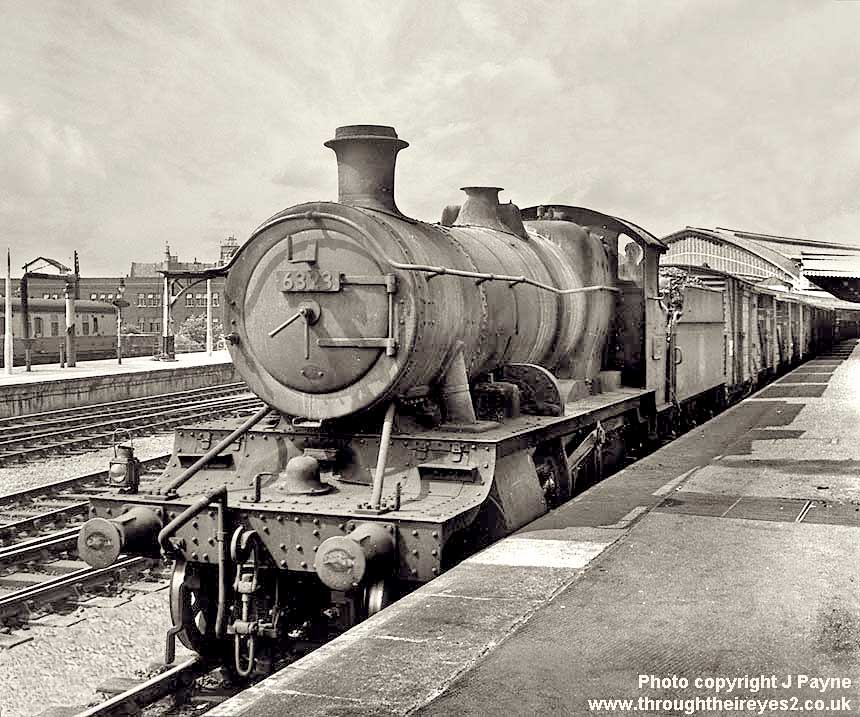
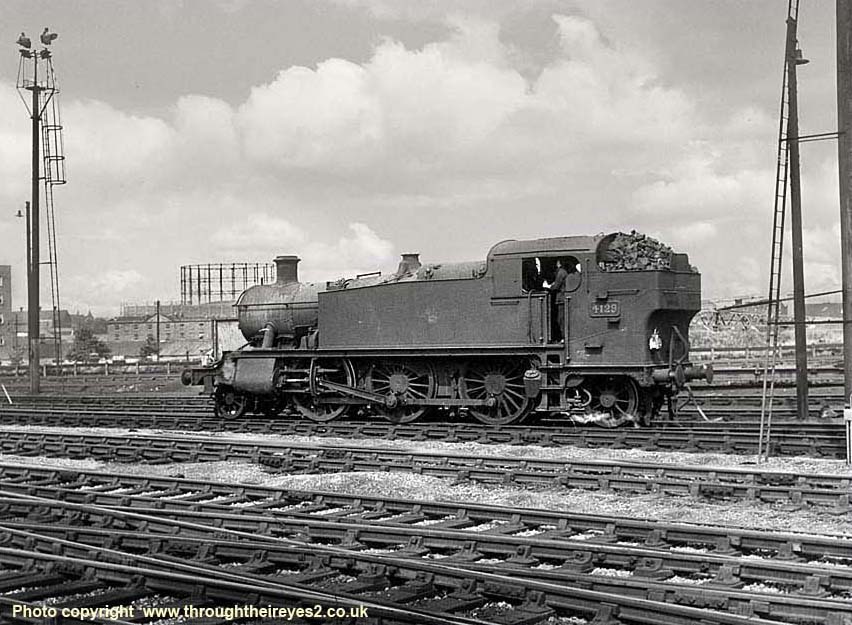
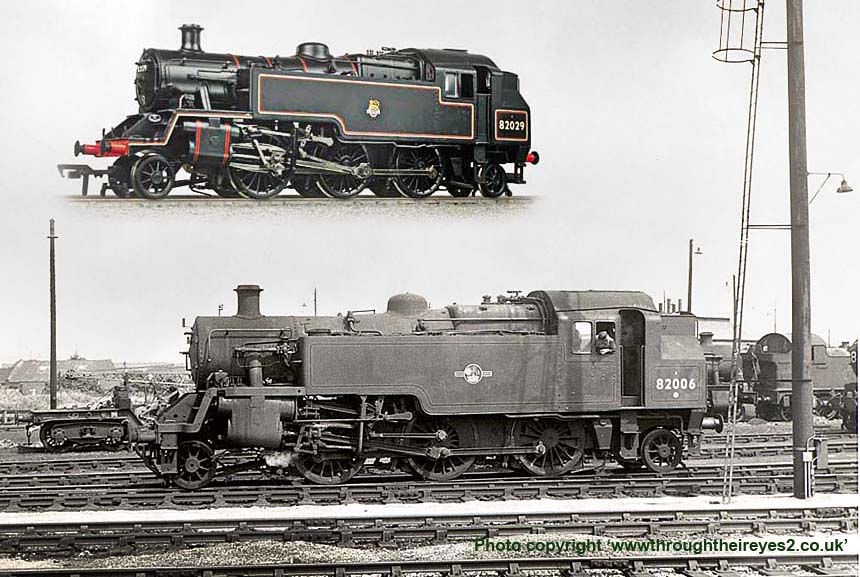
Between 1930 and 1935 Temple Meads station was expanded eastwards over the old cattle market, and southwards on a new wider bridge across Cattle Market Road and the New Cut of the River Avon. This made room for the addition of five new through platforms, while the removal of the narrow island platforms in the middle of the train shed allowed the main Up and Down platforms to be both widened and lengthened. All the routes approaching Temple Meads were widened to four tracks to allow more flexibility. As part of the modernisation, the four manual signal boxes were replaced by three new Power Signal Boxes, the old semaphore signals replaced by colour light signals and the mechanical point linkages exchanged for point motors. The new Bristol Temple Meads East box was the largest with 368 miniature levers operated by three signalmen, whilst the remaining two boxes were at Bristol Temple Meads West, and one adjacent to the station controlling the movements in and out of the Bath Road Depot. (Below) Introduced to traffic on 30th April 1938, 'Castle' class No 5093 Tresco Abbey was withdrawn from traffic at Cardiff East Dock on 31st July 1963 and disposed of at Cashmores, Newport in October the following year.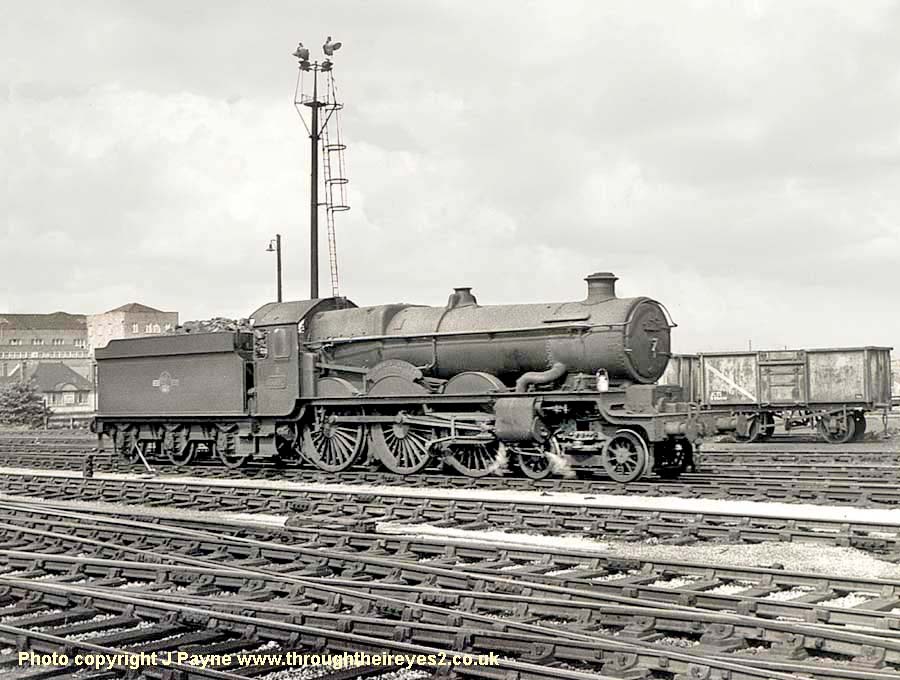
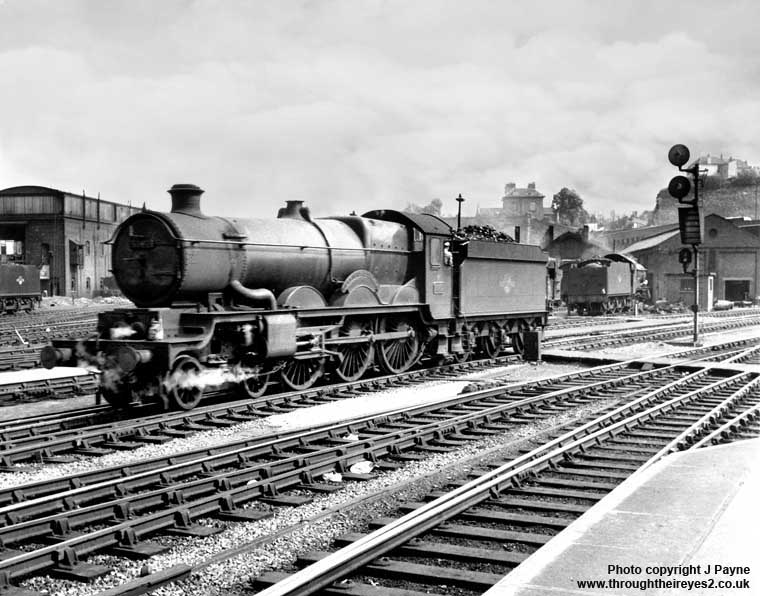

(Above-Inset-Below) It was a fifty-fifty decision on whether to feature this train headboard on the 'BR London Midland Region' page or the 'BR Western Region' page, but in the end it was decided to use it on both pages. After all 'The Devonian' was an inter-regional titled train that originated in 1927 and initially applied to the Bradford-Torquay and Paignton section of through coaches, handed over by the LMS to the GWR at Bristol Temple Meads. Following the LMS Midland Division accelerations of 1937 the train departed  Bradford at 10:25am arriving Torquay at 6:44pm and Paignton at 6:51pm. The northbound train left Paignton at 9:15am arriving Bradford at 5:54pm. The service came to an end at the outbreak of World War 2, but was restored in October 1946, albeit with an increased journey time. This was not improved upon until the introduction of diesel haulage and the journey time was reduced to just over 8 hours. Latterly a Restaurant Car service was provided between Leeds and Paignton. Here Holbeck's 'Jubilee' class No 45605 Cyprus couples onto the stock of the 'Devonian' at Bristol Temple Meads in June 1960. On 10th September 2011, a cast aluminium BR(M) 'Devonian' headboard measuring 36" x 12½" was sold at Sheffield Railwayana Auctions for £4,500. For serious students of Britain's railway history the auction catalogues provide some fascinating background details on the items for sale. For example, the back metal of the 'Devonian' headboard (right) was stamped with the legend 'Train Name Board W786 26-4-49'. Similar inscriptions applied to the names of other headboards produced to the same dimensions, such as: 'The Red Rose', 'The Red Dragon', 'The Bristolian' and the 'Inter-City'. The back was also stamped with the word 'Bristol' indicating the owning depot. To visit the interesting Sheffield Railwayana website click here
Bradford at 10:25am arriving Torquay at 6:44pm and Paignton at 6:51pm. The northbound train left Paignton at 9:15am arriving Bradford at 5:54pm. The service came to an end at the outbreak of World War 2, but was restored in October 1946, albeit with an increased journey time. This was not improved upon until the introduction of diesel haulage and the journey time was reduced to just over 8 hours. Latterly a Restaurant Car service was provided between Leeds and Paignton. Here Holbeck's 'Jubilee' class No 45605 Cyprus couples onto the stock of the 'Devonian' at Bristol Temple Meads in June 1960. On 10th September 2011, a cast aluminium BR(M) 'Devonian' headboard measuring 36" x 12½" was sold at Sheffield Railwayana Auctions for £4,500. For serious students of Britain's railway history the auction catalogues provide some fascinating background details on the items for sale. For example, the back metal of the 'Devonian' headboard (right) was stamped with the legend 'Train Name Board W786 26-4-49'. Similar inscriptions applied to the names of other headboards produced to the same dimensions, such as: 'The Red Rose', 'The Red Dragon', 'The Bristolian' and the 'Inter-City'. The back was also stamped with the word 'Bristol' indicating the owning depot. To visit the interesting Sheffield Railwayana website click here

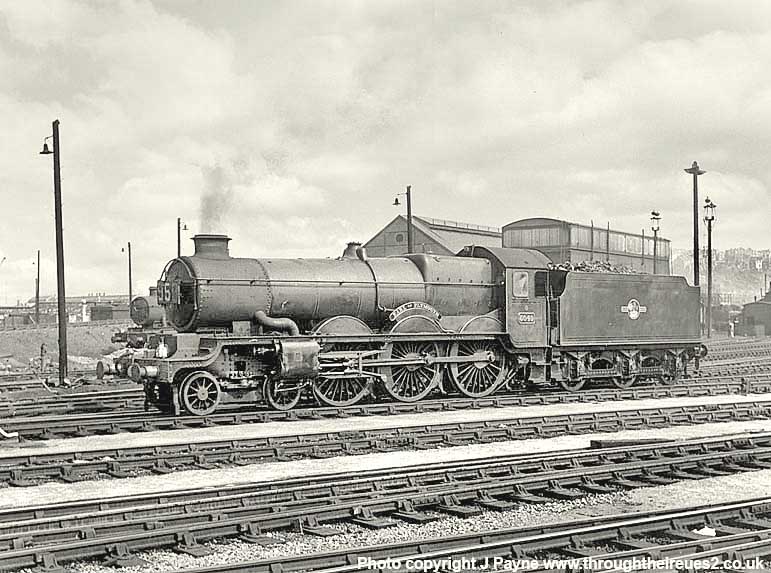
(Above-Below) This is the view of Bristol Bath Road Locomotive Depot from Platform 12 at Temple Meads Station, a scene familiar to young spotters during the 1950s. Bristol Bath Road Shed (coded 82A) was then the principal depot of the Western Region's Bristol Division before it closed to steam on 12th September 1960 and the site subsequently became a Diesel Depot up to 28th September 1995. Platform 12 gave spotters the chance to watch the activities of locos coming and going at the shed. Here 'Castle' class No 5049 Earl of Plymouth (with double chimney and Hawsworth tender) and the single-chimneyed No 5050 Earl of St Germans were photographed in 1960. (Below) 'King' Class No 6024 King Edward 1, with reversed titled train headboard above its smokebox door, receives attention in 1960.
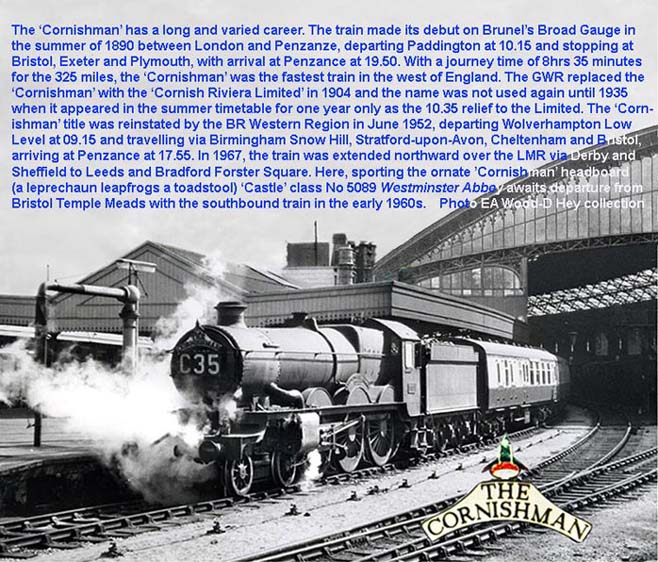
(Above) Corrections to errors in captions are always welcome, so my thanks to John D, who writes - 'Hi David, a great website with loads of useful information, thank you….on Page 21 you have a picture of the 'Cornishman' (posted above). The beautiful curved roof is on the north side of the station, so this must be the east end, in which case this is actually the northbound train sporting the southbound reporting number! Someone obviously forgot to change it from the morning run. This is not the case in the previous picture where, behind the 'King' (with the reversed headboard) is a 'Castle' class that has been turned and carries the correct reporting number for the northbound 'Cornishman' at that time (Summer 1959 timetable). Hope this helps. Best regards…
Yes it does, thanks John.
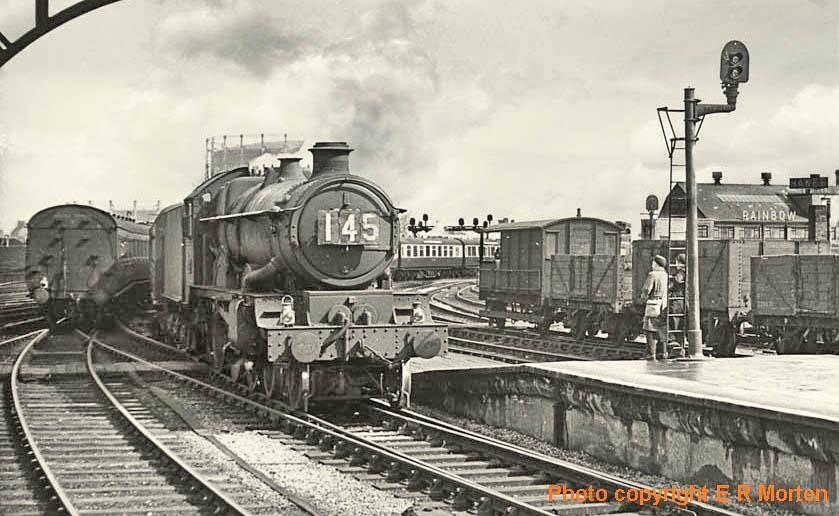
(Above-Below) Trains coming and going at Bristol Temple Meads. A couple of spotters watch the arrival of 'Castle' class No 7022 Hereford Castle on 2nd April 1951 (Below) The standardisation policy pursued by GJ Churchward during his tenure as GWR's CME (1902-1921) led to a range of mixed traffic locomotive classes sharing a small number of standard components that were suitable for a majority of duties. Similar to a 'Hall' class, but with smaller coupled wheels and footplate raised over cylinders, a total of eighty members of the 'Grange' class 4-6-0s were built at the Swindon works numbered 6800-6879 in the fleet; the GWR power classification was 'D' and the route availability colour coded red (the class became 5MT during BR days). Here, the penultimate member, No 6878 Longford Grange, has an ample supply of coal, almost dangerously overloaded one might say; it looks as if half the cab is filled with the black stuff!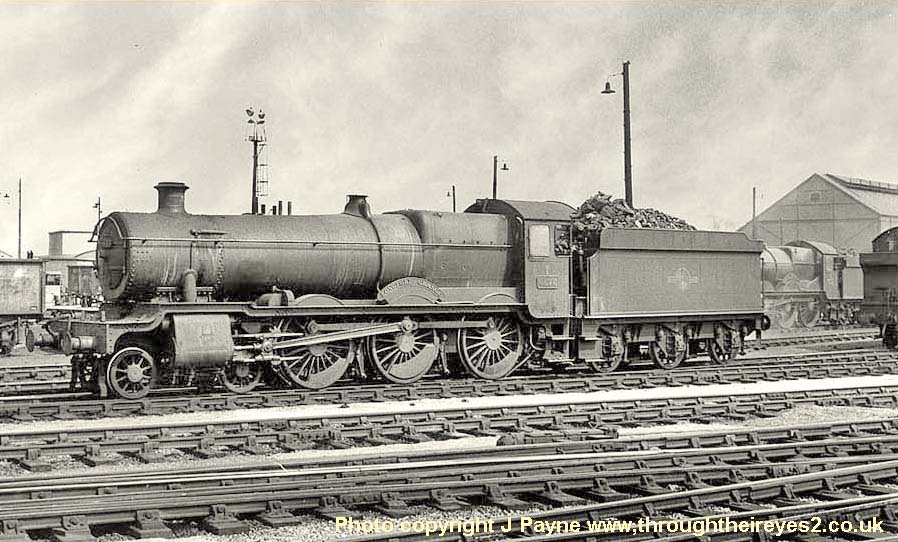

(Above-Below) Here we feature just two of the 'Castle' class locomotives to be saved from the cutters torch; in all eight members have survived in preservation; they are 4073 Caerphilly Castle, 4079 Pendennis Castle, 5029 Nunney Castle, 5043 Earl of Mount Edgcumbe, 5051 Earl Bathurst, 5080 Defiant, 7027 Thornbury Castle and 7029 Clun Castle. (Above) No 4079 Pendennis Castle was among the first batch of ten 'Castles' to be built in 1923-4; the loco emerged from Swindon Works on 4th March 1924 and was allocated to Old Oak Common shed. The locomotive became famous in 1925 when the GWR loaned her to the LNER as part of comparison trials with Gresley's new A1 Pacific Class Pacific, later Class A3. During a number of test runs on the ECML out of King's Cross, she made the ascent to Finsbury Park regularly in less than six minutes, a feat the Pacifics were unable to match. Pendennis Castle also proved to be more economical in both coal and water consumption. Before returning to the GWR, the locomotive was displayed alongside Gresley's Flying Scotsman at the second Wembley Exhibition between May and October 1925. In August 1950 she was allocated to Gloucester shed, then to Bristol (Bath Road) in March 1959; her final shed allocation was Bristol (Saint Philip's Marsh) from where she was withdrawn in May 1964. (Below) Built at Swindon Works in May 1950, 7029 Clun Castle was allocated new to Newton Abbot shed; its last shed allocation being Gloucester in May 1965. Following withdrawal in December of that year the loco was bought for £2,400 (its scrap value) by Patrick Whitehouse in 1966, since then its ownership has passed to 7029 Clun Castle Ltd based at Tyseley TMD, now Tyseley Locomotive Works.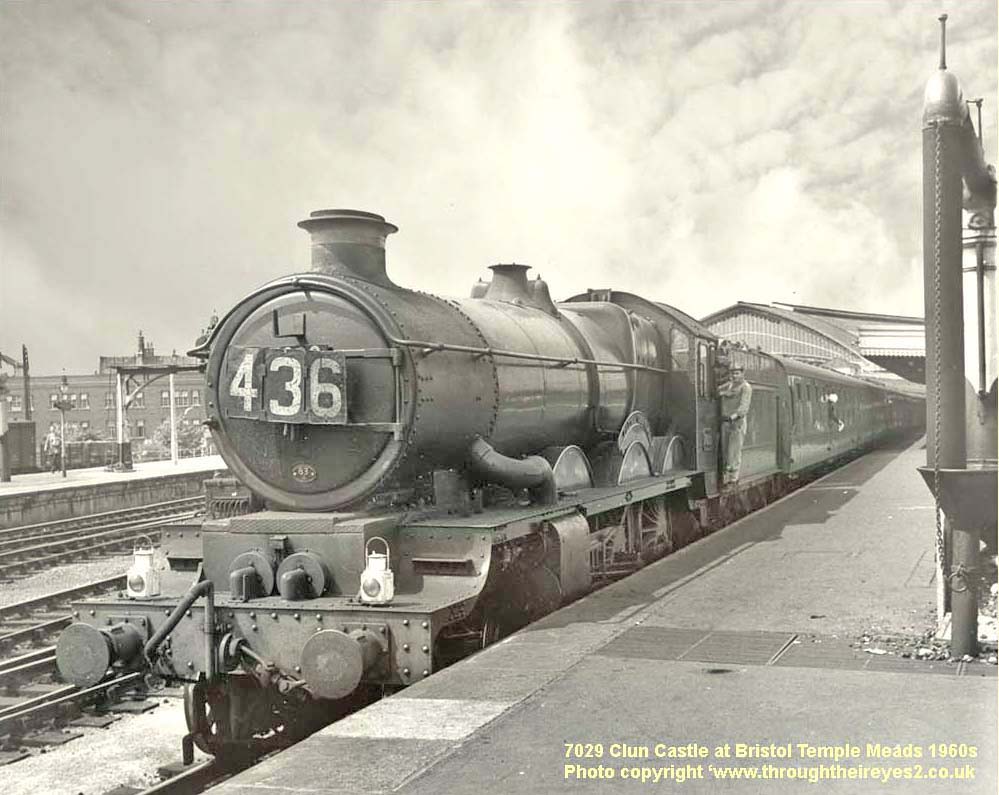
AROUND THE REGION - 3

(Above-Below) A variant of Churward's earlier 4500 Class 2-6-2T introduced in 1906, was the 4575 class (later known as the 55XX class) introduced in 1927 with larger side tanks with a sloping front at the front end. Here  No 5531 is seen at Plymouth in 1960. (Below) A lesson in 'panning' shots - 'King' Class 4-6-0 6009 King Charles II approaches Bentley Heath Crossing with the 4.30pm Wolverhampton-Paddington express on Sunday 5th July 1959. By the middle of the 1960s, the entire class of Kings, Duchesses, Princess Royals, and Schools became casualties of th e diesel era, leaving just 4,970 steam locomotives at the end of 1964. At the same time, The closure of steam motive power depots in the new inter-regional shed-code renumbering scheme was to radically change the scene. The revision of the six regional boundaries led to the closure of the former Great Central line from Sheffield to London after it was transferred from the ER to the LMR. The same fate befell the Somerset & Dorset line over the Mendips when it was transferred from the SR to the WR. Inevitably train services were deliberately run down to facilitate closure, and both routes were destined not to survive the Beeching era…Photo © M Mensing
No 5531 is seen at Plymouth in 1960. (Below) A lesson in 'panning' shots - 'King' Class 4-6-0 6009 King Charles II approaches Bentley Heath Crossing with the 4.30pm Wolverhampton-Paddington express on Sunday 5th July 1959. By the middle of the 1960s, the entire class of Kings, Duchesses, Princess Royals, and Schools became casualties of th e diesel era, leaving just 4,970 steam locomotives at the end of 1964. At the same time, The closure of steam motive power depots in the new inter-regional shed-code renumbering scheme was to radically change the scene. The revision of the six regional boundaries led to the closure of the former Great Central line from Sheffield to London after it was transferred from the ER to the LMR. The same fate befell the Somerset & Dorset line over the Mendips when it was transferred from the SR to the WR. Inevitably train services were deliberately run down to facilitate closure, and both routes were destined not to survive the Beeching era…Photo © M Mensing
(Above) A rather grimy 'Hall' class No 5971 Merevale Hall was photographed at Wolverhampton Oxley Road Shed (84B) on 31st March 1965. By this time, the diesel-hydraulics were well to the fore and in view of the deplorable working conditions, shed staff found it difficult to maintain a standard of cleanliness. In this evocative shot, the poor operating conditions are clearly evident, as the offside nameplate is missing, yet the nearside nameplate still remained in place. It begs the question whether No 5971 could have been the last WR steam loco to bear a name by this date. Indeed, with steam in rapid decline BR found it necessary to remove nameplates when their value as collectors items led to unlawful disappearances from steam depots. Doubtless this is the case here - all things considered, the WR would have removed both plates, surely? Photo © M Mensing 
(Above) 'Castle' class 4-6-0 No 5091 Cleeve Abbey was originally built as 'Star' Class No 4071 Clere Abbey (correct, similar name) in February 1923. It was one of ten 'Star' class locomotives to be rebuilt between 1937 and 1940, thereby the GWR could recover the cost by Government Grant. The completed rebuild was given a new number and new name in December 1938 and it became the first of five Castles to be converted for oil burning between October 1946 and November 1948. However due to severe foreign exchange problems the ambitious oil-burning scheme was abandoned and No 5091 subsequently converted back to a conventional coal-fired locomotive. Withdrawal came in October 1964.
UK MARSHALLING YARD PHOTOS SOUGHT...I have recently been contacted by Michael Rhodes, who is seeking images to revise his 1988 marshalling yard book - 'The Illustrated History of British Marshalling 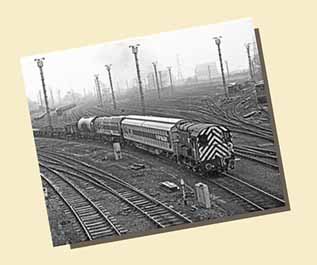 Yards'. The yard images he is short of are as followed… NE - Shildon (pre-1935), Erimus, Hull Inward, Dringhouses hump in action; EASTERN - Colwick, Dunford Bridge, humps working at Worksop, Warsop, Barrow Hill; LM - Edge Hill Gridiron, Chaddesden, Basford hall, Mottram; SOUTHERN - Feltham; WESTERN - Hump working at Swansea Burrows and Llandeilo Junction; SCOTLAND - Cadder and Alloa. He adds - 'A bit of a rag tag mixture and all somewhat hard to find, but it would be really nice to update the 1988 book with a really definitive guide to all the yards in the UK. If you are able to supply any pictures of the above then I will pay a reproduction fee of £10 per picture, plus a copy of the book when I finish it. Any help will be most welcome. With kind regards, Michael…' Michael's contact email address is mr@lapsurgeon.co.uk Please note this is not a click-on link via Outlook Express. You will have to email manually.
Yards'. The yard images he is short of are as followed… NE - Shildon (pre-1935), Erimus, Hull Inward, Dringhouses hump in action; EASTERN - Colwick, Dunford Bridge, humps working at Worksop, Warsop, Barrow Hill; LM - Edge Hill Gridiron, Chaddesden, Basford hall, Mottram; SOUTHERN - Feltham; WESTERN - Hump working at Swansea Burrows and Llandeilo Junction; SCOTLAND - Cadder and Alloa. He adds - 'A bit of a rag tag mixture and all somewhat hard to find, but it would be really nice to update the 1988 book with a really definitive guide to all the yards in the UK. If you are able to supply any pictures of the above then I will pay a reproduction fee of £10 per picture, plus a copy of the book when I finish it. Any help will be most welcome. With kind regards, Michael…' Michael's contact email address is mr@lapsurgeon.co.uk Please note this is not a click-on link via Outlook Express. You will have to email manually.
(Below) Introduced in 1902, GJ Churchward's revolutionary 'Saint' class 4-6-0 incorporated many advances in design that influenced almost every aspect of subsequent steam locomotive development at Swindon. Sadly no Saint class locomotives survived the cutters' torch, however the Great Western Society (GWS) is planning to re-create a 'Saint', a task made much easier due to the high degree of standardisation achieved at Swindon works by Churchward and his successor, C B Collett. Therefore in 1974 the GWS purchased 'Hall' class 4-6-0 No 4942 Maindy Hall from Barry Scrapyard with the intention of using it as the basis for a new 'Saint' locomotive. The frames from No 4942 have been modified and strengthened to suit the 'Saint' design and many other components, including the boiler, are being refurbished. Full Details of the Society's progress can be found on their excellent website HERE. In Richard Greenwood's super-wide view (you will have to click on twice to view the full size) No 4942 Maindy Hall approaches Reading with an up express on 1 July 1961. 
(Below) Photographed from the entrance of the car park to Tudor Grange Park (No 6857 in the WR's 6800 class) the driver of 'Hall' class 4-6-0 No 4918 Dartington Hall awaits the right away from Solihull station with a train of empty coaching stock on 3rd September 1960. This Mike Mensing shot brings back special memories for a regular site contributor, Robert Green, who used to play Par 3 golf in Tudor Grange Park and 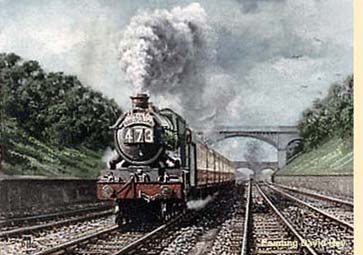 travelled by train to and from his home station of Olton, the next stop down the line from Solihull. Robert writes - 'There is something very unusual about the picture. The train is on the 'down' relief - platform 4-3 island in the background - and is thus at the rear of the train for normal direction. It may have been running wrong line due to engineering work or it may have run round after a shunting move; unusual things did happen at Solihull...' Of further interest are the two advertising hoardings beneath the bridge, which display a variety of interesting posters (from left to right) - a local Revue Bar advertising Folies Striptease three times daily; Swan Vesta matches; Ilford Film; The Regular Army (Guardians of the Peace); the WR's new Blue Pullman service between Birmingham and Paddington; Bottled Beer; Co-op Dividend Stamp and a 1960's advertising slogan I'm sure we'll all remember: the Milk Marketing Board's 'Drink-Pinta-Milka-Day' campaign. Photo © M Mensing
travelled by train to and from his home station of Olton, the next stop down the line from Solihull. Robert writes - 'There is something very unusual about the picture. The train is on the 'down' relief - platform 4-3 island in the background - and is thus at the rear of the train for normal direction. It may have been running wrong line due to engineering work or it may have run round after a shunting move; unusual things did happen at Solihull...' Of further interest are the two advertising hoardings beneath the bridge, which display a variety of interesting posters (from left to right) - a local Revue Bar advertising Folies Striptease three times daily; Swan Vesta matches; Ilford Film; The Regular Army (Guardians of the Peace); the WR's new Blue Pullman service between Birmingham and Paddington; Bottled Beer; Co-op Dividend Stamp and a 1960's advertising slogan I'm sure we'll all remember: the Milk Marketing Board's 'Drink-Pinta-Milka-Day' campaign. Photo © M Mensing
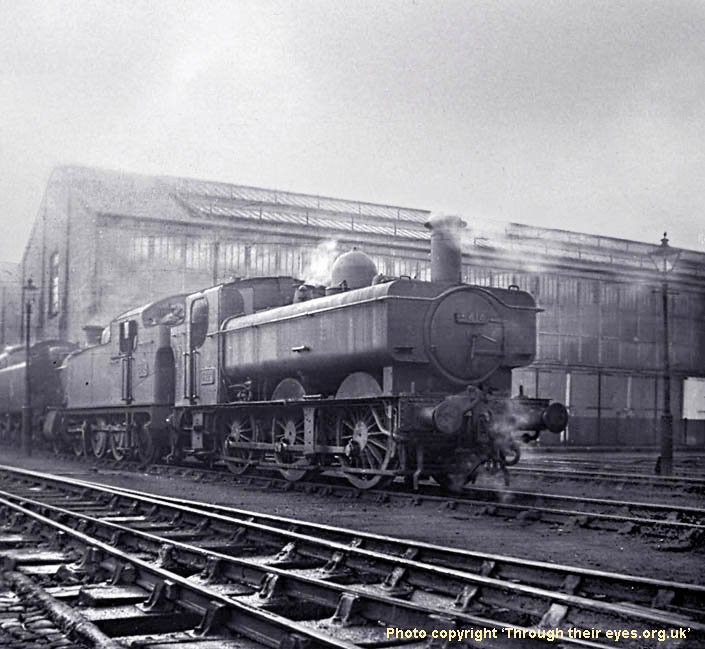 |  |
(Above Left-Right-Below) Introduced in 1931, Collett's 0-6-0PT No 5416 simmers in the shed yard at Newport (Ebbw Junction) 86A. (Above Right) Adding to the ex-GWR loco variety, CJ Churchward's '43XX' Class 4MT 2-6-0 No 6397 was photographed amid the rural environs of St Blazey shed 83E. (Below) Churchward's 2-6-2T No 4570 - one of a class of 4MT tank locos introduced in 1906 for light branch work on the GWR - heads a St Erth-St Ives train near Carbis Bay in July 1960. Photo © M Pope
(Above) BR Standard Class 4 No 76040 pauses at Machynlleth on 20th August 1966. The 'BR4' mixed traffic Moguls - numbered 76000-76114 - were derived from the ex-LMS Ivatt Mogul numbered 43000-43162, but the 'BR4' was nothing like as ugly as their progenitors. Perhaps by the time the 'BR4' appeared in traffic, those steam enthusiasts brought up on a diet of asthetically-pleasing locomotives (brass nameplates mounted on curved footplates upswept over driving wheels) had grown accustomed to the stark appearance of the new 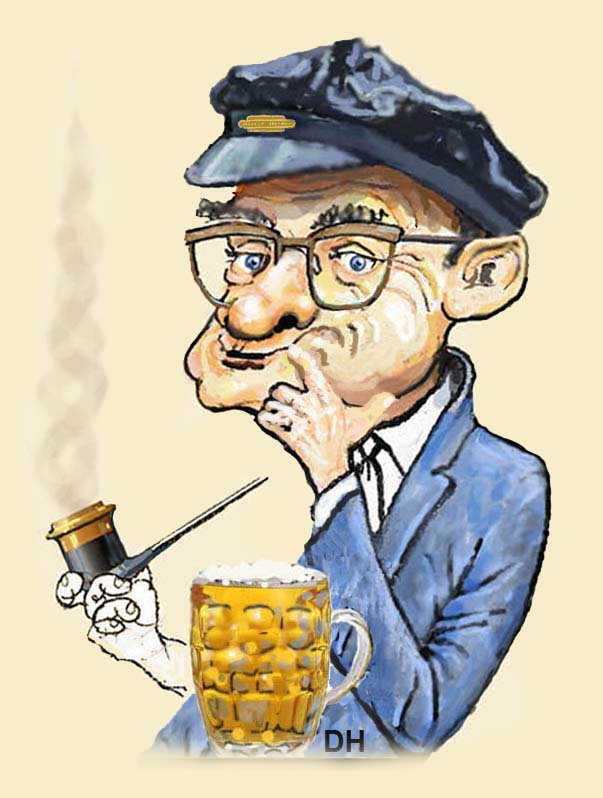 Cox/Riddles standard designs? The 'BR4s' low axle loading of under 17 tons gave them a wide route availability, but by the mid-1960s the volume of traffic on many secondary routes was rapidly decreasing and a more useful Standard Class 3 type would have sufficed. Indeed, had Churchward still been alive - or Collett, for that matter - both men would have turned in their grave at the very un-Great Western look of the new engines (Swindon Works designed and built the 'BR3' mixed traffic 2-6-0 engines Nos 77000-77019, using a slightly shortened version of the Swindon standard 'No2' boiler, as fitted to the large GWR 'Prairie' tanks (51XXs) and 0-6-2 tanks in the 56XX series). The boiler was modified to carry a dome and normal type of superheater.
Cox/Riddles standard designs? The 'BR4s' low axle loading of under 17 tons gave them a wide route availability, but by the mid-1960s the volume of traffic on many secondary routes was rapidly decreasing and a more useful Standard Class 3 type would have sufficed. Indeed, had Churchward still been alive - or Collett, for that matter - both men would have turned in their grave at the very un-Great Western look of the new engines (Swindon Works designed and built the 'BR3' mixed traffic 2-6-0 engines Nos 77000-77019, using a slightly shortened version of the Swindon standard 'No2' boiler, as fitted to the large GWR 'Prairie' tanks (51XXs) and 0-6-2 tanks in the 56XX series). The boiler was modified to carry a dome and normal type of superheater.
(Right) Following nationalisation the allegiance by railmen to the former 'Big Four' companies was well known, particularly on the Western Region!
(Below) The 2-6-0 mentioned above was essentially a tender engine version of the Swindon-built 2-6-2T 82000s, having identical driving wheels, cylinders, boiler pressure and tractive effort. The BR Standard Class 2-6-2T class offered an engine in power and axle-load midway between the Class 4MT tender engines in the 76000 series and the Class 2MT tank engines Nos 84000-29. The boiler is virtually a modified version of the Swindon 'No 2' boiler (with dome and normal type of superheater) otherwise this class was for the most part a new design. No 82043 awaits its next turn of duty at Cardiff (Cathays) 88A. Photo © J Payne proprietor of 'through their eyes.org.uk'
THANK GOODNESS FOR THE PRESERVATION MOVEMENT!
The following photos show the sterling work that goes into preserving our national heritage. The fact that almost 400 ex-BR steam locomotives have survived the 1968 holocaust is a remarkable achievement. Here is a selection of ex-GWR locos that have found a new lease of life. The photos are kindly provided by Ken Mumford, Editor of the Abergavenny and District Steam Society's 'The Coal Tank' magazine, and Terry McCarthy, who has been a member of the Great Western Society for over forty years - my thanks to both Ken and Terry for sharing their photos. 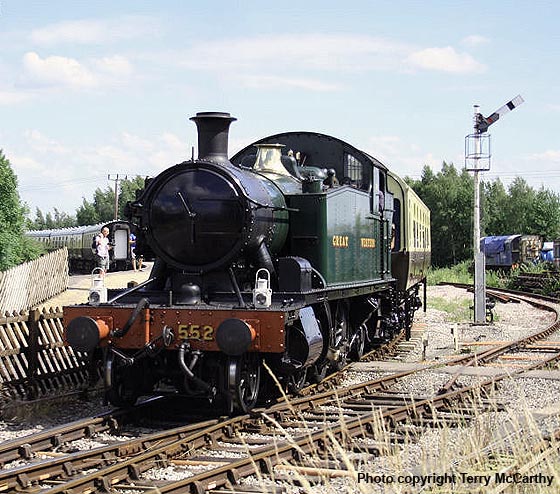
(Above-Below) 5521 departing from Lydney Junction on a train for Parkend on 3rd July 2010 in the course of the GWR 175 celebrations. 5322 in ROD livery on the 'main line' working a goods train at Didcot Railway Centre at the GWS GWR 175 celebrations 6th May 2010.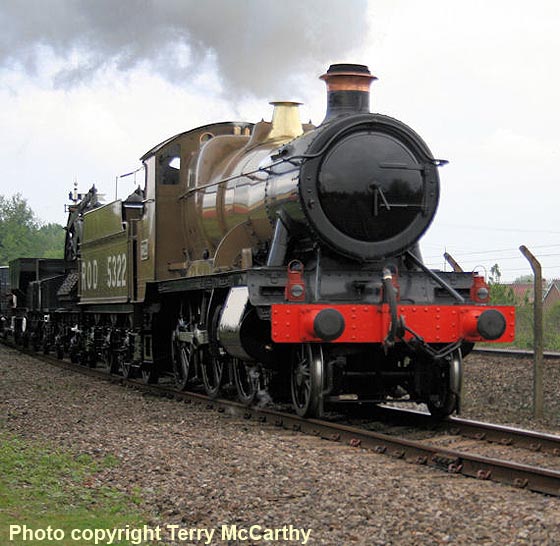
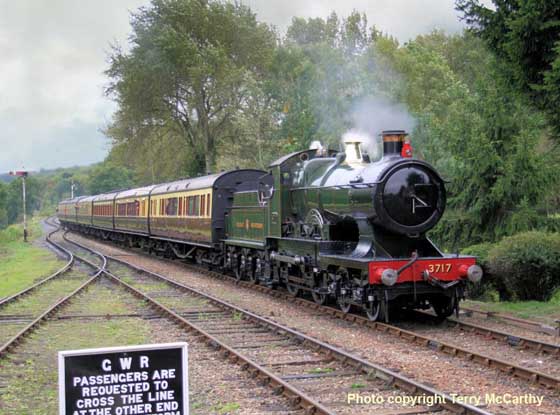

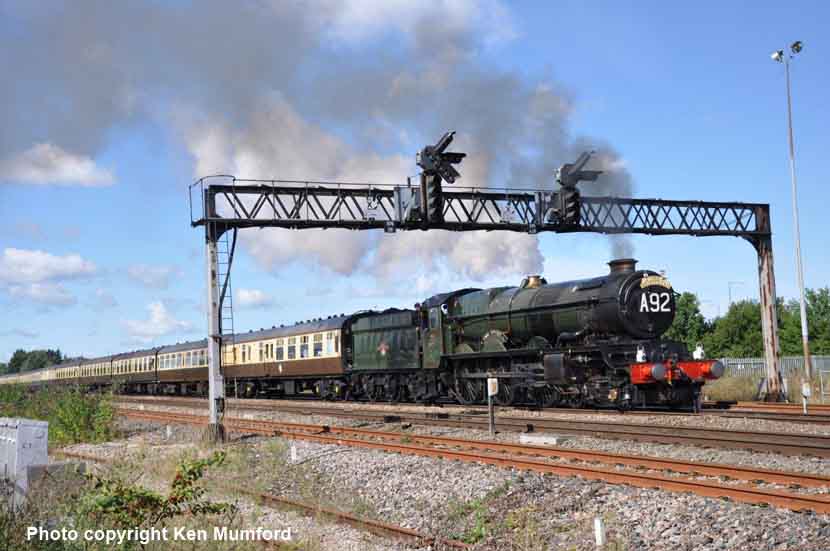
(Above-Below) Following a pathing stop at Swindon, 'King' Class No 6024 'King Edward I' accelerates past Cockleberry Sidings with London-bound 'Bristolian' on 28th August 2010. 'Castle' Class No 5043 Earl of Mount Edgcumbe heads the non-stop 'Bristolian' near Stratton Park Halt on 17th April 2010.
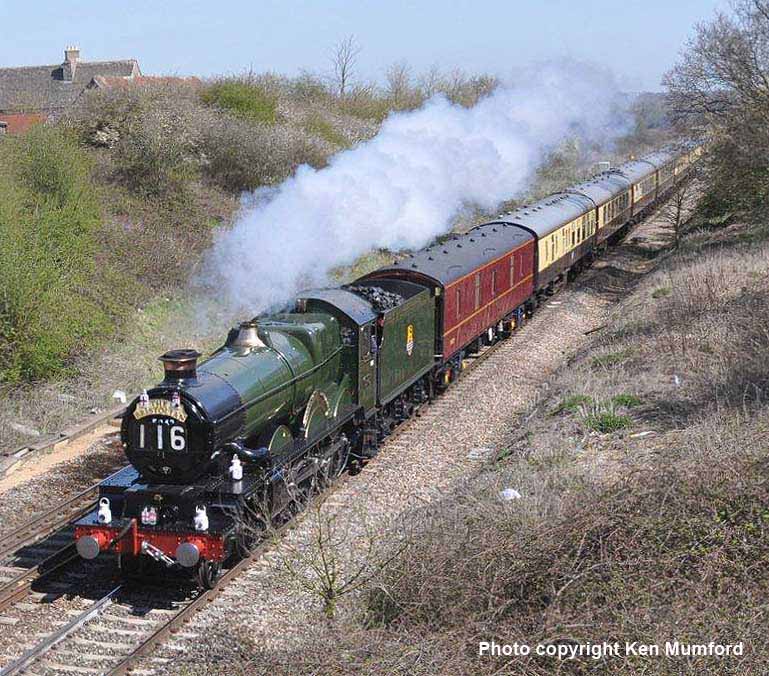
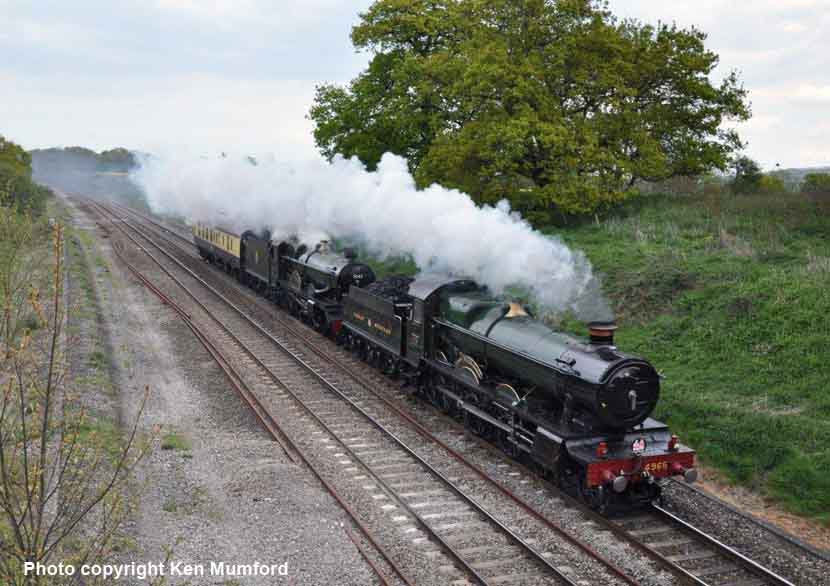
(Above-Below) 'Hall' class No 4965 Rood Ashton Hall and 5029 Nunney Castle head through Compton Beauchamp about two miles east of Shrivenham station bound for the West Somerset Railway on 14th May 2010. (Below) Heading back to London with the 'Cornish Riviera Express' charter, 'Castle' class No 5029 Nunney Castle and 'King class No 6024 King Edward 1 pass the end of the loop at Greenbridge about a mile east of Swindon station.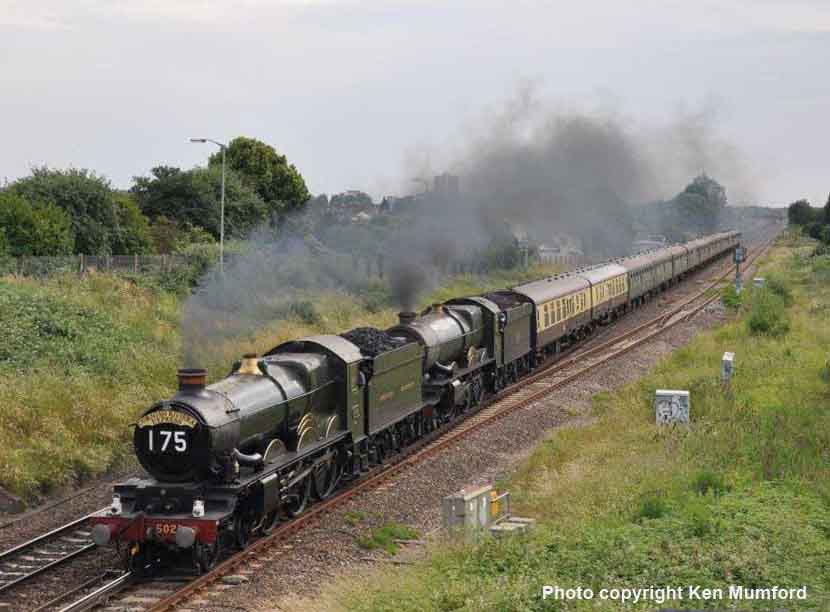
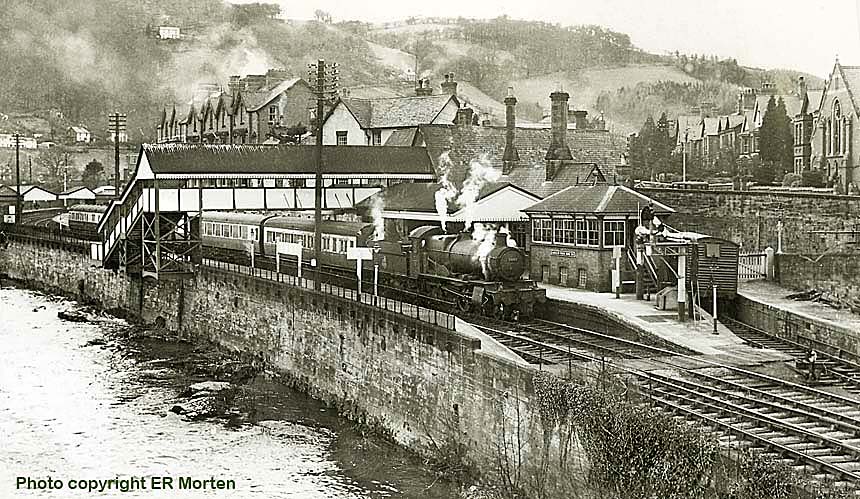
(Above-Below) By way of a change we look at some pre-preservation shots on the Western Region taken by Rail Cameraman ER Morten. Llangollen railway station became a casualty of the Beeching axe on Monday 18th January 1965. Following closure to passengers traffic, the section of line between Ruabon and Llangollen goods yard remained open for freight traffic, but immediately upon withdrawal of goods services in April 1968, the wrecking crew began lifting the whole length track between Ruabon and Barmouth. Now it has to be said that Beeching's decision to obliterate a rail access to some of the most spectacular scenery in North Wales was just another classic example of his mindless excesses! Thank goodness for the Llangollen Railway! Formed by a group of enthusiasts in 1974, their efforts to restore part of the line is a 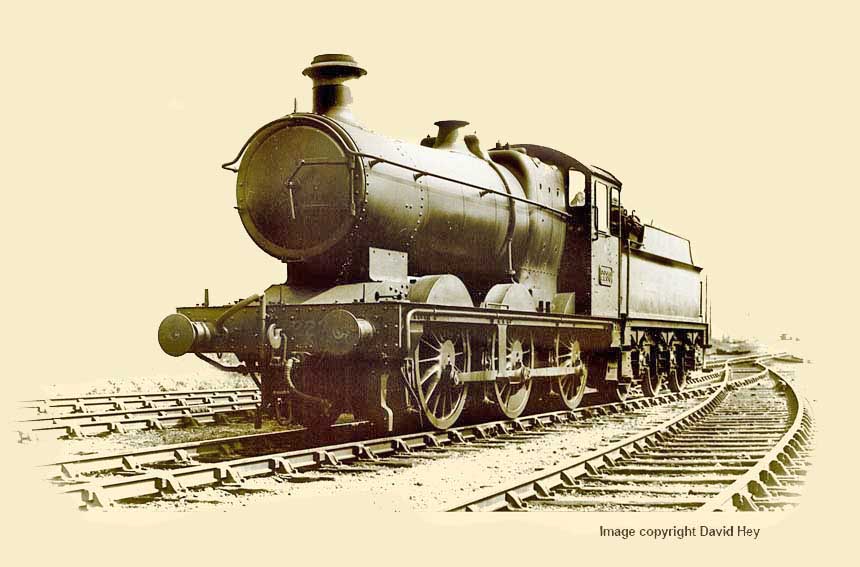 magnificent achievement. Starting at Llangollen Station on the north bank of the River Dee, the 7½ mile scenic heritage line follows the Dee Valley up to the village of Carrog, with future plans to extend the line a further 2½ miles to Corwen Town. (Above) 7800 Torquay Manor was photographed by ER Morten at Llangollen Station on 4th April 1955. No 7800 was the first of the Manors, which entered traffic in January 1938 followed by a further nineteen up to February 1939. The outbreak of war halted construction but following nationalisation of the 'Big Four', the newly-created Western Region of British Railways was authorised to build ten more Nos 7820-29 which were outshopped from Swindon in November and December 1950. No 7800 was withdrawn from traffic in August 1964 and scrapped at Cashmore's, Great Bridge. (Below) Flood damage led to passenger services at Berwyn railway station being originally suspended on 14th December 1964 only a few weeks prior to Beeching's official closure taking effect on 18th January 1965. Here CB Collett's 0-6-0PT No 5409 restarts a local train on 4th April 1955. Reopened by the Llangollen Railway in 1986 Berwyn is the first intermediate station out of Llangollen. Deeside was reached in 1990, Glyndyfrdwy in 1993 and Carrog in 1996.
magnificent achievement. Starting at Llangollen Station on the north bank of the River Dee, the 7½ mile scenic heritage line follows the Dee Valley up to the village of Carrog, with future plans to extend the line a further 2½ miles to Corwen Town. (Above) 7800 Torquay Manor was photographed by ER Morten at Llangollen Station on 4th April 1955. No 7800 was the first of the Manors, which entered traffic in January 1938 followed by a further nineteen up to February 1939. The outbreak of war halted construction but following nationalisation of the 'Big Four', the newly-created Western Region of British Railways was authorised to build ten more Nos 7820-29 which were outshopped from Swindon in November and December 1950. No 7800 was withdrawn from traffic in August 1964 and scrapped at Cashmore's, Great Bridge. (Below) Flood damage led to passenger services at Berwyn railway station being originally suspended on 14th December 1964 only a few weeks prior to Beeching's official closure taking effect on 18th January 1965. Here CB Collett's 0-6-0PT No 5409 restarts a local train on 4th April 1955. Reopened by the Llangollen Railway in 1986 Berwyn is the first intermediate station out of Llangollen. Deeside was reached in 1990, Glyndyfrdwy in 1993 and Carrog in 1996.



(Above-Inset-Below) The stunning images from the NMSI collection shows the superb quality of artwork commissioned by the 'Big Four' railway companies and later British Railways for posters across the country. The NMSI family is comprised of four award-winning museums, each with their own diverse identity: the Science Museum, the National Media Museum and, of course, the National Railway Museum (NRM) at York which houses the world's pre-eminent railway collection.
The NRM is spread across three halls: the Great Hall - formerly the steam engine shed (50A) - complete with a working turntable, while the Station Hall (previously York's central goods depot) is laid out like a 'period' railway station. The Science Museum at Swindon is a massive site housing collections ranging from the iconic Lockheed Constellation airliner to super computers, bicycles and the last Fleet Street printing press, however the NMSI's full collection is so big that only 8% of the artefacts are on public view. The rest are hidden-away at an ex-WW2 airfield just off the M4, but enthusiasts are amply compensated by the NMSI Collections Online - a superb website displaying thousands of objects, including a range of fabulous railway travel posters...a visit is highly recommended.
This link will take you to the posters featuring the railway paintings of Terence Cuneo whose career spanned more than half a century, by which time he had established himself among the highest echelons of twentieth century British art.
(Above) This superb British Railways (Western Region) poster - 'Royal Albert Bridge, Saltash' - was painted in 1959. The text reads - '1859, 1959 Centenary. Designed and Built by Isambard Kingdom Brunel.'
The loco crossing the bridge is 'Castle' class No 5021 Whittingham Castle...Robert Green has written to say that he has one of the cabside numberplates which he purchased from Swindon in 1963 for the princely sum of £7 10s 0d (£7.50) to collect from Hockley Goods Depot in Birmingham. The reason for this choice was because No 5021 was the last Castle he copped as a spotter - happy days! Sadly, he couldn't afford to buy the nameplate - they wanted a mighty £15 which was too much for his budget. What a mistake that turned out to be! Click here to visit the exellent wikipedia free encyclopedia website on Cornish viaducts. 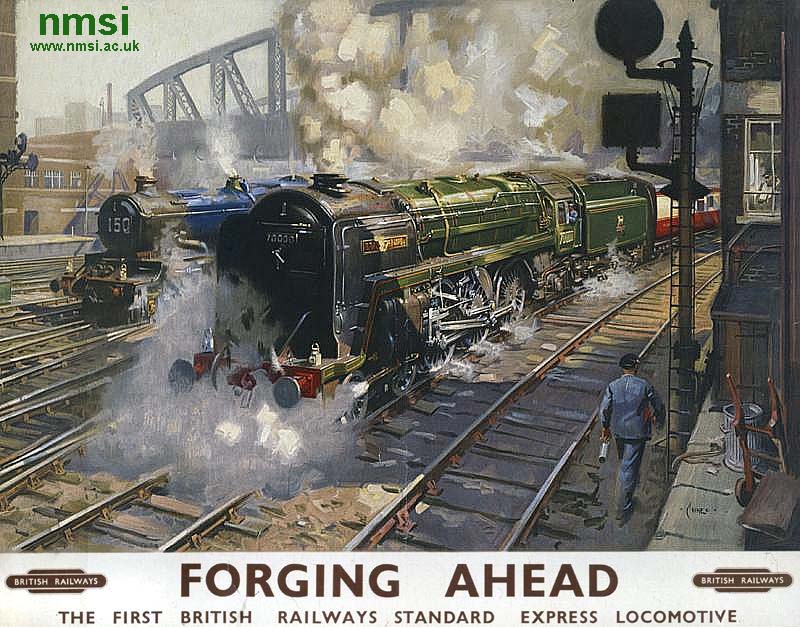 (Inset Left) This earlier British Railways poster - 'Forging Ahead. The First British Railways Standard Express Locomotive' - was painted by Terence Cuneo in 1951, and depicts BR Standard Class 7MT No 70000 'Britannia' leaving London Paddington station with an express train. In the background is a King Class locomotive in the early BR blue livery (as described at the top of the page).
(Inset Left) This earlier British Railways poster - 'Forging Ahead. The First British Railways Standard Express Locomotive' - was painted by Terence Cuneo in 1951, and depicts BR Standard Class 7MT No 70000 'Britannia' leaving London Paddington station with an express train. In the background is a King Class locomotive in the early BR blue livery (as described at the top of the page).
(Below) This British Railways poster - 'Progress' - by Terence Cuneo was published in 1957 and depicts the interior of Swindon Works during the construction of the new 'Warship' class diesel hydraulic locomotives. The illustration depicts a power unit being lowered from an overhead gantry. In the background is the 1837 Great Western Railway 2-2-2 locomotive 'North Star' mounted on a raised platform. The main text reads - 'Every week British Railways Modernisation Plan goes further ahead' while the small text beneath the illustration reads - 'Painted by Terence Cuneo for the cover of the Unilever magazine 'Progress', Winter issue 1957-8.'
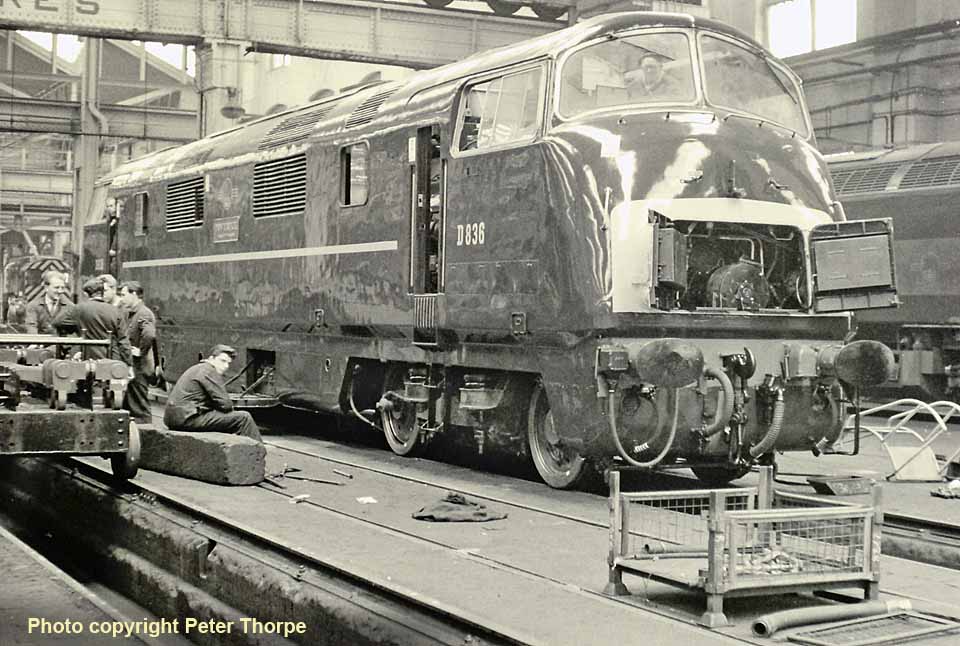
(Above) Rolling off the assembly line at the North British (NB) Glasgow Works in September 1960, Type 4 'Warship' Class No D836 Powerful was allocated initially to Plymouth Laira. Here the 2,200bhp locomotive receives attention at Swindon Works on Wednesday 28 April 1965, by which time its allocation was Newton Abbot. Withdrawal came in May 1971.
(Below) An impressive titled train headboard - 'Cambrian Coast Express - as carried by the locomotives working the through service from Paddington to Aberystwyth and Pwllheli in North Wales. The titled train was introduced by the GWR in July 1927, but withdrawn in September 1939 at the outbreak of World War Two. The Western Region of British Railways reinstated the service in July 1951. This style of headboard, incorporating the Cambrian Railways coat-of-arms, was used from the start of the 1958 summer timetable until the last titled run on 4th March 1967. 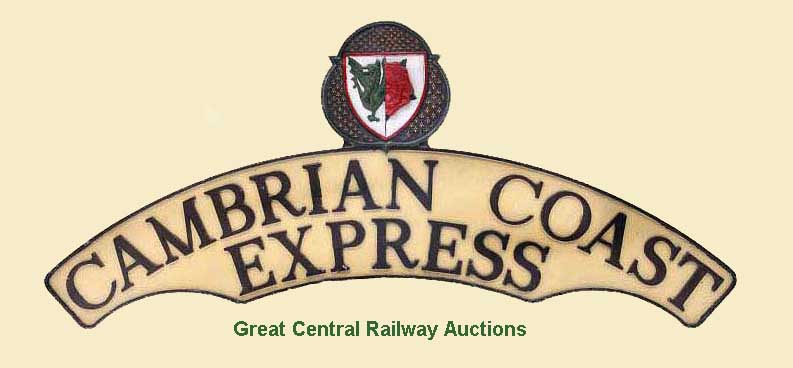
This headboard (illustrated here) was sold at Great Central Auctions for £13,600 on 16th July 2011, and of particular interest is that it was the last headboard used in service. The Lot came complete with bracket and wing nut fixings, together with a purpose-made steel bracket which, when fixed to a wall, would support the overall 52½" span of the headboard for display...a fantastic piece of railway memorabilia courtesy Great Central Railwayana Auctions. Click here to visit the GCR website.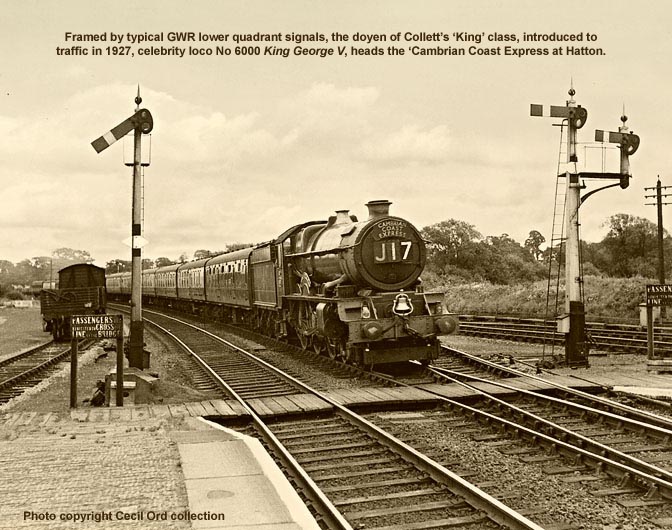
(Below) Another flamboyant WR train headboard went under the hammer at a Great Western Railwayana Auction in May 2010. Click here. The board was carried by both Worcester and Old Oak 'Castles' on 'The Cathedrals Express' between Paddington and the cathedral cities of Oxford, Worcester and Hereford. The titled train first appeared in the Western Region timetable on 16th September 1957, departing Hereford at 06.43 and returning at 18.22 from Paddington. 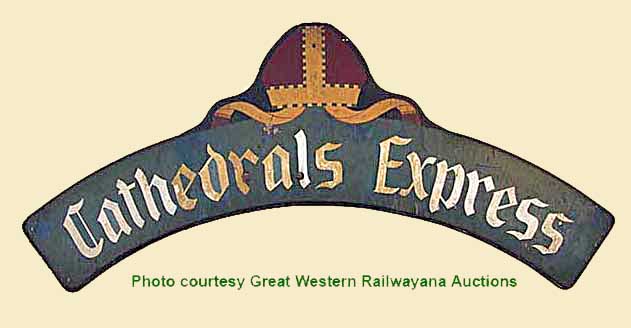
(Below) Here Castle class No 5001 Llandovery Castle arrives at Paddington with the morning train on 15th May 1962. Built in September 1926, No 5001 underwent performance tests during a brief spell in 1931 when the 'Castle's standard 6ft 8½ inch coupled wheels were substituted by smaller 6ft 6in driving wheels. A double chimney and 4 row superheater were fitted in June 1961, but with the introduction of Type 4 diesel-hydraulics gathering pace the loco was one of several ousted from traffic on the Western Region in 1963. No 5001 was withdrawn from Old Oak Common in February 1963 and scrapped at Cashmore's, Great Bridge.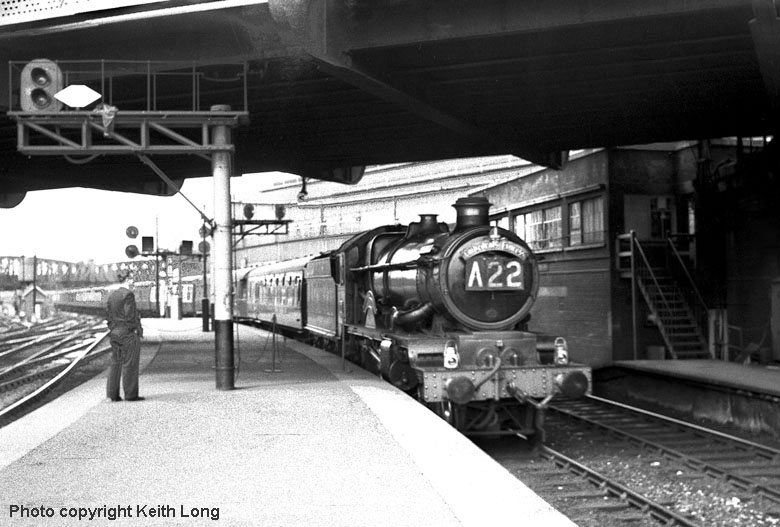
(Below) I am constantly on the look out for good sites to link with and improve the contents of this site, so my thanks to John T of Taunton for recommending the excellent 'mikes. railhistory.railfan.net' website. The page on the 'Cornish Riviera' is a gem! Click on photo (below) to visit the page.
(Above-Below) The deplorable state of BR's locos in the final years of steam is illustrated in these shots; indeed when visiting engine sheds it was difficult to distinguish between those engines that were working and those that had been condemned! Surpus to requirements, 'Castle' class 5029 Nunney Castle, one of the two Castles with a straight sided Hawksworth tender, awaits its fate at Woodham Brothers Barry scrapyard on 13th August 1966. Outshopped from Swindon on 28 May 1934, No 5029 was initially allocated to Old Oak Common MPD where it spent most of its working life. The loco moved to Worcester in 1958, followed by spells at Newton Abbot and Laira before a final transfer to Cardiff East Dock, from where it was withdrawn in December 1963. The following year the locomotive was sold for scrap to Woodham Brothers where it languished for 12 years until being rescued in May 1976; it was the last loco to leave the Barry scrapyard by rail. (Below) Not long to go, but a willing workhorse to the very end...Hall class (minus its 7925 smokebox numberplate and Westol Hall nameplates) was photographed at Oxford on 13th November 1965.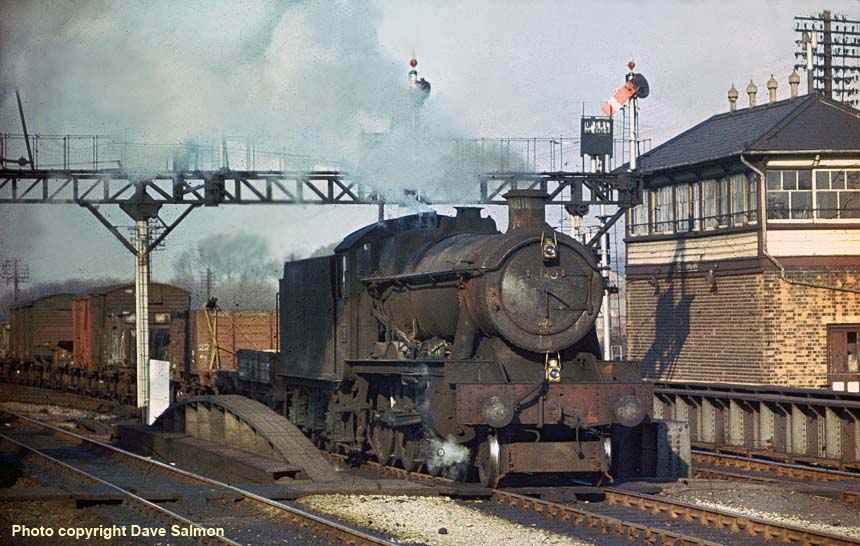
(Below) Sporting a Reading (81D) shedplate on the smokebox door, Collett's 0-6-0 Class 3MT No 2208 makes a spirited start with a heavy engineers train through the junction at Reading West Station on 2nd September 1951.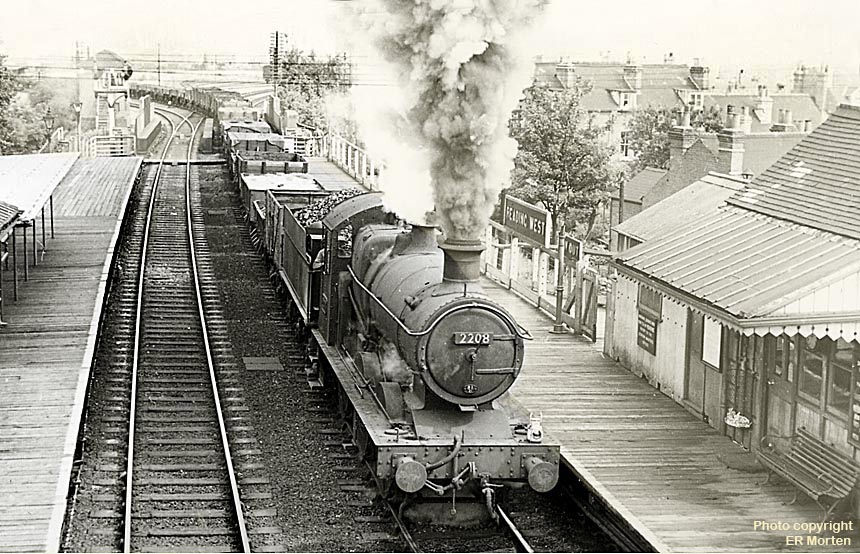
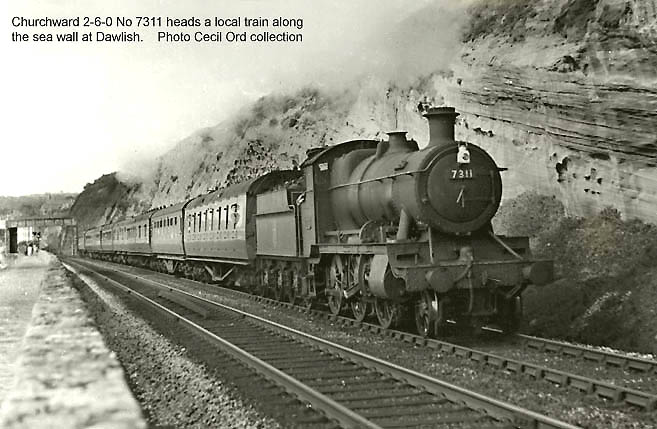
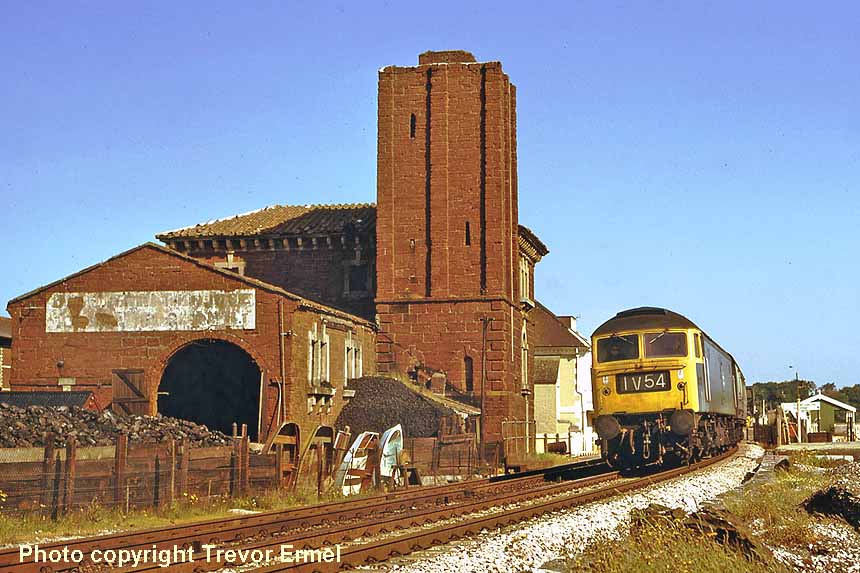
(Above) BR's Rail Blue era on the WR is featured on Trevor Ermel's excellent 'Rail Cameraman 2' Page 70 HERE. He writes - 'South of Exeter the railway skirts the wide estuary of the River Exe past Starcross then hugs the coast round to Teignmouth via Dawlish, a beautiful stretch of line much-photographed over the years. At Starcross a building originally constructed to house one of the pumping stations for Brunel's original 'atmospheric railway' still stands, seen on the left as Class 47 47030 passes the station with a westbound express. The building is now open as a museum, with various items from the atmospheric line - not one of Brunel's successes, it must be said...'
SNAPSHOTS OF MY MIND
Ian G remembers...a week at Starcross
It is late autumn 1955; there is sense of approaching winter as a keen east wind is whipping the water against the pier timbers. I am a young man standing on a railway platform at Starcross station on the mainline between Exeter and Plymouth in the West of England. It is a time of Elvis Presley, Rock 'n' Roll and the Cold War. For me personally, it is a time of excessive energy and of youthful optimism in a resurgent post-war Britain. In  short, for me, it is a great time to be alive.
short, for me, it is a great time to be alive.
My job was a Booking Clerk on the railway, and I had been directed to the station as a temporary replacement for another young man who had been called up for his National Service. My duration of stay was for one week until a more permanent arrangement could take place.
It was a typical wayside country station, the tranquil days being past with long periods of quiet inactivity, occasionally interrupted by sudden bursts of movement on the main line or a local stopping train meandering its way to and from the county town of Exeter. In those quieter moments I whiled away my time out on the platform observing the railway scene; Starcross was an interesting place, the station was right up alongside the estuary of the river Exe and the down platform (west facing) was supported by timber piles with a series of wooden steps to form the jetty for the Exmouth ferry to tie alongside. Starcross was  an excellent place to obtain fishing bait in the form of peeler crabs on the mud-flats at low tide. Whilst there I made an acquaintance with a professional 'bait man' who for a short time used to send me bait down on the train for a small sum after I returned to my job at Kingswear station...see footnote. With hindsight, I suspect these moments at Starcross would have been shared by enjoying a 'Player's' cigarette.
an excellent place to obtain fishing bait in the form of peeler crabs on the mud-flats at low tide. Whilst there I made an acquaintance with a professional 'bait man' who for a short time used to send me bait down on the train for a small sum after I returned to my job at Kingswear station...see footnote. With hindsight, I suspect these moments at Starcross would have been shared by enjoying a 'Player's' cigarette.
One day, whilst in such a mode, I casually noticed in the distance a muffled rumbling and a billowing of smoke snatched away sideways by a brisk east wind heralding the approach of a steam hauled non-stop express bound for London. I recognised the locomotive as a former Great Western Railway 'King' class, resplendent in glistening green, burnished copper and polished brass, hauling a rake of more than a dozen fully laden coaches carrying hundreds of passengers. Heavily loaded, the engine was in full stride straining hard in the collar, as the carriages sped by I became aware that each set of windows were occupied by faces pressed hard against the window, eagerly scanning the estuary and open English countryside; it took a little while before I realised that all the faces were black. With the red tail lamp receding only wisps of white smoke accompanied me as the station returned to its tranquil self.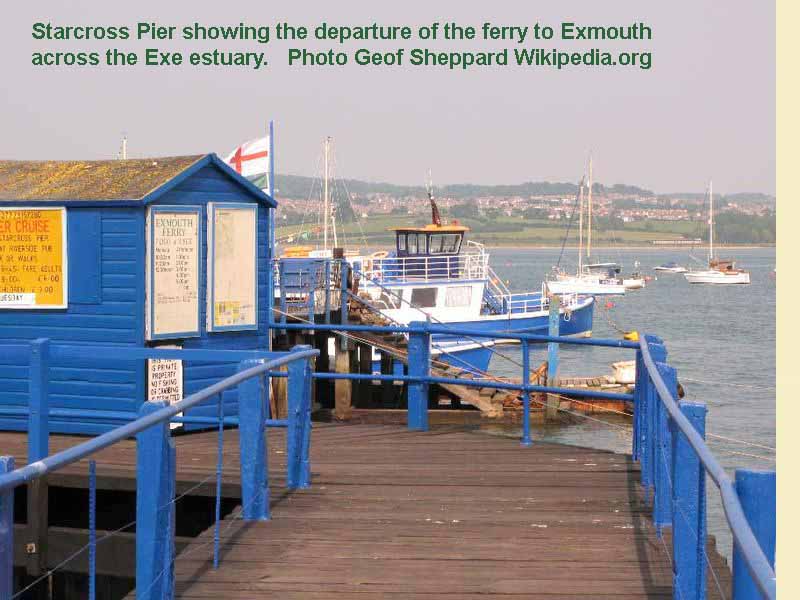 Again, with hindsight, I guessed the train was a special boat train from Plymouth to London and the passengers were immigrants arriving from the West Indies; they were answering the government's call to do the jobs the British would not do.
Again, with hindsight, I guessed the train was a special boat train from Plymouth to London and the passengers were immigrants arriving from the West Indies; they were answering the government's call to do the jobs the British would not do.
I had been aware of the government's invite to former colony workers to come to England to supplement the labour force, but this was the first time I had witnessed reality in action. I asked myself where all these people were going to live? Who would meet them at the station? Who would look after their needs? How would they find a job? I considered these questions and many more in my young mind; I marvelled at the organisation and planning that had gotten them thus far; little did I know I was witnessing the embryo efforts of Britain's fledgling mass immigration programme.
All this happened a long time ago, but the memory of that day has never left me, the rest as they say is history. Oddly, the story for me did not end there, if I may indulge a little longer, I would like to tell you the sequel to this tale.
Twelve months later, I too marched off to serve my two years National Service in the Royal Air Force. One day in 1957, when half way through my service at RAF Stafford in the Midlands, I was sauntering away from the station cookhouse after a midday meal when I fell in step with a stranger among many strangers, for it 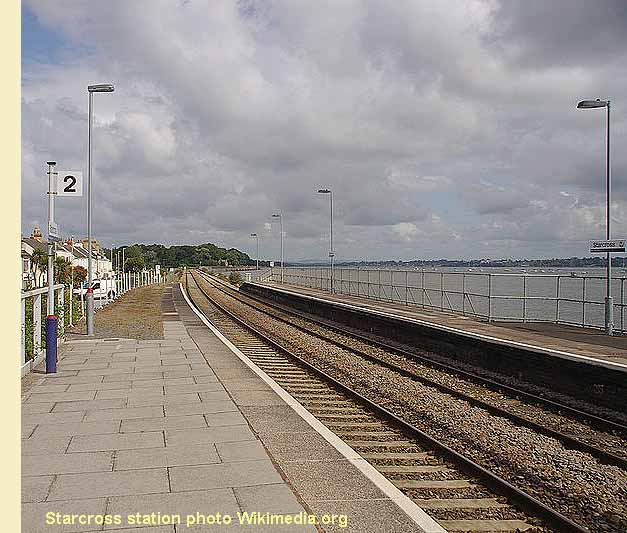 was a large camp. We engaged in conversation, (as you do) the usual stuff: where do you come from and what was your job? Well, slowly but surely after a little while, it dawned on both of us that our answers were corresponding most uncannily, and both realised in a way we had met before, for I was talking to the guy whose job I had relieved for a week at the railway booking office at Starcross some two years earlier. We both had a good laugh.
was a large camp. We engaged in conversation, (as you do) the usual stuff: where do you come from and what was your job? Well, slowly but surely after a little while, it dawned on both of us that our answers were corresponding most uncannily, and both realised in a way we had met before, for I was talking to the guy whose job I had relieved for a week at the railway booking office at Starcross some two years earlier. We both had a good laugh.
We continued walking and he told me he was stationed at RAF Lichfield which was about ten miles away and had only come over to Stafford for the day. His job was MT (Motor Transport) so I asked him if he knew a Bob Mitchelmore from Dartmouth (I already knew that Bob was stationed at Lichfield).
He was taken aback and fished out from his back pocket a set of irons (knife, fork and spoon-carried at all times) and proffering them to me he said, 'Do you know who these belonged to?'
Looking suitably puzzled I replied, 'No, whose are they?'
He then went on to tell me he had lost his own irons (probably stolen) so Bob Mitchelmore gave him his as he was leaving the RAF after completing his length of service.
My stranger, (whose name I have now forgotten) and I parted company agreeing it was a small world; he told me he himself would soon be going home to Starcross and his old job on the railway, as he too was about to finish. I never saw or heard of him again...
FOOTNOTE Ian's memories of Kingswear station are featured on the next page. Link at bottom of this page.
(Above) The Western Region's Rail Blue era is epitomised here in Trevor Ermel's photo of Class 52 1036 Western Emperor sweeping through Starcross at the head of a 'down' express on 1st June 1975. By this time the BRB's Corporate Identity Scheme is well established; the maroon 'Western' class locomotives now sporting an all-over blue livery with full yellow ends and the 'D' prefix has been blacked-out.
(Below) As for the changeover to WR dmu services? With the rank and file of steam classes in rapid decline, it became increasingly difficult for the operating department to find a suitable steam locomotive with a power classification relative to its train formation; either being too heavy or too light for the purpose. The diesel multiple units offered a practical solution to this problem as the engines of several railcars could be coupled together to meet varying traffic needs, therefore the power available became proportional to the length of the train. In the case of the Swindon-built Class 126s, however, pragmatism - rather than aesthetics - was the main item on the agenda, for the 70mph Inter-city units were not the best looking vehicles. Powered by two AEC 150hp engines, the 3-car sets had two front ends - a full-width cab and a half-cab incorporating a central gangway connection which allowed through access within a 6-car set. Prior to commencing service in Scotland, the first six 3-car sets were introduced on the WR's Birmingham-Cardiff-Swansea service in June 1957, the usual formation being comprised of six cars with the two gangwayed trailers coupled together in the centre of the train. Sporting a 'V' chevron on the front-end, a 3-car set arrives at Gloucester. Photo © EA Wood Collection. 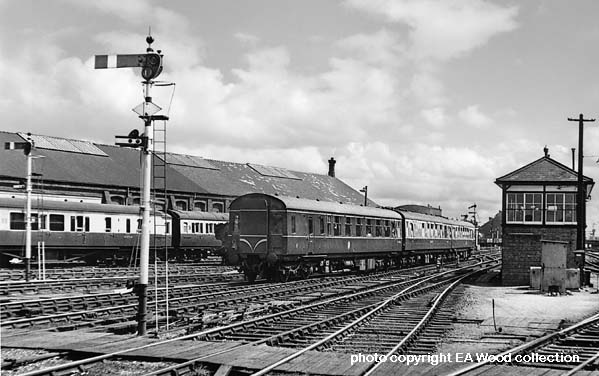
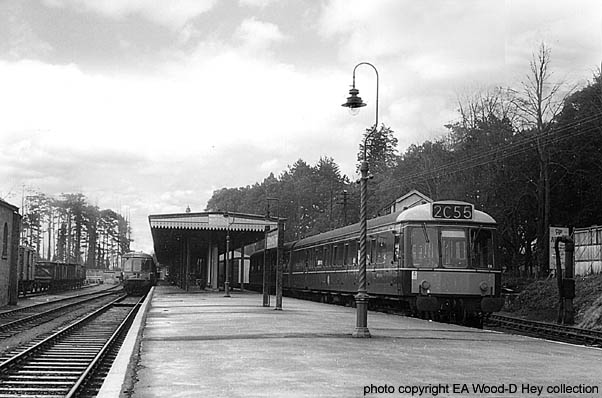
(Above) Despite the economies the new dmus brought, many branch line closures could not be prevented. This included the former LSW's Sidmouth branch on the Devon coast which was dieselised in November 1963, but succumbed to the Beeching axe in March 1967. Here a pair of Derby Class 108 dmus occupy the single platform - the one on the left retains its 2-character train description panel beneath the driving cab windows and a small destination panel in the cab roof, whilst the newer vehicle from 1960 onwards (right) has been modified with a 4-panel route indicator box moulded as an integral part of the roof canopy and the destination panel relocated aboye the central cab window. Here the 4-character train description blind displays 2C55, as a 2-car unit - sporting a white cab roof - awaits departure in May 1964. Photo © EA Wood collection.
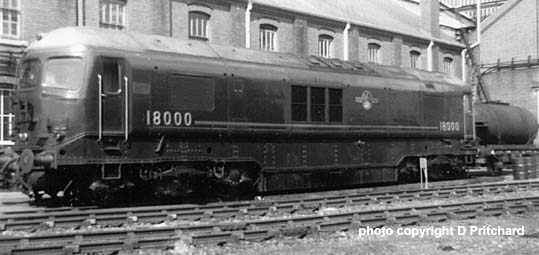
(Above-Below) Although committed to replacing steam with diesel and electric power, the British Transport Commission continued to show a keen interest in developing any type of new motive power which showed promise of economies in rail operation, including the conversion of a number of steam locomotives to oil firing. Meanwhile, the GWR had begun experiments in conjunction with the Swiss firm of Brown Boveri to build a gas-turbine electric locomotive capable of producing the equivalent power of a 'King' class locomotive. In fact, the GWR gas turbine did demonstrate its ability to produce a power well beyond any steam locomotive then operating on the Western Region, but the BTC took the decision to abandon all forms of main line traction other than steam and the interesting gas-turbine experiment came to an end. The Brown Boveri A1A-A1A gas-turbine No 18000 is seen at Swindon. (Below) North British Type 3 B-Bs Nos D6321-18 have just backed onto the 'Cornishman' coaching stock at Plymouth...please note, to maximise webspace the WR Hydraulic Class diesels have been moved to another page. Click on Colour Photo-link at the bottom of the page.
Some of the original steam loco photos featured on this page were provided by 'Through their eyes2.co.uk' and are available on a DVD containing 2,800 high resolution scans produced from original negatives, slides and photos. Click here for link to this interesting site. I am not affiliated in any way with the sale of DVD's.
Polite notice: All text and photographs are protected by copyright and reproduction is prohibited without the prior consent of the © owners. If you wish to discuss using the contents of this page the email address is below. Please note - this is not a 'clickable mail-to link via Outlook Express:
dheycollection@ntlworld.com


